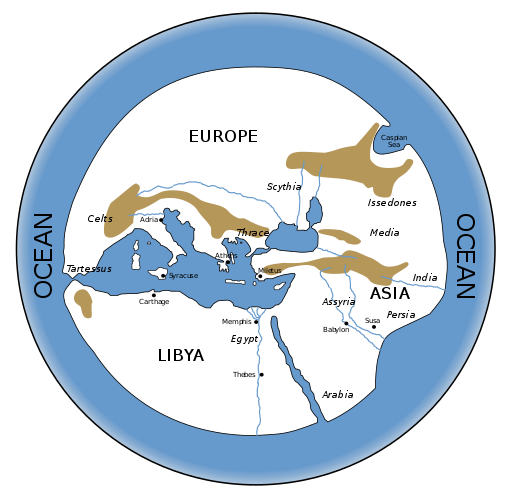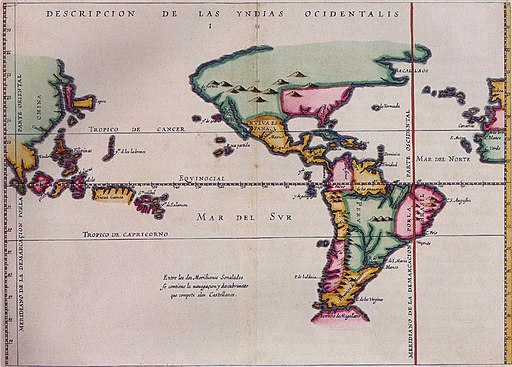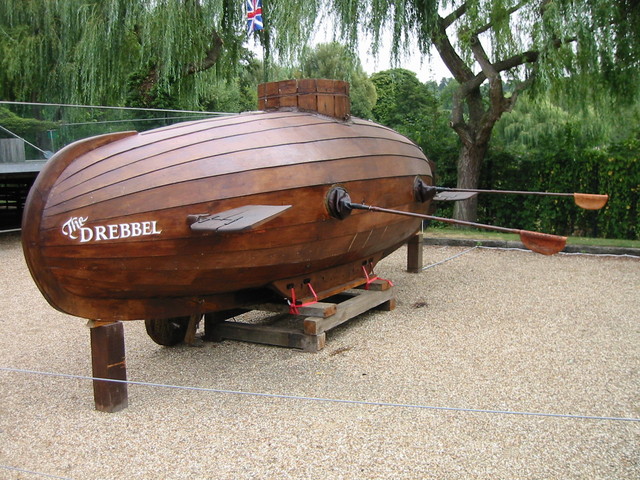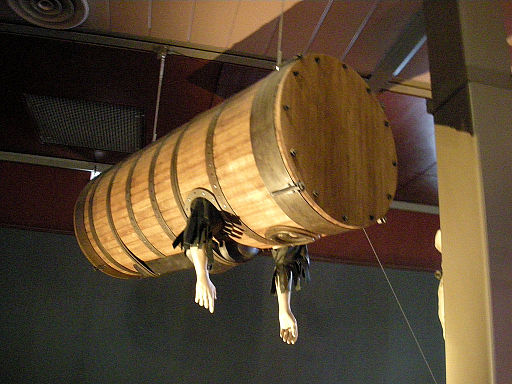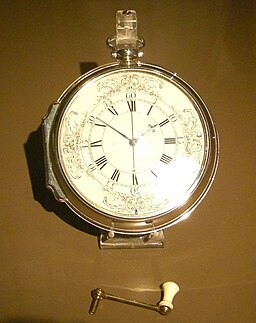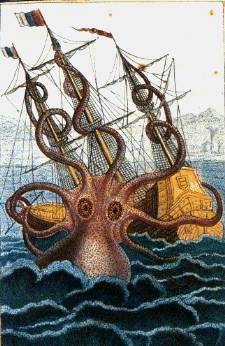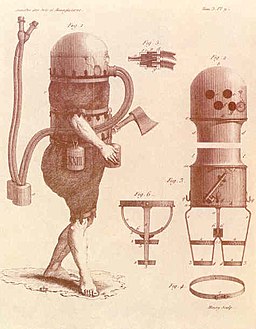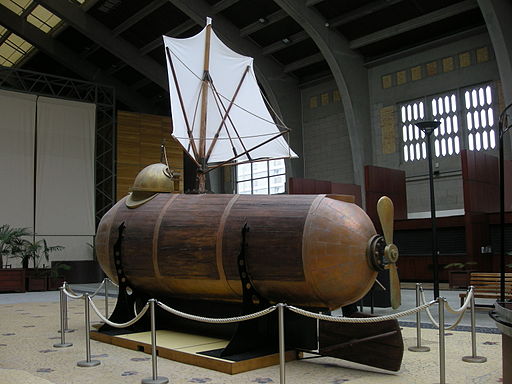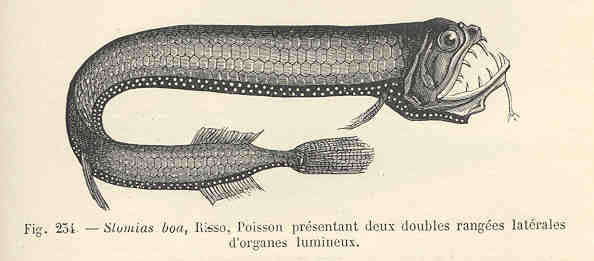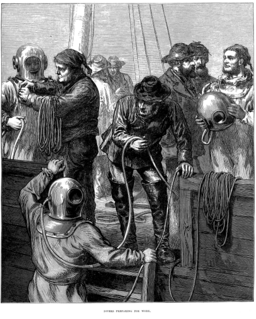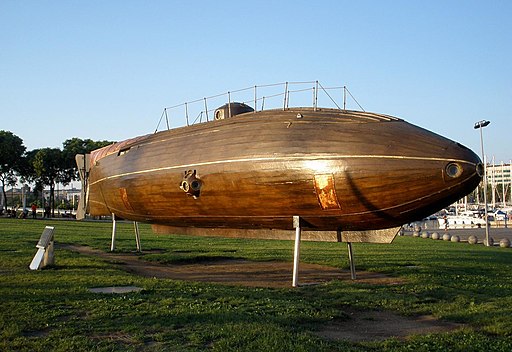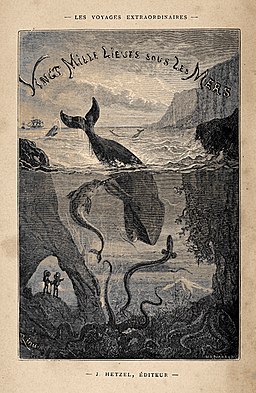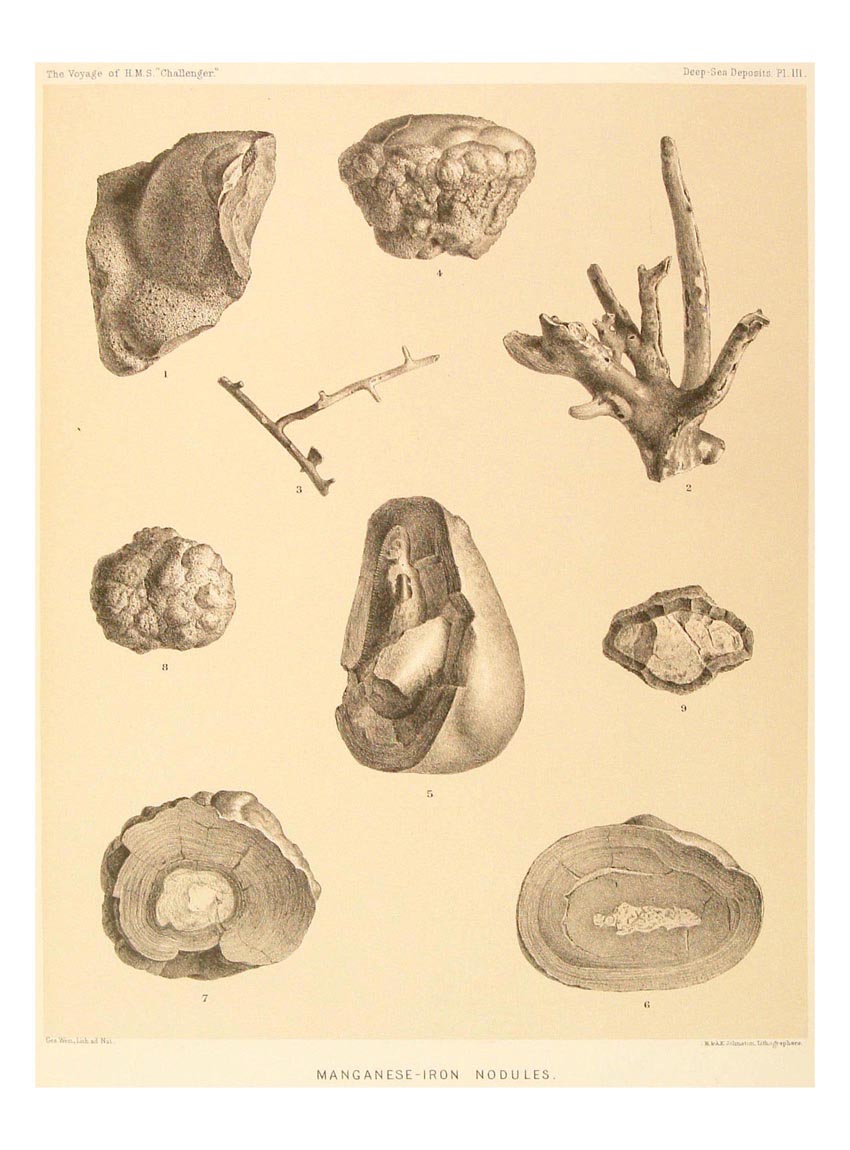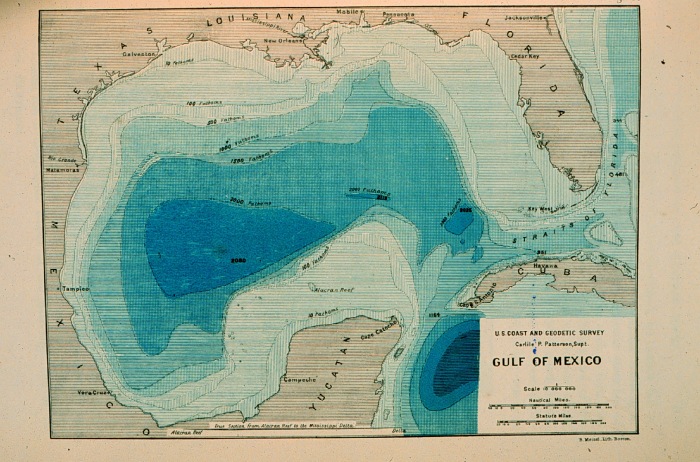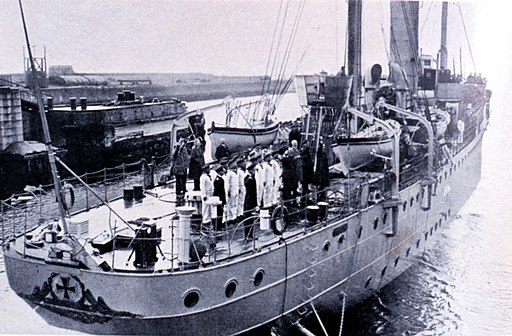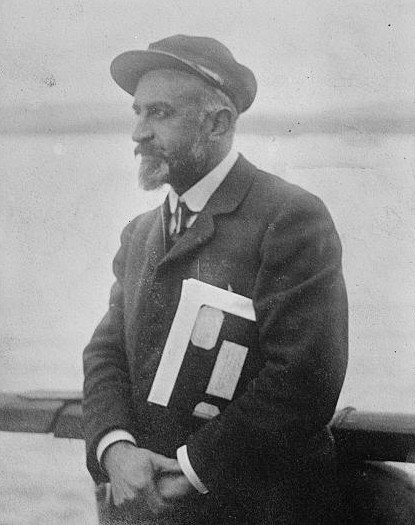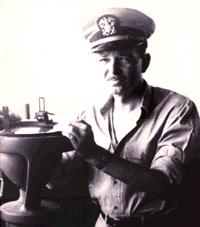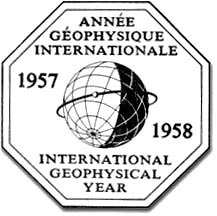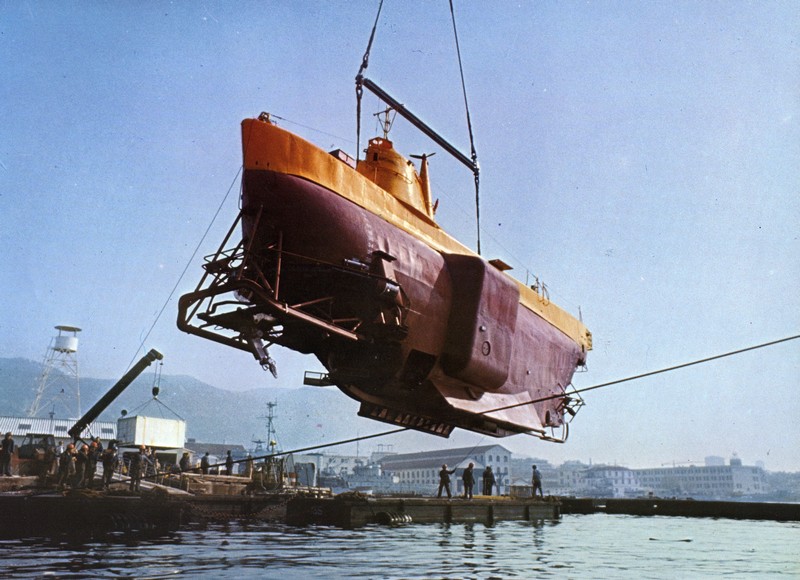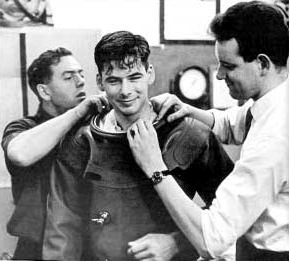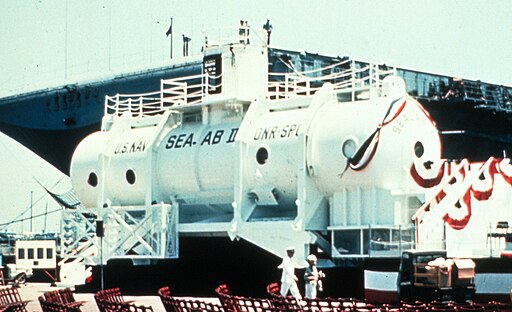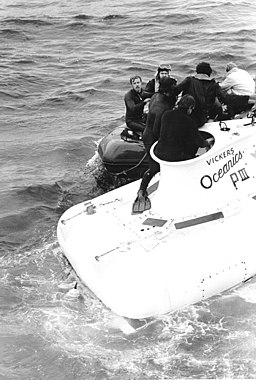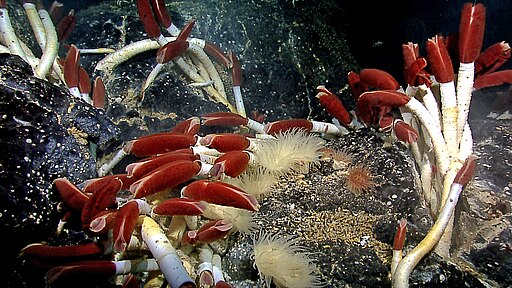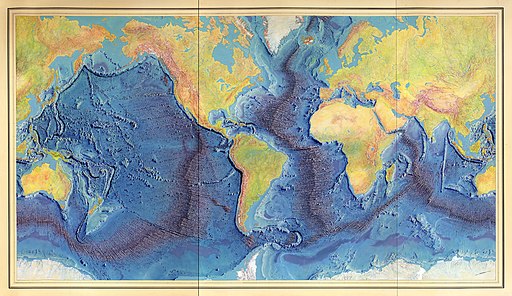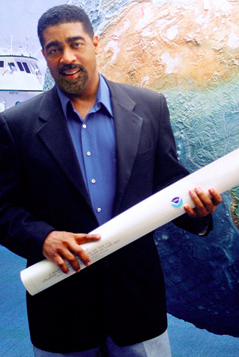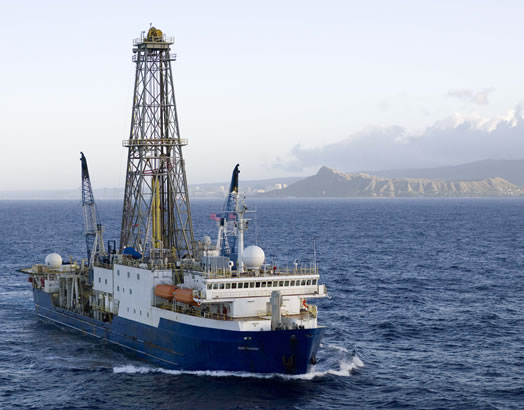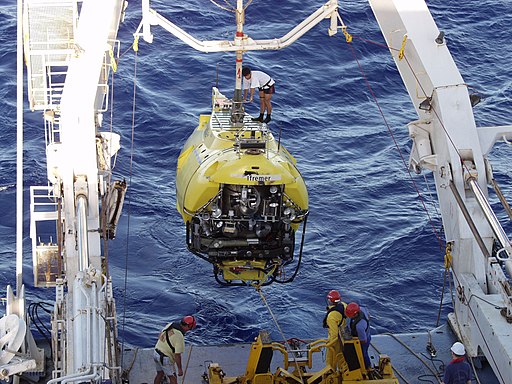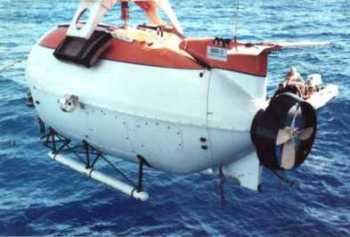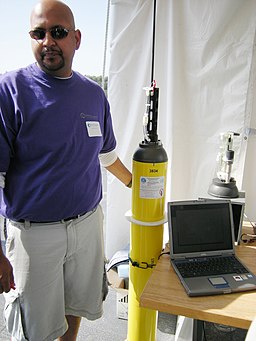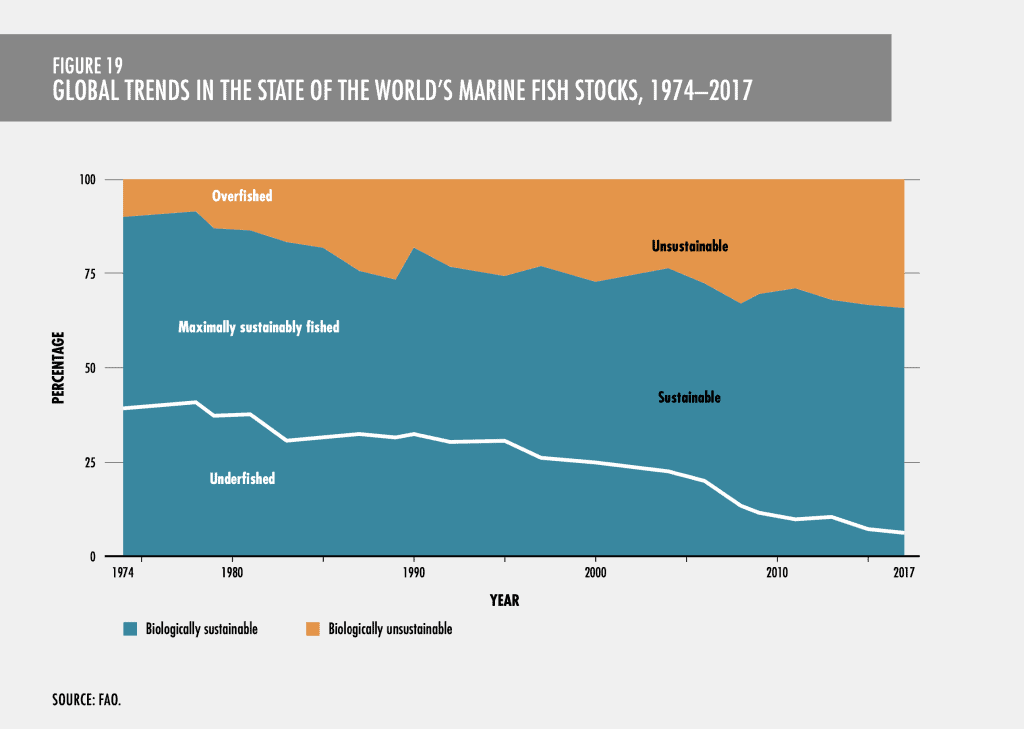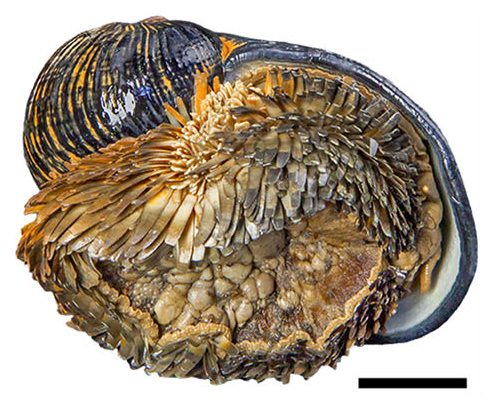A Not-So-Brief History Of Exploring The Deep Ocean
"The problem with history," someone once wrote, "is that there is so much of it". Pull at one thread, and it starts to unravel further and further back, often revealing more threads to pick at, and showing how the threads weave together. I began putting together a timeline of events in the history of exploring the deep ocean for the Monsters Of The Deep exhibition at the National Maritime Museum, and this has grown from there.
What follows below is a chronology of events, not a definitive history - I'm not a historian, just someone interested in the history of their field - and the events that it includes are inevitably eclectic personal choices. But I have tried to pursue some threads, such as discoveries in deep-sea biology, developments in diving technology, and how they are intertwined with the deep ocean in popular culture, for example.
The timeline is loosely divided into four parts to make it easier to digest, and there are perhaps some themes in individual centuries and decades, so I have divided it up further into those smaller sections. Overall, the timeline is like a zoetrope animation rather than a smooth HD movie, but I hope it traces some of the whens, hows, whos, and whys of ocean exploration.
I have tagged events with symbols to indicate threads that they represent, so that a reader for example interested in the history of deep-sea biology can just skim through from biology symbol to biology symbol. (If you copy one of the symbols from the key below into the "Find" function of your web browser, you can jump between entries tagged with that symbol).
The second half of the 20th century onwards is admittedly quite cluttered, with so much development taking place on many different fronts. One suggestion for a way into it is to take the year of your birth and see what was going on in ocean exploration at that time, then look at what has happened in your lifetime - and pick up any threads that interest you to trace further back from that.
Some of the events in recent decades are also ones in which I was involved, not to claim any significance for them, but as examples of how we are still making plenty of discoveries. There is more going on in exploring the ocean at the moment than any other time in history, and browsing through some of the highlights of deep-sea exploration should give pause for thought about the often-repeated hyperbole that "we know more about [somewhere else in the Solar System] than the deep ocean".
I'm not currently extending the timeline with events from 2020 onwards, but I still occasionally update it with further information about the periods that it covers, if I find new threads or links to add. And if you're interested by this sketch of humanity's journey into the deep, you might also like to check out the website of the International Commission of the History of Oceanography.
👤 People & human achievements 🦑 Deep-sea species & habitats
🌎 Mapping the oceans ⚓ Voyages of discovery
🔧 Deep-diving technology 📣 Communication & culture
🏛️ Institutions ⚖️ Laws for the ocean
A long time ago... | Ancient Times | 1st Millennium CE
1800s part 1 | 1800s part 2 | 1800s part 3 | Early 1900s
1930s | 1940s | 1950s | 1960s | 1970s | 1980s | 1990s | 2000s | 2010s
⛏ Deep-sea mining
Part 1: The Ancient World
Part 2: Age Of Empires
Part 3: Birth Of Oceanography
Part 4: Into The Deep
👤 Around 180,000 years ago: Paleolithic Neanderthals used seagrass as bedding, as shown by shells of tiny seagrass-associated snails at cave sites in France.
There's also evidence of Neanderthals harvesting seagrass-associated scallops around 120,000 years ago, as discussed in this article.
⚓ At least 40,000 years ago - and possibly more than 65,000 years ago - humans reached the continent of Sahul, which consisted of what is now Australia, New Guinea, Tasmania, and the shallow sea between them.
Sea level was lower back then, but getting to Sahul would have involved a significant sea-crossing, so we have been a sea-faring species since this time at least.
What lies beneath the seas that we have been crossing for all those millennia, however, took longer to reach...
👤 Around 32,000 years ago: people in Western Australia collected seashells and drilled holes in them to create some of the oldest known jewellery in the world (found in the Mandu Mandu Creek rockshelter and curated in the Western Australia Museum).
⚓ Around 30,000 years ago, Late Pleistocene people migrated to the South Ryukyu Islands of southwestern Japan. Reaching these islands required crossing the Pacific Ocean's strong Kuroshio Current, but an experimental voyage with a dugout canoe in 2019 demonstrated it was possible, confirmed by a study modelling the ocean current at the time and the strategies that early seafarers may have used.
👤 Around 15,000 years ago: evidence of a coastal economy around the Bay of Biscay, thousands of years before the Neolithic Agricultural Revolution, with trade involving whale-bone weapons found at inland pre-historic sites.
Stone Age humans in Europe made, swapped, and carried whale bone weapons along long-distance networks from Spain through to France.@rakemeny @UTJeanJaures @sciencedirect @SPF_Infos @umr5608_traces @DurUniArchSoc @UniBarcelona https://t.co/vzDydz38Tc
— Hakai Magazine (@hakaimagazine) May 17, 2021
👤 Around 12,000 years ago: settlers on Isla Cedros off the coast of modern Baja California harvested seagrass and milled its seeds into flour for baking.
⚓ 👤 Around 8500 years ago: Mesolithic hunter-gatherers completed sea voyages of at least 100 km to arrive on the Mediterranean island of Malta (around 1000 years before Neolithic farmers arrived there). Without agriculture and with few animals to hunt on such small islands, they relied on the sea to sustain them.
🌎 Anaximander (~610-546 BCE) created one of the first maps of his known world, with a broadly recognisable Mediterranean Sea at its centre, and an outer ocean surrounding all the land masses. The map was refined further by Hecataeus of Miletus (~550-476 BCE), whose map is even more recognisable in its Mediterranean coastline:
⚓ ~600 BCE: In his History, Herodotus (~484-425 BCE) recorded that the Egyptian ruler Necho II sent an expedition to circumnavigate Africa, clockwise from the Red Sea to the Straits of Gibraltar. The expedition was led by Phoenician sailors and took more than two years to complete. During the southern part of it, the sailors were puzzled because the track of the Sun appeared to the north of them - they had travelled into the southern hemisphere.
It was more than 2000 years later that Europeans rounded the Cape of Good Hope in the other direction (Bartolomeu Dias in 1488).
🦑 📣 5th or 4th century BCE: The Chinese text Han Nei Shih Chou Chi ("Record of the Ten Sea Islands") describes bioluminescence in the ocean, noting that "one may see fiery sparks when the water is stirred".
Ferris Jabr's feature article in Hakai magazine has more about the history of bioluminescence here.
👤 480 BCE: In his Description of Greece (Book 10), geographer Pausanias (~110-180 CE) recorded the story of Scyllias and his daughter Hydna, both accomplished breath-hold divers, who sabotaged the anchored Persian fleet of Xerxes I before the battle of Artemisium in the summer of 480 BCE. Pausanias reported that there were statues of the pair at Delphi (later removed by Nero to Rome) celebrating their achievement.
(Herodotus also mentions Scyllias at Artemisium in his History, though telling a slightly different story).
Hydna, also known as Cyana, is one of the earliest recorded female divers, and the French deep-diving submersible Cyana was named after her in the 20th century.
🔧 According to Thucydides in his History of the Pellopennesian War, the Athenians employed divers to tackle underwater obstacles protecting the harbour of Syracuse in 414 BCE.
🔧 📣 Aristotle (384-322 BCE) - or perhaps another member of his school - discussed the problems of pressure encountered by breath-hold divers, such as perforated ear-drums, in the Problemata.
The same work (Book XXXII) also mentions the practice of lowering an upended cauldron of air for divers to breathe from underwater.
🔧 332 BCE: Alexander the Great is reported to have dived in a "Colimpha" - "a little boat with divers in the rear" and "windows of crystal" - during the siege of Tyre. One of the earliest traceable accounts of it is attributed to Jerome (4th century CE, i.e. more than 600 years after the event), and De Mirabili (13th century CE, attributed to Roger Bacon) also mentions it.
⚓ ~330 BCE: Pytheas of Massilia (Marseille) sailed from the Mediterranean to the British Isles, and further north towards the Arctic, encountering sea ice. Unfortunately his account of the voyage - "On the Ocean" - has not survived, but later writers quoted from it.
🌎 June c.240 BCE: Eratosthenes - chief librarian of the Library of Alexandria - estimated the circumference of the Earth:
By dividing the circumference into 60 equal angular measures, Eratosthenes then developed a system of meridians for longitude on a world map. Hipparchus (~190-120 BCE) subsequently adopted the 360-degree divisions used by the Babylonians - and proposed that time could be used to measure longitude.
🌎 Posidonius (~135-51 BCE) wrote "About the ocean and the adjacent areas"; although none of his works survive, fragments are referred to by others. According to Strabo (~64 BCE - 24 CE), Posidonius reported that the depth of the sea near Sardinia had been measured to more than 1800 metres by lowering a weighted line. Posidonius is also reported to have hypothesised that the tides were caused by the Moon stirring the winds, which in turn stir the sea.
(Incidentally, for this section: Anaximander, Hecataeus, Aristotle, Alexander the Great, Eratosthenes, Hipparchus and Posidonius all have lunar craters named after them).
🦑 📣 77-79: In his Naturalis Historia, Pliny the Elder gave a second-hand account of an enormous squid-like animal emerging from the sea to raid fish-pickling ponds on the Atlantic coast of what is now Spain. Its head was "as big as a cask and held ninety gallons" and it had tentacles "which one could hardly clasp round with both one's arms, knotted like clubs, 30 feet long, with suckers or cups like basins holding three gallons". The guards of the ponds reportedly fought it with tridents (whether a dead Architeuthis washed up on the shore as specimens have done, and local fishpond guards presented it to their boss, claiming to have battled with it in the hope of reward, is another matter).
Also in the Naturalis Historia, Pliny listed "the names of all the animals that exist in the sea, one hundred and seventy-six in number" and boldly declared "By Hercules! in the sea and in the ocean, vast as it is, there exists nothing that is unknown to us".
🔧 📣 176-180: Oppian wrote the Halieutica, a five-book didactic poem about fish and fishing (and here's a translation by John Jones, published in 1722). The final book described the equipment and techniques of a sponge diver in detail.
Oppian mentioned sponge divers filling their cheeks with a glowing juice or oil, which they then spat out at depth to create a faintly glowing cloud to help them see in their dim surroundings - possibly the first "dive light" for underwater illumination. The oily juice that Oppian mentions might have been the bioluminescent secretions of piddocks, which Pliny mentioned in his Naturalis Historia.
👤 ~434: Early record of pearl diving on the Korean island of Jeju; men and women dived together until that practice was banned in the 17th century, and women took over diving for seafood as haenyeo ("sea women").
⚓ ~650: Polynesian explorer Hui-Te-Rangiora left Rarotonga (one of what were later named the Cook Islands by Europeans) for Aotearoa (later named New Zealand by Europeans), but ended up travelling far to the south until he and his crew encountered "a white land that was floating", describing the sea ice and icebergs of the Antarctic.
👤 ~759: The Man'yōshū ("Collection of Ten Thousand Leaves"), an anthology of Japanese poetry, included reference to the ama, who are predominantly women and traditionally dived for seafood.
The practices of the ama may have begun centuries earlier, as they are also mentioned in the Gishi Wajinden, a Chinese chronicle of Japan published in the 3rd century. By the end of the 19th century, ama became renowned as pearl divers, following the development of cultured pearls.
⚓ ~850: Tamarereti (Reti) led a research expedition from Aotearoa in the ocean-going canoe Te Itua a Maalin to investigate the source of the aurora australis known to tohunga (Māori sages). Reti did not survive the journey, but those who did reported reaching enormous ice cliffs, and a shortening of days eventually leading to the absence of the sun, indicating that they had crossed the Antarctic Circle.
⚓ 1405-1433: Yuan Dynasty admiral Zheng He undertook seven expeditions from China with large fleets in the Indian Ocean, including visiting the east coast of Africa. Chinese voyages may have reached areas such as modern-day Ethopia as early as the 2nd century, and established maritime trade routes with India and the Arabian peninsula by the 10th century.
⚓ ~1415 onwards: Voyages sponsored by Infante Dom Henrique of Portugal (later known as "Henry the Navigator") began exploring south along the west coast of west Africa, eventually discovering Madeira and the Cape Verde islands.
🌎 ~1450: Italian monk and cartographer Fra Mauro produced a world map that showed the Indian Ocean could be reached from the Atlantic by rounding the southern tip of Africa, which is marked Cap de Diab; this route to India was sought by Portugese sailors during this century, to provide an alternative to the overland route for trade.
In support of an ocean connection between the Atlantic and Indian Oceans, Fra Mauro annotated the map with a report of a junk sailing west out of the Indian Ocean in 1420. The Fra Mauro map also included details of the Indian Ocean such as the Maldives and Andamans, showed a connection between the Indian and Pacific Oceans, and was one of the first western maps to show the islands of Japan.

(south is "up" on the Fra Mauro map; modern satellite image presented for comparison, by NASA in 2013)
⚓ 1488: Bartolomeu Dias led the first European expedition rounding the southern coast of Africa eastwards into the Indian Ocean.
⚓ 1492: Columbus made his first trans-Atlantic voyage, reaching the Bahamas, and eventually Cuba and Hispaniola. Columbus was inspired by a map from Paolo dal Pozzo Toscanelli to seek a direct sea route to the Orient by sailing west across the Atlantic:
He initially petitioned Portugal to support his venture, but the success of Bartolomeu Dias in rounding the Cape of Good Hope reduced any Portuguese enthusiasm for his project, and Columbus was eventually backed by the monarchs of Spain instead.
🦑 8 January 1493: Columbus reported seeing three mermaids in the Caribbean (recorded in his log the next day), remarking that they are "not as beautiful as they are painted" (probably because they were manatees).
⚖️ 7 June 1494: Spain and Portugal agreed the Treaty of Tordesillas, mediated by Pope Julius II, which divided recent discoveries in the Atlantic and New World. Newly discovered territories were split by a north-south line approximately 1277 miles (370 leagues) west of the Cape Verde islands; those west of the line belonged to Spain, and the territories east of the line (including the tip of modern-day Brazil) were Portuguese:
⚓ 1498: Vasco da Gama led the first European expedition to reach India by sea.
During the voyage, on 16 December 1497, his log recorded an encounter with what we now recognise as the Agulhas Current, flowing south down the east coast of southern Africa. After a couple of days tacking on- and off-shore while waiting for favourable winds, he found that he had been swept 60 leagues (333 km) back in his progress when next sighting land:
In the morning we closed on land and at 10 o'clock found ourselves off St Croix Island, 60 leagues back from our last land fix. This was due to a very strong current.
The same day we set off again and with a good following wind which lasted four days, we broke through past the current. We thought this current was going to prevent us achieving our wish. From that day on it pleased God in his mercy that we should make good progress forwards and not backwards...
🌎 21 April 1513: An expedition led by Juan Ponce de Leon encountered a strong current off the coast of Florida "such that, although they had great wind, they could not proceed forward, but backward... the current was more powerful than the wind" - one of the the first known records of the Gulf Stream.
⚖️ 1518: More than 80 percent of the indigenous population of Hispaniola had died since the first visit of Columbus 26 years earlier, as a result of epidemics and conflict with Europeans. The reduction of local populations contributed to importing an enslaved workforce for the new European colonies.
King Charles I of Spain issued a charter for the transportation of enslaved people directly from Africa to the Americas, rather than via Spain and Portugal. This initiated the trans-Atlantic slave trade, which transported more than 10.7 million African people over the next 350 years - and a further 1.8 million people died aboard slave ships, their bodies thrown into the ocean.
👤 ⚓ 1519: Anton de Alaminos (who had been a pilot for Ponce de Leon) steered the treasure ship of Hernan Cortes back to Spain from Mexico using the Gulf Stream to speed their journey. His route, north along the American coast instead of heading out east from the Caribbean, shortened the journey by at least a month despite being a longer distance, and became the route followed by Spanish treasure ships over the next 200 years.
🌎 ⚓ 👤 1521: On reaching the Pacific Ocean (and naming it "Pacific") during the first voyage to circumnavigate the Earth, Ferdinand Magellan is thought to have attempted to measure the depth of the seafloor by lowering a weighted line from his ship. Accounts vary about how long his sounding line was - perhaps 700 metres - but when it showed no signs of touching the seabed by still swinging freely at its full extent, Magellan supposedly declared the ocean to be "immeasurably deep".
During Magellan's voyage, "Enrique de Malacca" may have become the world's first circumnavigator; "Enrique" was perhaps Malay or possibly Sumatran, enslaved at the age of 14 by Magellan in Malacca in 1511 and taken to Europe. He was aboard Magellan's ship for the later voyage through the Pacific, reaching the Philippines on 16 March 1521.
🌎 🦑 📣 1539: Olaus Magnus published his Carta Marina map of the coastline and seas of northern Europe. In common with other medieval map-makers, Magnus embellished the otherwise featureless ocean spaces of the map with "sea monsters" - such as pristers, the polypus, the sea orm, and sea unicorns - illustrating tales told by mariners that may have resulted from encounters with animals such as whales:
But the Carta Marina may also be one of the first maps to display an ocean feature as well: whorls drawn east of Iceland may represent eddies from the Iceland-Faroes front, which may have been known to Hanseatic navigators at the time.
👤 ⚓ 1564-1565: Afro-Portuguese mariner Lope Martín led the first Spanish ship to sail from the Americas to Asia and back, as part of an expedition establishing a trade route between Spain's New World colonies and the Orient. Martin's ship became separated from the main expedition and returned from the Philippines before other ships led by Andrés de Urdaneta, who accused him of having absconded.
A new book by UC Davis historian Andrés Reséndez uncovers the story of Lope Martín, the black navigator who made the first voyage across the Pacific and back @History_UCDavis @UCDLandS https://t.co/TBgoLp65Dc
— UCDavis_Egghead (@UCDavis_Egghead) October 18, 2021
⚓ 1577-1580: Francis Drake led the first circumnavigation for England, with the purpose of plundering Spanish treasure ships in the Pacific. Queen Elizabeth's share of the cargo with which Drake returned exceeded all the Crown's other income for the year of 1580 (and Philip II of Spain placed a bounty on Drake equivalent to more than £6 million today).
On his way to the Pacific, Drake fell out with the expedition's co-commander, Thomas Doughty (who had caught Drake's brother stealing from the cargo of a ship they had captured), eventually accusing him of mutiny and executing him on the shores of Patagonia.
🔧 1616: Franz Kessler designed a "water harness" consisting of wooden frame with leather stretched over it, which went over the head of a diver but left their legs free to walk on the seabed, while breathing the air trapped inside:
Kessler's design was one of many "diving bells" developed during this century, which were open to the sea at their bottom and required divers to breathe the limited air supply that they contained, rather than being replenished from the surface by air-filled barrels or a pump.
🔧 1620: Cornelius Drebbel demonstrated a submersible rowboat, capable of travelling at 4 to 5 metres deep, on the River Thames to his patron King James I. Drebbel's craft is credited as the first navigable submarine, steered by a rudder and propelled by oars protruding through greased leather seals, while diving and surfacing using pigskin bladders for variable buoyancy.
Air was supplied by tubes attached to floats on the surface, though Drebbel may also have devised a way to replenish oxygen by heating potash (even though oxygen itself was not known at the time). Drebbel built and demonstrated three submersible craft by 1626, and King James I is rumoured to have dived in one of them.
👤 8 November 1656: Birth of Edmond Halley. Although best-known today for predicting the orbit of the comet that now bears his name, Halley was one of the first sea-going scientists, commanding perhaps the first purely scientific voyage of a British ship. He also designed, built, and used a diving bell that was replenished by air from the surface - and a diving suit with an air hose that enabled him to roam the seafloor from the bell.
🏛️ 28 November 1660: First meeting of a "learned society" at Gresham College in London following a lecture there by Christopher Wren. In 1663 the group became "The Royal Society of London for Improving Natural Knowledge", with the approval of Charles II - and eventually The Royal Society.
The Royal Society played a later role in supporting deep-sea exploration, for example chartering Royal Navy ships for scientific expeditions in the northeast Atlantic in the late 1860s, and lobbying the British government for the round-the-world scientific voyage of HMS Challenger from 1872 to 1876 (and many of the key British figures in ocean exploration during the 19th century were Fellows of the Royal Society).
🔧 1663-1665: A team of divers led by Albrecht von Treileben and Andreas Peckell use a diving bell to bring up more than 40 bronze cannon from the wreck of the Swedish warship Vasa, which sank to 32 metres deep in Stockholm harbour at the start of its maiden voyage in 1628.
🦑 📣 October 1673: A large squid-like animal washed up ahsore in County Kerry, Ireland, after an autumnal storm. It was nearly six metres long and "bigger in the body than any horse", and its head had "ten horns". An account of it, "with Letters Testimonial, under the hands of credible Eye-witnessess" was published in 1674 (and thanks to Dr Antony Adler for sharing the link to it below).
(c. 1674). "A true Relation of a strange Monster that lately was by a Storm, driven a shore at Dingle-I-cosh in the County of Kerry in Ireland, with Letters Testimonial, under the hands of credible Eye-witnesses" 👀 https://t.co/6B7hT8aynV pic.twitter.com/UJGxq2JBQH
— Antony Adler 🌊♆ 🔬🌊 (@Antony_Adler) May 5, 2021
🔧 1687: William Phips used a diving bell, consisting of an iron-bound box with windows and a seat for the occupant, to recover more than 30 tonnes of treasure from Spanish wrecks off Hispaniola, in a venture with financial backers in London and the permission of King James II. Phips received one-sixteenth of the treasure's value and a knighthood (and went on to become Governor of Massacheusetts, at the time of the Salem Witch Trials).
🔧 1689: Edmond Halley presented his first design for a diving bell at a meeting of the Royal Society. Robert Hooke was dismissive, describing it as "the Same wth what I Shewed ye Society 25 years Since". But Halley built a bell and used it in 1691, during the salvage of a wreck off the Sussex coast - and continued to refine it further.
⚓ 1698: Edmond Halley took command of the Royal Navy ship Paramour (though Halley spelled it "Paramore" in correspondence) to investigate compass variations in the South Atlantic - one of the first scientific "research cruises" by a British ship.
Halley ran into problems of insubordination from some of his crew - his Lieutenant, Edward Harrison, in particular held a grudge over Halley's review of a book that Harrison had written. Halley was therefore forced to return to Britain for a court martial of Harrison and others, who were acquitted but given a "severe reprimand". Halley was then able to resume and complete the voyage with a different crew - though not without further incidents, such as dodging icebergs at 52 degrees South and being arrested as a suspected pirate in Pernambuco.
(Kate Morant's blog of Halley's voyages and Twitter feed of his Paramore log entries are an excellent source of further information for those interested)
⚖️ 1714: Britain's Parliament passed the Longitude Act - "An Act for Providing a Publick Reward for such Person or Persons as shall Discover the Longitude at Sea" - to stimulate new approaches for determining the longitude of a ship at sea.
Methods developed over the next 114 years, until the final version of the Act was repealed in 1828, included observations of lunar distances and increasingly reliable marine chronometers.
🔧 📣 1714-15: Edmond Halley published updated details of his diving bell in the Philosophical Transactions of the Royal Society, in a paper with the title "The Art of Living under Water: Or, a Discourse concerning the Means of furnishing Air at the Bottom of the Sea, in any ordinary Depths".
His system used air-filled barrels sent down the the surface to replenish the air inside the bell - and a valve at the top of it to expel stale air - with which he reported sustaining three occupants for more than 100 minutes down to 18 metres deep.
Halley also described using a diving suit of his own devising, with a helmet fed by an air hose from the bell, which allowed him to leave the bell and walk around on the seafloor. He had made a sketch of the design for it on some earlier meeting minutes that he had been taking at the Royal Society, which you can see here (around 3 minutes 43 seconds in the video):
Halley also published one of the earliest papers in marine geochemistry, "A Short Account of the Cause of the Saltness of the Ocean...", following on from his earlier work on the water cycle.
🔧 1715: John Lethbridge, a wool merchant and inventor from Newton Abbott in Devon, built a "diving suit" consisting of an airtight oak barrel with a glass viewport and two holes with oiled cuffs - almost watertight - for the occupant's arms to work outside. The apparatus was suspended so that the diver was horizontal, and Lethbridge used the suit to salvage cargo from shipwrecks, routinely working down to 18 metres deep for half an hour at a time.
👤 7 November 1728: James Cook was born in Yorkshire. Later famous for the British expeditions that he led in the southern hemisphere, he was first apprenticed to a grocer's shop and then aboard a merchant ship, before joining the Royal Navy as an able seaman in 1755.
🦑 🔧 1730s: During this decade, there was an explosion in the population of "shipworms" (actually wood-boring molluscs, not worms) in the North Sea, leading to destruction of wooden dikes, and widespread flooding, in the Low Countries.
Sheathing ships' hulls with copper plating became a widespread northern European practice to protect them from the shipworms, and copper-hulled ships were also faster. Britain in particular controlled large copper deposits at the time, which contributed to her rise in international trade and naval dominance.
⚖️ 1745: Britain's Parliament completed passing the Discovery of North-West Passage Act 1744, establishing a public reward for the finding a northerly passage between the Atlantic and Pacific. The goal of the Act was the also the spur for James Cook's final voyage three decades later.
🦑 📣 1752: Erich Pontoppidan, Bishop of Bergen, published The Natural History of Norway, which included a clearly illustrated compendium of known marine life from the region, and also considered evidence for and against the existence of sea serpents, mermaids, and the kraken.
🔧 1761-62: John Harrison's "H4" sea clock, designed to tackle the challenge of the Longitude Act, was tested on a voyage from England to Jamaica, and found to enable an accurate determination of longitude to around one nautical mile after a transatlantic crossing.
But the Board of Longitude were not convinced to award the Prize specified in the Longitude Act fully to Harrison, even after a further test of H4 in 1764. Eventually Parliament intervened and Harrison received the majority of the money, but technically the Prize was not awarded by the Board of Longitude.
👤 ⚓ 1766: Jeanne Barret (also known as Baré) disguised herself as a man and joined an expedition led by Louis Antoine de Bougainville, becoming the first woman known to have circumnavigated the world.
Barret served as assistant to naturalist Philibert Commerson during the voyage, collecting thousands of specimens of plants and animals with him. Dr Danielle Clode gives an account of Barret's life in this article.
🦑 1767: Swedish naturalist Carl Linnaeus named Isis asteria - a species of stalked crinoid - from a specimen originally fished up from an unknown depth in the Caribbean around 1750. The species (now known as Cenocrinus asterius) is a deep-sea animal, typically living at more than 200 metres deep.
Some other species of what we now know to be deep-sea animals - such as hatchetfish and tube-eye fish - were also first described around this time, from specimens fished from indeterminate depths or caught floating in shallow water. Although naturalists at the time did not realise the depths at which these animals lived, these discoveries heralded the start of the study of deep-sea biology.
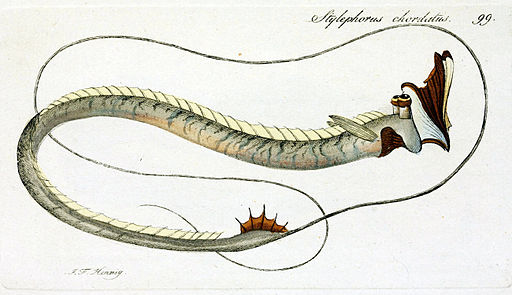
Stylephorus chordatus tube-eye fish, described by George Shaw in 1791
🌎 📣 1768: While postmaster for the American colonies, Benjamin Franklin wondered why British mail ships took longer to cross the Atlantic westwards than colonial merchant ships. He consulted his cousin Timothy Folger, a former Nantucket whaler, who told him that the British captains were unaware of the Gulf Stream, whereas American sailors kept outside of its strong eastery current. The pair produced a map of the Gulf Stream, which Franklin circulated to British mail ship captains, who ignored it.
After the American Revolutionary War, Franklin published the map and an account of its creation in the Transactions of the American Philosophical Society in 1786.
⚓ 26 August 1768: HMS Endeavour left Plymouth under the command of James Cook on a voyage to the Pacific to observe the transit of Venus across the Sun. That goal, on behalf of the Royal Society, would enable a more accurate measurement of the distance of the Earth from the Sun. Cook also had orders from the Admiralty to search for land suspected far to the south in the Pacific, and while not finding a new continent, he mapped the coastlines of New Zealand and eastern Australia. During the Endeavour expedition, Cook used the lunar distances method for determining longitude.
Botanist Jospeh Banks (later President of the Royal Society) led a small scientific party aboard the Endeavour, making a first major survey of the flora of eastern Australia. Ra'iatean islander and high-sect priest Tupaia joined the Endeavour in Tahiti, assisting with navigation and diplomacy until he died when the expedition reached Batavia. The Endeavour returned to England on 12 July 1771.
🔧 1772: A French inventor called Fréminet designed and built a system that allowed a diver to carry an air reservoir with them, on their back or dragged behind them, rather than being supplied with air from the surface. He demonstrated his "machine hydrostatergatique" in dives to 15 metres deep for several minutes.
⚓ 13 July 1772: A second expedition led by James Cook departed from Plymouth, with HMS Resolution and HMS Adventure, heading further south than the Endeavour to seek the land mass suspected to lie at high southern latitudes. Resolution and Adventure became the first European ships to cross the Antarctic Circle, on 17 January 1773.
Athough Cook did not sight Antarctica, the voyage discovered the South Sandwich Islands and landed on South Georgia, as well as returning to Tahiti and visiting Easter Island. During this voyage, Cook had the "K1" copy of Harrison's H4 chronometer, made by Larcum Kendall, and he praised its reliability for helping to determine longitude.
Joseph Banks did not accompany Cook on this voyage, having apparently fallen out with the Admiralty over his requirements for scientific participation. During the voyage, the Adventure took aboard another Ra'iatean islander, called Omai, who returned with the ship to England. Kate Fullgar's article here gives a perspective of the motives of Tupaia and Omai in joining Cook's expeditions - Omai's goal may have been to secure British assistance to overthrow the Bora Boran invaders of Ra'aitea.
Resolution and Adventure became separated and Adventure returned to Britain independently, under the command of Tobais Furneaux. Resolution made landfall back in the UK off Plymouth on 29 July 1775. Cook was made a Fellow of the Royal Society afterwards, and also received the Society's Copley Medal for not losing a single sailor to scurvy during the expedition; his account of methods to preserve the health of his crew was published in Philosophical Transactions of the Royal Society.
🔧 22 June 1774: Cantankerous carpenter John Day may have become the first recorded submarine fatality, when the wooden diving chamber that he built collapsed underwater in Plymouth Sound.
Day built a square chamber to sink to the seafloor with him inside as part of a betting scheme to make money. After 12 hours submerged, he planned to release ballast weights that would allow his chamber to rise back to the surface. But onlookers reported seeking copious bubbles at the surface when the chamber descended, consistent with it collapsing under pressure. When Day failed to reappear, the Navy undertook an unsuccessful search-and-rescue mission for the submerged chamber.
🔧 1775: American inventor David Bushnell and engineer Isaac Doolittle built a one-person submersible called Turtle. With hand-cranked propellors, and a bilge with an air pump for variable ballast, Turtle was designed to attach mines to the hulls of ships, but attempts to attack British ships with it in the early autumn of 1776 failed.
⚓ 12 July 1776: James Cook set out from Plymouth again in command of HMS Resolution, with HMS Discovery under Charles Clerke following shortly afterwards, to map the northernmost extent of the Pacific Ocean and seek the western end of a Northwest Passage.
Another goal of the expedition was to return Omai to Tahiti, but he was not returned specifically to Ra'aitea, and the livestock he assumed was provided to help him gain support for overthrowing the Bora Boran occupation was dispersed by Cook at other stops along the way.
Cook subsequently surveyed the west coast of North America as far as the Bering Strait, and visited the Hawai'ian islands, where he was killed in an altercation with islanders on 14 February 1779. Clerke took over command of the expedition, but died of tuberculosis after reaching the Kamchatka Peninsula. John Gore and James King brought the Resolution and Discovery back to Britain, reaching Sheerness on 4 October 1780.
Cook's final voyage coincided with the American Revolutionary War, and Benjamin Franklin (also a Fellow of the Royal Society, and a fellow recipient of the Copley Medal, for his investigations of electricity) issued a message to American warships that if they encountered Cook's Resolution they were "not to consider her an enemy... but that you treat the said Captain Cook and his people with all civility and kindness... as common friends to mankind".
On 6 February 2007, a new British ocean-class research ship was named the RRS James Cook.
🌎 1777: James Rennell, recently retired from his role as surveyor-general with the East India Company's Bengal Engineers, sailed back to Britain from India with his family. Rennell had previously served in the Royal Navy and as a hydrographer for the East India Company; during his voyage home, he mapped the shoals and currents of the Agulhas region, and began investigating of the currents of the Indian and Atlantic Oceans.
His seminal work in oceanography - "An investigation of the currents of the Atlantic Ocean, and of those which prevail between the Indian Ocean and the Atlantic" - was published in 1832 by his daughter after his death.
📣 1783: The report of an 8 metre long tentacle found in the mouth of a sperm whale ignited the imagination of Pierre Denys de Monfort, who later produced some of the most iconic "sea monster" artworks, such as this image published in 1801:
🔧 1789: John Smeaton built a diving bell that was supplied with air by a pump, rather than the air-filled barrels of Halley's system. He first used the bell to repair the foundations of Hexham Bridge in Northumberland, and then to construct the breakwater of Ramsgate harbour.
🏛️ 🌎 12 August 1795: Founding of the UK Hydrographic Office, under Alexander Dalrymple as its first Hydrographer, producing navigational charts for the Admiralty. The work of the UK Hydrographic Office continues today, from its headquarters in Taunton, Somerset.
Today we celebrate UKHO's 225th anniversary.
We’re proud of our long and unique history since our establishment in 1795 – from supporting Defence, providing leading @ADMIRALTYOnline charts and marine geospatial data, through to working with a range of partners across the globe. pic.twitter.com/o93w8Lxg74
— UK Hydrographic Office (@UKHO) August 12, 2020
Dalrymple also devised a wind scale (building on earlier work by engineer John Smeaton to quantify wind strength from the effect that it had on windmills), later developed further by Francis Beaufort into the eponymous scale used by mariners.
🔧 1797: Karl Heinrich Klingert designed and built a surface-supplied diving suit, which a diver demonstrated by cutting through a submerged tree trunk in the Oder River.
🔧 29 July 1800: American inventor Robert Fulton, living in Napoleon's France, tested his Nautilus submarine in the Seine at Rouen. Fulton was the first of a few 19th century pioneers who imagined submarines as tools for social revolution; in Fulton's case, he saw them as a potential "asymmetric threat" to conventional naval power, which could help to ensure free trade between nations.
Fulton's Nautilus was propelled by a hand-cranked propellor, with air supplied by a snorkel, and designed to plant mines on ships, similar in concept to Bushnell's Turtle. Further tests demonstrated the sub's capability to dive to nearly 8 metres deep, and proceed at almost two knots. But Napoleon was ultimately unimpressed, so Fulton took his design for a larger vessel to the British Admiralty, who expressed interest but did not develop the plans, perhaps sitting on them to prevent any threat to their naval dominance. A frustrated Fulton abandoned his submarine plans and returned to the United States in 1806.
👤 14 Jan 1806: Birth of Matthew Fontaine Maury - pioneering oceanographer later known as "Pathfinder of the Seas". Maury defied his father's wishes to enter the US Navy (his older brother had died of Yellow Fever in the service), and served aboard ships including the USS Vincennes during the Navy's first circumnavigation.
Maury's sea-going career ended at age 33 when he broke his leg in a stagecoach accident, after which he took charge of the Navy's Depot of Charts and Instruments (later the United States Naval Observatory), collating data collected by ships at sea and standardising methods for ocean observation and measurement.
Maury resigned his commission in the US Navy in 1861 at the start of the American Civil War, and then served in the Confederate navy as a supporter of the seccessionist cause and its institutions, including slavery. This wider context beyond contributions to oceanography is summarised in this article by Dr Penelope Hardy and Dr Helen Rozwadowski, advocating reconsideration and renaming of monuments to him. In 2023 the US Navy renamed the Pathfinder-class research ship that had carried his name.
⚖️ 1807: Britain's Parliament passed An Act for the Abolition of the Slave Trade, prohibiting slave trading in the British Empire. Empowered by the Act, the Royal Navy established the West Africa Squadron in 1808 to suppress the trans-Atlantic slave trade. Although the Act did not abolish slavery, it led to the eventual Slavery Abolition Act of 1833.
🦑 1810: French naturalist Antoine de Risso published descriptions of deep-sea animals caught by fishermen in the Mediterranean, sometimes using long-lines down to 1 km deep, including species of grenadier fish (Coelorinchus caelorhincus) and dragonfish (Stomias boa).
🦑 1818: An expedition led by John Ross, exploring for the Northwest Passage, lowered a sounding line into the deep sea that returned with a basket star wrapped around it. The basket star was entangled around the sounding line about 370 metres above its end, and probably came from a depth of around 1000 metres.
This accidental collection of a deep-sea animal has been widely taken as the first proof of life in the deep, believed by most to be impossible at the time. But it was preceded by other collections of deep-sea animals, such as those described by de Risso and Linnaeus, although the exact depth at which those animals were living was uncertain.
🦑 📣 20 November 1820: The US whaling ship Essex was rammed and sunk by a sperm whale.
The sinking of the Essex left 20 or 21 survivors in three small boats ~1200 miles from the nearest land; only two boats eventually made landfall with 8 occupants alive, having resorted to cannibalism to survive.
The accounts of the Essex survivors captured popular attention at the time, and the incident provided inspiration for Herman Melville's 1851 novel Moby Dick (and the 2015 Hollywood movie In the Heart of the Sea, directed by Ron Howard).
🔧 1825: William James designed a self-contained diving rig with a compressed air supply attached to the diver's waist, with the flow is regulated by the diver using a hand valve and the exhaust air escaping from a valve in the helmet.
⚓ 🌎 22 April 1826: French ship L'Astrolabe departed from Toulon on a circumnavigation under Jules Dumont d'Urville, exploring the Pacific and returning to Marseilles on 25 March 1829.
Dumont d'Urville had previously been second-in-command of the ship when it was called Coquille, on a circumnavigation led by Louis Duperrey from 1822 to 1825.
🔧 1828: Paul Lemaire d'Augerville, a French dentist, designed a self-contained diving rig with compressed air supply carried on the diver's back and a reservoir bag on the chest, used to control buoyancy. He used the rig in an attempt to salvage a wreck at 9 to 20 metres deep.
🔧 1830: Thomas Cochrane patented the idea for a caisson: a open-bottom chamber (similar to diving bells of that time) that could be lowered into water and then filled with air at high enough pressure to drive the water out, allowing construction workers to reach submerged environments for building bridge foundations and tunnels. Cochrane also designed an airlock to enable people to enter and leave the pressurised conditions of the chamber.
(Cochrane was an astonishing naval hero, whose other achievements provided the inspiration for CS Forrester's Horatio Hornblower and Patrick O'Brian's Jack Aubrey).
Jacques Triger subsequently built the first caisson system, of his own design, in 1841 and used it in the Loire River and the excavation of a coal mine. Symptoms developed by caisson workers eventually became important for understanding decompression sickness, also experienced by divers from breathing air under pressure.
📣 1830: Alfred Tennyson published his sonnet The Kraken.
Below the thunders of the upper deep;
Far, far beneath in the abysmal sea,
His ancient, dreamless, uninvaded sleep
The Kraken sleepeth: faintest sunlights flee
About his shadowy sides: above him swell
Huge sponges of millennial growth and height;
And far away into the sickly light,
From many a wondrous grot and secret cell
Unnumbered and enormous polypi
Winnow with giant arms the slumbering green...
🦑 1830: The population of western South Atlantic humpback whales is estimated to be around 27,000 individuals at this time, before the start of widespread whaling.
⚓ 🦑 27 December 1831: HMS Beagle, under the command of Captain Robert FitzRoy and with naturalist Charles Darwin aboard, set out from Plymouth Sound to undertake hydrographic surveys of South America, returning to Falmouth in Cornwall on 2 October 1836.
It was the second expedition to South America for the Beagle, whose previous commander, Pringle Stokes, became depressed and shot himself while surveying Patagonia in 1828 (his grave is on the shore at the side of the coast road about 90 minutes drive south of Punta Arenas in southern Chile). FitzRoy was concerned about his own susceptibility to depression, as his uncle Viscount Castlereagh had commited suicide in 1822, so he sought a gentleman companion for his voyage, with whom he could socialise outside the hierarchy of his ship's officers (the link between Castlereagh's depression and Darwin's appointment to the Beagle was explored by Stephen Jay Gould in his essay George Canning's Left Buttock and the Origin of Species).
In addition to collecting material for his eventual theory on natural selection, during the voyage Darwin deduced how coral growth and subsidence of volcanic islands forms fringing reefs and atolls - "No other work of mine was begun in so deductive a spirit as this; for the whole theory was thought out on the west coast of S. America before I had seen a true coral reef", he later wrote.
🔧 1834-1836: John and Charles Deane used a diving helmet that they developed with Augustus Siebe to salvage cannon from the wreck of HMS Royal George near Portsmouth. The helmet was adapted from the brothers' design for a helmet to protect firemen from smoke, and air was supplied to the diver from a manual pump at the surface. Siebe developed the helmet to attach to a watertight but flexible canvas suit, with a valve to prevent flooding if tilted, enabling greater freedom of movement than earlier equipment.
Charles Palsey of the Royal Engineers subsequently used the improved Siebe diving rig to demolish the wreck of the Royal George, and recommended that the Royal Navy should use the equipment for their standard diving dress.
⚓ 🌎 7 September 1837: L'Astrolabe departed Toulon for its second voyage led by Dumont D'Urville, accompanied by La Zéléé under Charles Hector Jacquinot. The expedition, which included a team of seven scientists, was instructed to seek out the southern magnetic pole by King Louis-Philippe.
The expedition sighted and named Adélie Land on the Antarctic continent, and named Adélie penguins (both after Dumont d'Urville's wife). While exploring the Antarctic, the expedition also encountered the USS Porpoise of the United States Exploring Expedition. The ships returned to Toulon on 7 November 1840, and the report of the expedition was published in a series of 24 volumes.
⚓ 🌎 18 August 1838: After a decade in planning, the United States Exploring Expedition departed from Norfolk, Virginia: six ships (USSs Vincennes, Peacock, Relief, Orgeon, Porpoise, Sea Gull & Flying Fish), under overall command of Lt Charles Wilkes, with a team of naturalists aboard.
The round-the-world expedition surveyed more than 2400 km of Antarctic coastline and explored 280 islands, eventually ending in New York on 10 June 1842. The expedition collected more than 60,000 specimens for zoology, geology, and anthropology, and its results, including hydrography and meteorology, were published in 19 volumes.
1838, 6 ships and 400 men of the United States Exploring Expedition leave Norfolk Virginia under the command of Charles Wilkes. They will chart 1500 miles of Antarctic coastline. “Wilkes Land” Antarctica, is the largest continuous territory on Earth named for a single individual. pic.twitter.com/ugWBaRgcqu
— On This Date in Antarctica (@danthewhaler) August 18, 2020
🏛️ 1839: The British Association for the Advancement of Science established a Dredging Committee, bringing together naturalists and enthusiasts who had started to investigate marine life around the British Isles. The hire of private vessels and cost of dredging equipment for collecting specimens from offshore were beyond the means of most individuals, and the Committee therefore opened up a way to support those activities.
The British Association itself had formed in 1831, creating an alternative to the Royal Society to address dissatisfaction over government support for science.
🦑 1841: Edward Forbes, who had been instrumental in creating the British Association's Dredging Committee, joined HMS Beacon in the Mediterranean as a naturalist. Forbes dredged down to 420 metres deep in the Aegean Sea, finding a decrease in marine life with depth in his hauls. When Forbes reported his findings to the British Association in 1843, he hypothesised that the ocean depths might become lifeless beyond 550 metres deep.
This "azoic hypothesis" had also been proposed by other scientists, from different arguments - and although at odds with earlier accidental collections of deep-sea animals, which were perhaps not widely known, the prediction of a lifeless abyss motivated biologists to investigate greater depths.
Forbes began writing The Natural History of the European Seas before he died at the age of 39 in 1854, and his friend Robert Godwin-Austen completed the book, which was published in 1859. Godwin-Austen noted Antoine de Risso's collection of specimens from the deep sea near Nice, and on the subject of whether abyssal depths are lifeless, Forbes had written:
...where life is either extinguished, or exhibits but a few sparks to mark its lingering presence. Its confines are yet undetermined, and it is in the exploration of this vast deep‐sea region that the finest field for submarine discovery yet remains.
🦑 1850: Norwegian pastor and naturalist Michael Sars compiled a list of animals dredged from more than 550 metres deep off the northern coast of Norway.
📣 1851: Herman Melville published his novel Moby Dick.
🌎 📣 1854: Matthew Fontaine Maury produced a map of the ocean floor of the North Atlantic, updating a map he made in 1853 with new soundings taken in mid-ocean by the USS Dolphin.

(reproduction of Maury's 1854 map in 1912 account of the Michael Sars expedition)
Maury's North Atlantic map of 1854 revealed one of the first deep-sea features subsequently given a (nick)name: the "Telegraphic [or Telegraph] Plateau" - the slightly shallower seafloor running north of the Azores, which looked promising as a possible route for laying the first trans-Atlantic telegraph cable (and it was also a first glimpse of the Mid-Atlantic Ridge).
📣 1855: Maury published The Physical Geography Of The Sea - a brilliant early oceanography textbook.
In its pages, Maury made the comparison between what we know about the ocean floor and other planets (a comparison still repeated in TV documentaries about the deep ocean):
Until the commencement of the plan of deep-sea soundings, as now conducted in the American Navy, the bottom of what sailors call 'blue water' was as unknown to us as the interior of any of the planets of our system...
🔧 📣 February 1856: William Thompson - a photography enthusiast, naturalist, and solicitor - took the first underwater photograph by lowering a camera in a box to a depth of ~6 metres from a rowing boat off the coast of Weymouth in the southern UK.
🔧 6 September 1856: Wilhelm Bauer demonstrated his submarine Seeteufel (aka Le Diable Marin or Sea Devil) during the coronoation of its funder, Tsar Alexander II of Russia. A four-piece orchestra played the Russian national anthem from inside the submerged vessel, audible to the audience at the surface.
The Sea Devil could carry a crew of twelve, with four people powering a treadmill for propulsion. It also had an airlock, to enable occupants to escape immediately if necessary - an earlier sub built by Bauer had leaked and sunk in 1851, requiring those inside to wait six hours for the pressure to equalise before they could open the hatch to get out. Sea Devil completed 133 successful dives, reaching a depth of 50 metres.
🔧 📣 16 August 1858: The first official message was transmitted by seabed telegraph cable across the Atlantic; instead of conversations between continents taking weeks via mail ships, messages could now be conveyed in hours, stuttered in Morse code along a cable crossing the ocean floor. The Times declared "The Atlantic is dried up, and we become in reality as well as in wish one country".
In July, HMS Agamemnon and the USS Niagara had met in mid-ocean, spliced together the cables that they carried, and then proceeded to lay their cables as they headed east and west to shore. It was their third attempt, after an unsuccessful operation in June, and a failed effort the year before. The cable came ashore in Newfoundland and Ireland.
But the first connection only lasted for a few weeks. Messages proved harder to get through than anticipated; William Thomson, who later became Lord Kelvin (also later President of the Royal Society, and another recipient of its Copley Medal), had advised the project as a physicist, and was concerned that the slender diameter of the cable would require a careful approach for transmitting messages along it. The chief electrician of the Atlantic Telegraph Company, however, had other ideas: Wildman Whitehouse, former medical doctor turned electricity enthusiast, cranked up the voltage to get messages through, eventually destroying the cable's insulation (and ending Whitehouse's role with the Company).
🦑 1860: Surgeon and naturalist George Charles Wallich joined HMS Bulldog surveying the possible route for a new seabed telegraph cable across the North Atlantic. Wallich recorded that one depth sounding to 2300 metres caught several brittle stars on its rope, indicating the presence of animal life far beyond the depth limit predicted by Edward Forbes.
Also in 1860, a seabed telegraph cable between North Africa and Sardinia failed three years after being laid. The section recovered for repair from more than 2000 metres deep had animals living on it, including a deep-sea coral attached to the cable itself.
🔧 16 April 1863: Launch of French submarine Le Plongeur, designed by Simeon Bourgeois and built by Charles Brun, at Rochefort. With a length of more than 40 metres and a crew of 12, the sub was powered by a compressed air engine, from 23 tanks storing air at more than 12 times atmospheric pressure. The sub was capable of running at 4 knots, with a range of 5 nautical miles, and an operational depth of 10 metres. It was equipped with a ram, and a spar torpedo, to attack ships.
A model of Le Plongeur was displayed at the 1867 Exposition Universelle in Paris, where it caught the eye of author Jules Verne, providing an inspiration for the Nautilus in 20,000 Leagues Under The Sea.
🔧 1865: Auguste Rouquayrol and Benoit Denayrouze develop a diving rig with a pressure regulator connected to an air cylinder on the diver's back - later mentioned in Jules Verne's 20,000 Leagues Under The Sea.
🦑 1866: Georg Ossian Sars, son of Michael Sars, dredged a stalked crinoid from 550 metres deep near Lofoten in Norway (later described as the species Rhizocrinus lofotensis by Sars senior, in 1868).
The discovery of this "living fossil" in the deep ocean caught the attention of British naturalists William Carpenter and Charles Wyville Thomson, who also became aware of the collection of animals by Michael Sars from more than 550 metres deep - fuelling their interest in exploring depths beyond the limit for life proposed by Edward Forbes.
🔧 📣 1866: A lasting trans-Atlantic seafloor telegraph connection was laid by ships including the SS Great Eastern.
🔧 14 December 1867: The submarine Ictineo II, designed by Narcis Monturiol, made its first dive under power from an anaerobic engine, which used a reaction of zinc, mangnesium oxide, and potassium chlorate to provide heat for steam power (and oxygen for the crew).
Replica of Ictineo II at Barcelona harbour
Monturiol was a Catalan revolutionary, who believed submarines could improve the lives of workers such as coral divers and help to create an undersea utopia. But despite crowd-funding the Ictineo II by publishing an appeal for support from the citizens of Spain and Cuba, Monturiol ran out of funds for further developments, and eventually had to sell the submarine for scrap.
Matthew Stewart's book Monturiol's Dream: The Extraordinary Story of the Submarine Inventor Who Wanted to Save the World provides a detailed biography of Monturiol and his submarine innovations.
The sub's name lives on with the Ictineu-3 deep-diving human-occupied vehicle, commissioned in 2013 and capable of working at 1200 metres deep.
⚓ 🌎 🦑 1868: Via the Royal Society, Charles Wyville Thomson and William Carpenter petitioned the Admiralty to provide a vessel for a deep-sea expedition, with an ambitious goal of dredging at a depth of 1000 fathoms (1828 metres), prompted by the discoveries made by Michael Sars and his son.
The Admiralty responded by providing the paddle-sloop HMS Lightning that summer, and Wyville Thomson and Carpenter embarked at Oban to work in the northeast Atlantic. The expedition succeeded in dredging at 1188 metres (650 fathoms), deeper than any previous investigations, and still finding varied animal life.
📣 March 1869: Jules Verne began publishing Vingt mille lieues sous les mers: Tour du monde sous-marin (= 20,000 Leagues Under The Sea) in serialised format in Magasin d'éducation et de récréation
🌎 2 July 1869: Depth soundings by the Swedish corvette Josephine revealed an underwater mountain in the Atlantic between Madiera and Portugal - the first seamount to be discovered.
The later-named Josephine Seamount rises from surrounding seafloor at around 4000 metres deep to 170 metres deep at its peak, and became a Marine Protected Area in 2010.
⚓ 🌎 🦑 1869-1870: Following the success of the Lightning expedition collecting deep-sea animals the previous summer, the Royal Society called on the government to investigate the ocean floor as "one of the special duties of the British Navy". The Admiralty then provided HMS Porcupine for expeditions in the northeast Atlantic in the summers of 1869 and 1870. John Gwyn Jeffries and William Carpenter led different legs of the scientific expedition in both years, and Charles Wyville Thomson took part in 1869.
HMS Porcupine was a more capable vessel than Lightning for deep-sea sounding and dredging, and on 22-23 July 1869 the ship made a successful haul from a depth of 4453 metres (2435 fathoms), southwest of Ireland - a huge leap in dredging achievement. The Porcupine's hauls confirmed the existence of animals far beyond the depth limit for life predicted by Forbes and others.
Much of Porcupine's success can be attributed to her captain, Edward Calver, who devised several modifications to dredging equipment to improve its performance at greater depths (and Dr Helen Rozwadowski tells the story of the development in deep-sea dredging in her book Fathoming The Ocean).
In addition to expanding the horizons of deep-sea biology, the Porcupine expeditions also included investigations of geology and hydrography, for example measuring water temperatures in the deep ocean. One conclusion was that variations in temperature probably influenced the distribution of animal life in the deep sea more than the effects of pressure, and the multidisciplinary approach of the Porcupine expeditions became a blueprint for future oceanographic voyages.
📣 8 June 1871: The scientific journal Nature published an account of a talk given by William Carpenter at the Royal Institution, where he highlighted the discoveries and achievements of the Lightning and Porcupine expeditions, and the article concluded with a rallying call that:
...having shown other nations the way to the treasures of knowledge which lie hid in the recesses of the ocean, we are falling from the van into the rear, and leaving our rivals to gather everything up. Is this creditable to the Power which claims to be mistress of the seas?
🔧 June 1872: William Thomson (later Lord Kelvin) tested his new design for a sounding machine that used piano wire, instead of rope, from his yacht Lalla Rookh in the Bay of Biscay.
Thomson designed his sounding machine so that the reel paying out the wire should stop automatically when the weight reached the seabed. This enabled more accurate measurements of depth than previous systems, which required operators to watch for a change in the rate at which line paid out (which could also be affected by currents pulling at the sounding line).
The mass-production of piano wire, driven by the popularity of upright pianos among the middle classes of the nineteenth century, meant that it was available relatively cheaply in the many-kilometre lengths needed for deep-sea sounding. So we can perhaps thank upright-piano inventors such as John Isaac Hawkins, born in Taunton in 1776, for indirectly enabling new technology for deep-sea exploration.
⚓ 🌎 🦑 21 December 1872: HMS Challenger left Portsmouth to begin a three-and-a-half year round-the-world voyage investigating the oceans, taking a multidisciplinary approach similar to that pioneered by the Porcupine expeditions.
The Challenger expedition was the result of lobbying by the Royal Society for a global scientific voyage, building on the experience and successes with HMS Porcupine in the northeast Atlantic. With an eye on the importance of knowing more about the ocean floor for telegraph cables, the government backed the project, and the Admiralty provided a 68 metre corvette.
HMS Challenger was fitted out for scientific work, and crammed with ~18 km of deep-sea sounding wire, more than 150 km of other sounding line, and more than 45 km of other rope. Charles Wyville Thomson led the scientific party aboard, as William Carptenter was then too old to take part at the age of 59, and his account of the voyage - available here - includes a full list of the scientific equipment and supplies aboard.
Challenger received one of William Thomson's new wire-sounding machines, but after problems getting it to work reliably from the ship, the expedition abandoned it in favour of older but tried-and-tested methods for measuring depth.
You can follow the route of HMS Challenger here, including details of the measurements and sampling undertaken at each of the scientific "stations" during the voyage.
On 23 March 1873, at Station 25, Challenger set a new record for the deepest recorded depth sounding, measuring 7087 metres (3875 fathoms) on the northern flank of what we now recognise as the Puerto Rico Trench in the western Atlantic. Challenger's record for deepest-measured-depth would stand for just over a year, however, before being exceeded the USS Tuscarora surveying in the Pacific.
Measurements of the specific gravity (density) of seawater during the Challenger expedition have helped to reveal how salinity has changed in the oceans since the 1870s. Lower-salinity areas of the ocean have become even fresher, and saltier areas of the ocean more salty, driven by changes in temperature and our planet's water cycle since the industrial revolution.
👤 1873: Physician Andrew Smith treated more than a hundred cases of decompression sickness among workers building the Brooklyn Bridge, where caissons were used to a depth of nearly 24 metres.
Although symptoms had previously been noted in similar construction projects, Smith was the first to use the term "caisson disease" - and the Brooklyn Bridge workers used the term "the bends" to describe the posture adopted by suffers to try to alleviate pains in their joints.
🔧 ⚓ August 1873: Captain George Belknap of the US Navy modified the Thomson sounding machine for successful use from the USS Tuscarora, prior to embarking on a voyage from San Francisco to Japan to scout possible routes for undersea telegraph cables.
🌎 27 October 1873: USS Tuscarora discovered the first Pacific seamount, as described by Henry Cummings in his account of the expedition:
While sounding on the afternoon of the 27th, some 140 miles off the coast of California, and expecting a depth of 1,600 or 1,700 fathoms (the previous cast having been 1,689 fathoms), the lead suddenly brought up at a depth of 966 fathoms... We then sounded round this locality and found that a rocky submarine peak, 4,000 feet in height, existed in this part of the ocean.
🌎 19 June 1874: Using the Thomson wire-sounding machine modified by captain George Belknap, USS Tuscarora measured a seabed depth of 8513 metres (4655 fathoms) in what is now recognised as the Kurile-Kamchatka Trench of the north Pacific.
🌎 23 March 1875: HMS Challenger measured a depth of 8184 metres (4475 fathoms) in the Mariana Trench of the Pacific Ocean - the greatest depth recorded in her round-the-world voyage of exploration (though not as deep as the sounding by the Tuscarora further north in the Pacific during the previous year).
"Baffling winds" had pushed Challenger off-course, so her discovery of a deep depression in the seabed near the Marianas was serendipitous. The site was ~25 km from the ocean's deepest point, the bottom of the later-named Challenger Deep, eventually found to be >2.7 km deeper at >10.9 km.
No further depth soundings were made in the area for another 24 years, so the linear nature of what we now recognise as the Mariana Trench was not realised at the time.
🦑 July 1875: The barque Pauline, carrying a cargo of coal and captained by Geroge Drevar, encountered a "sea serpent" attacking a sperm whale off the coast of Brazil.
A report of the encounter describes a whale "gripped round the body, with two turns, by what appeared to be a huge serpent. Its back was of a darkish brown and its belly white, with an immense head and mouth, the latter always open", as discussed in this article by Dr Charles Paxton, who considers the possibilites that the incident might have involved the arm of a giant squid preyed on by sperm whales, or a sperm whale penis during mating behaviour.
Interested in the bonkers backstory behind one of the most famous sea serpent sightings of all time? When the existence of sea serpents was discussed at the Old Bailey? Then check out my latest paper at https://t.co/6A5pYYmUQW
— Charles Paxton (@CharlesPaxton4) July 21, 2021
🌎 ⛏ 14 July 1875: At station 252 on her voyage, HMS Challenger dredged up "many hundreds of manganese nodules" from 5011 metres deep in the equatorial eastern Pacific. Challenger had collected manganese nodules and other manganese-coated specimens from the seafloor at other previous locations, but the nodules were particularly abundant in the haul here.
The largest nodules were about the size of cricket balls; they were more or less round or ellipsoidal, and when rolled on the deck they looked like a pile of dirty potatoes.
Manganese nodules had previously been found in shallow water, near Sweden in 1868, but shallow-water nodules are formed by different processes to those on the deep ocean floor.
⚓ 🌎 1875: The USC&GS George S. Blake set out under Charles Sigsbee, equipped with an even-further-modified Thomson sounding machine (thereafter known as the Sigsbee sounding machine), surveying the Gulf of Mexico and surrounding waters with more than 3000 depth measurements, resulting in the first detailed deep-sea bathymetric map of a region.
Alexander Agassiz - later President of the National Academy of Sciences of the USA - joined the Blake for three dredging expeditions during 1877 to 1880.
🌎 26 March 1876: HMS Challenger measured a depth of 7087 metres north of Puerto Rico, discovering what was later realised to be the Puerto Rico Trench - the deepest seafloor feature of the Atlantic.
⚓ 24 May 1876: HMS Challenger returned to Portsmouth at the end of her round-the-world expedition, having covered ~127,000 km - one-third of the distance to the Moon - and spent a total of 713 days out at sea.
But the work of the expedition had not yet ended; an important part of the project was the preparation and publication of the Challenger reports, disseminating the voyage's findings for free to key institutions around the world (and thereby ensuring the expedition's legacy in the foundations of modern oceanography). Analysing the samples and data from the voyage, and producing the reports, would take a further 19 years, involving a slew of specialists in different fields.
🌎 📣 1877: German cartographer August Petermann published a map of the Pacific Ocean floor, incorporating soundings from HMS Challenger and USS Tuscarora:
Petermann's map is one of the first to show a "Challenger Deep", where HMS Challenger measured the greatest depth during her voyage, on the edge of the Mariana Trench. His map also has a larger "Tuscarora Deep", and "Belknap Deep", where USS Tuscarora under George Belknap recorded some of its greatest depth measurements. But unlike "Challenger Deep", neither of those two names are still used for ocean floor features today.
George Nares, who captained the Challenger at the start of her expedition, still has an abyssal plain named after him, north of Puerto Rico in the Atlantic. Unfortunately Belknap is not similarly commemorated, despite his achievements in modifying the Thomson sounding machine, discovering what we now know as the Kuril-Kamchatka and Aleutian Trenches during the Tuscarora voyage, and later discovering the Peru-Chile Trench while in command of USS Alaska in 1881.
With only single depth or sparse soundings in the deep areas discovered by Challenger and the Tuscarora, Petermann's map does not recognise the linear nature of the trench areas that they represent, and depicts more circular deep areas as his interpretation of the probable seafloor terrain around those measurements.


George Belknap (left) and George Nares (right)
👤 29 July 1877: birth of Charles William Beebe (best known as William Beebe), biologist of land and sea, and author of popular books on natural history, who became one of the first "bathynauts" to venture into the deep ocean in the early 1930s. Carol Grant Gould's The remarkable life of William Beebe: explorer and naturalist provides a thorough biography.
🦑 5 March 1880: Henry Moseley, veteran of the Challenger expedition, gave a talk at the Royal Institution in London, in which he hypothesised that despite the discovery of widespread life on the ocean floor, the mid-water realm might be largely uninhabited:
Very possibly the pelgic animals do not range to any great depth, 100 to 150 fathoms or less. It is quite possible that a vast stretch of water between the surface and the bottom is nearly or absolutely without life
This perhaps dying echo of the "azoic hypothesis" would be refuted before the end of the century, by Germany's Valdivia expedition.
🔧 1882: French brothers Alphonse and Theodore Carmagnolle were granted a patent for their armoured diving suit - an Atmospheric Diving Suit (ADS), where the occupant remains at normal surface pressure. Unfortunately its joints were not completely watertight, but it is also beautiful as a piece of art:
👤 10 March 1882: Death of Charles Wyville Thomson, and John Murray took over publication of the Challenger Reports.
🦑 🔧 19 August 1882: Launch of the USS Albatross, perhaps the first ship designed and built specifically for scientific use. Based out of Woods Hole in Massachusetts and crewed by the Navy, the Albatross undertook marine biological surveys for the United States Fish Commission, and continued to be used as a research ship until 1921.
👤 28 January 1884: Birth of Auguste Piccard, Swiss physicist-inventor-adventurer who became the first person to explore the stratosphere and the deep ocean.
In the early 1930s he set several altitude records in a pressurised balloon gondola that he designed - and then turned his attention to the ocean, creating the bathyscaphe design of deep-diving vehicles used from the 1940s onwards.
👤 1884: Albert Grimaldi, heir to the Principality of Monaco, visited an exhibition at the Museum of Natural History in Paris displaying deep-sea specimens collected by the French expeditions of the Travailleur and Talisman (1880-1883).
Albert, who became Prince Albert I of Monaco in 1889, resolved to pursue oceanography and marine biology with his resources, undertaking expeditions with his research yachts Princesse Alice, Princesse Alice II, Hirondelle and Hirondelle II.
Prince Albert I, who reigned over the principality of Monaco from 1889-1922, was a pioneering ocean explorer. His great-great-grandson, Prince Albert II, carries on the tradition as an active and passionate supporter of ocean conservation. https://t.co/eG7qw3fRsx
— National Geographic Society (@InsideNatGeo) May 11, 2021
🔧 1884-1888: Swedish engineer and industrialist Thorsten Nordenfelt built a series of steam-powered submarines, initially with input from English reverend George Garrett (whose own steam-powered submarine, Resurgam, unfortunately sank in 1880). The Nordenfelt submarines had a coal-fired steam engine that was shut off for diving, when the submarine was instead powered by compressed air banks charged while at the surface.

Ottoman navy submarine Abdül Hamid (Nordenfelt II)
Nordenfelt sold the first one to the Greek navy, then the second and third to the Ottoman navy - and the Abdül Hamid (Nordenfelt II) became the first submarine to fire a torpedo while submerged. A fourth submarine was sold to the Russian navy, but ran aground off Jutland, after which Russia refused to pay for it.
H I Sutton gives thorough details of the development of the Nordenfelt submarines, with cutaway schematics and original photographs.
👤 1887: While overseeing the ongoing publication of the Challenger Reports, John Murray analysed mineral samples collected from Christmas Island in the Indian Ocean by HMS Egeria, and found they were almost pure phosphate of lime, in demand as a fertiliser. Britain moved rapidly to annexe the Island and establish a settlement there, and Murray and George Clunies-Ross received the rights to mine the phosphate deposits, eventually establishing the Christmas Island Phosphate Company by 1900
Income from the venture provided Murray with independent wealth, which he used to support future oceanographic expeditions such as the 1910 North Atlantic Expedition, in which he took part, and the John Murray Expedition to the Indian Ocean in 1933-1934, funded by a bequest after his death in 1914.
🦑 ~1888: Microbiologist Sergei Winogradsky showed that some microbes could grow using chemical sources of energy, through a process known as chemoautotrophy or chemosynthesis. Nearly a century later, chemosynthesis would prove to be the key to understanding how colonies of abundant animals thrive at deep-sea habitats such as hydrothermal vents.
🔧 24 September 1888: Launch of the French submarine Gymnote, regarded as the first electric-powered submarine. Gymnote was nearly 18 metres long, with a crew of five, and its electric motor was initially powered by 540 alkaline cell batteries (later replaced with sulfuric acid batteries). It had a range of 25 nautical miles while submerged, with maximum underwater speed of just over 4 knots, and was equipped with two 14-inch torpedo tubes.
📣 1893: Rudyard Kipling published his poem The Deep-Sea Cables, about the change wrought on the world by submarine telegraphy. Its lines include an evocative description of an abyssal plain: "the great grey level plains of ooze where the shell-burred cables creep".
🔧 📣 1893: French biologist Louis Boutan began to experiment with equipment for underwater photography, to record the scenes that he observed while diving around the Arago Laboratory at Banyuls-sur-Mer on the Mediterranean coast. Some of his apparatuses were lowered and triggered from the surface, but Boutan also became the first underwater photographer, taking pictures as a diver.
Boutan designed and developed various housings and lenses for underwater cameras, and tested light sources such as a magnesium flash and, in 1899, underwater electric arc lamps. In 1900 he published a book, La photographie sous-marine et les progrès de la photographie.
Anika Burgess tells the story of Boutan's work in this article.
📣 1894: Sydney J. Hickson FRS published The Fauna Of The Deep Sea, part of a series of "popular science" books, in which he summarised recent discoveries in deep-sea biology for a wide non-academic audience.
The book included a prediction that:
We may be able to plant the Union Jack on the summit of Mount Everest, we may drag our sledges to the South Pole, and we may, some day, be able to travel with ease and safety in the Great Sahara; but we cannot conceive that it will ever be possible for us to invent a diving bell that will take a party of explorers to a depth of three and a half miles of water.
(But less than 80 years later, bathynauts would plunge far beyond that depth in the ocean).
🌎 1895: HMS Penguin measured a depth of 9144 metres in the Kermadec Trench of the southwest Pacific - surpassing the depth measurement record set in the northern Pacific by USS Tuscarora in 1874.
🦑 📣 1895: The final volume of the Challenger reports was published - the end of a series of 50 volumes, "each as thick as a bible", which included descriptions of more than 4000 new species of animals collected by the expedition.
The completed Reports included a new map of the ocean floor for the Pacific produced by John Murray. His map keeps the name "Challenger Deep", adopted by August Petermann in his 1877 map, for a deep seafloor area around the location of Challenger's deepest depth measurement, near the Mariana Islands (but the feature remains circular in nature, rather than trench-like).
The Challenger reports are available online here.
📣 1896: HG Wells published his short story In The Abyss in Pearson's Magazine (available here as a free audiobook). The protagonist in the story dives in a hollow steel sphere to observe marine life on the ocean floor, and becomes entangled with a submarine civilisation of aquatic humanoids.
⚓ 🦑 1 August 1898: The Valdivia expedition (Deutschen Tiefsee-Expedition) left Hamburg, led by biologist Karl Chun, to investigate mid-water fishes and cephalopods. The expedition returned to Germany on 30 April 1899, having covered more than 59,000 km, and discovered new species such as the vampire squid (Vampyroteuthis infernalis), which was described by Chun.
🔧 ⚓ September 1898: The Argonaut submarine built by Simon Lake completed a voyage from Norfolk, Virginia to Sandy Hook, New Jersey - the longest open-sea journey by a submarine. The submarine travelled on the surface and submerged, which enabled it to evade poor weather by slipping beneath the waves, and the achievement of the long-distance voyage prompted a telegram of congratulations from Jules Verne.
The Argonaut had a lock-out chamber that enabled divers to collect specimens of marine life from the seafloor. By 1900, Lake had refitted the submarine, and took groups of more than 20 guests to the bottom of Long Island Sound, where divers from the sub collected fresh seafood for undersea dinner parties.
🦑 1899: The research ship Albatross successfully trawled the seabed at 7632 metres deep in the Tonga Trench, but only collected fragments of dead glass sponges, allowing questions to linger about the persistence of life at the greatest ocean depths.
🌎 📣 1899: Alexander Supan published his Tiefenkarte des Weltmeeres ("Depth map of the world's oceans"), which is the first map to show the linear nature of some ocean trenches (e.g. Aleutian Trench; Japan Trench; Tonga Trench).
Supan also proposed that the naming of seafloor features should be based on their association with recognised nearby geography (e.g. "Aleutian Graben" - Aleutian Trench - because of its proximity to the Aleutian Islands), rather than features being named after ships or people.
Others (e.g. John Murray) supported continuing to name features after people or ships, but the geographic-naming principle was subsequently adopted for major seafloor features, to provide greater consistency in naming for cartographers working independently to produce new maps. Features already named after ships and people persisted, however (e.g. "Challenger Deep" and "Nares Abyssal Plain" - but consequently nothing for George Belknapp, who hadn't previously been commemorated that way). And small-scale features or locations of note continued to be named after ships or people (for example: the Emden Deep, as the deepest point within the Philippine Trench, was later named for the German cruiser Emden that made an echosounder measurement there in 1927).
Supan's map incorporated recent depth measurements in the vicinity of the Mariana Islands, but did not correctly depict the Mariana Trench, as he interpolated depth measurements in the nearby Caroline Trench to imagine a feature combining the two.
Meanwhile John Murray also published a new map of the Pacific ocean floor, in The Scottish Geographical Magazine in the same year, showing the "Challenger Deep" region as a more curvilinear feature fitting with the nearby island arc, but still not yet an accurate representation of the Mariana Trench.
🌎 November 1899: The USS Nero, sent to scout routes for seafloor telegraph cables to the Philippines, measured a depth of 9636 metres in what we now recognise as the Philippine Trench (surpassing the depth measurement record set by HMS Penguin in the Kermadec Trench). The Philippine Trench was subsequently considered the deepest place on Earth, until the early 1950s.
🔧 12 October 1900: The USS Holland became the first modern submarine commissioned into the US Navy. The submarine had been designed by Irish engineer John Philip Holland, and built privately in 1897. The USS Holland was actually the sixth submarine designed by Holland, whose previous subs included the Fenian Ram, built in 1881 for Irish republicans in America but never used against the British as intended.
Holland's sixth design combined a petrol engine for surface use with electric motors for diving. The submarine was capable of a 200 nautical mile (370 km) range at 6 knots while surfaced, and 30 nautical miles (56 km) at 5.5 knots submerged, with a maximum operating depth of 23 metres. The Holland's armament consisted of a single 18-inch torpedo tube, with three torpedoes carried aboard, and a dynamite gun. The sub did not have a periscope (a technology still in development in France), but used a "porpoising" diving profile, exposing the conning tower long enough for observers to get a look around before submerging again.
The company created in 1899 to build Holland's designs for the US Navy - the Electric Boat Company - eventually became the defense giant General Dynamics in 1952. The Imperial Japanese Navy bought five modified Holland-types from the Electric Boat Company for its first submarines in 1904, and Holland's design was also adopted by the Royal Navy for its first submarines - the Holland class - built by Vickers in Barrow-in-Furness.
Frank Taylor Cable, who co-founded the Electric Boat Company, was captain of the Holland VI during her commissioning trials, and in 1943 he wrote a memoir about his experience, available here (my thanks to Dr Antony Adler for bringing it to my attention).
Cable's account mentions Clara Barton, founder of the American Red Cross, being a guest aboard during one of the Holland's diving trials, suggesting that "perhaps she was the first woman to venture in a submarine":
Clara Barton (of American Red Cross fame); the first woman to go underwater in a submarine (circa 1900)? https://t.co/Mz4RxiKpH4 pic.twitter.com/MoOVzToUbk
— Antony Adler 🌊♆ 🔬🌊 (@Antony_Adler) August 14, 2020
🌎 February 1900: The research ship Albatross measured a seafloor depth of 8802 metres southeast of Guam, in part of what we now recognise as the Mariana Trench. Albatross's measurement, along with soundings by other vessels scouting cable routes in the region, contributed to eventual recognition of the orientation of the trench (though it would be another five decades before the Mariana Trench was recognised as containing the deepest point on Earth).
🦑 1901: The Princess Alice research yacht of Prince Albert I of Monaco collected a cusk eel (Bassogigas profundissimus) from 6305 metres deep in the eastern Atlantic - the deepest record of a fish by that time.
🏛️ 1903: Founding of the Challenger Society for Marine Science, initially with 25 members who met four times per year at the Royal Society. From 1984 onwards, the Society has held biennual conferences at locations around the UK, where researchers meet to discuss all multidisciplinary aspects of marine science.
🌎 🏛️ April 1903: Prince Albert I of Monaco agreed to fund the production of a new series of maps of the ocean floor, to be known as "la Carte generale bathymetrique des oceans" or the General Bathymetric Chart of the Oceans (GEBCO). GEBCO became the organisation coordinating standardised maps of the ocean floor during the later 20th and early 21st century, as described in its history here.
🔧 1905: Britain's Admiralty appointed John Scott Haldane to develop safe decompression procedures for divers, and in 1908 Haldane produced the first decompression tables, which the Royal Navy used until 1955. He also co-authored a paper on "The prevention of compressed-air illness".
🏛️ 1906: Monaco's Institut océanographique was founded by Prince Albert I.
🌎 📣 1907: A new edition of the Handbuch der Ozeanographie ("Handbook of Oceanography") by Otto Krummel included the first map to more correctly depict the Mariana Trench as a feature (though the Philippine Trench is still considered the deepest place on Earth at the time).
👤 1907: Katharine Dare became the UK's first female diver, descending in hard-hat diving rig in Liverpool as a guest of the Liverpool Salvage Association.
Dare published a first-person account of her dive in the November 1907 issue of The London Magazine, in an article entitled "The First Girl Diver" (with the subtitle "'Never again - not for £1000!'").
Dare was inspired to dive having seen the underwater world of Monterey Bay from a glass-bottomed boat used by the marine biology department of Stanford University.
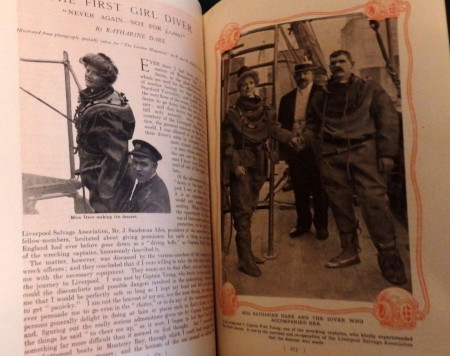
👤 ⚓ 🦑 6 July 1908: The SS Roosevelt left New York for the eighth Arctic expedition led by Robert Peary, accompanied by the African-American polar explorer Matthew Henson, who had taken part in six other Arctic expeditions.
Henson led Peary's party when they reached what they thought to be the North Pole, and in 1912 he published his memoir entitled A Negro Explorer at the North Pole, later becoming the first African-American to be made a life member of The Explorers Club.
Henson's logbook observations during the expedition noted the decline of Arctic seal and walrus populations from commercial hunting and its impact on local people, as described in this article by Richard King and David Anderson.
⚓ 🦑 1 April 1910: The steamship Michael Sars of the Norwegian Board of Fisheries left Bergen to begin an expedition across the north Atlantic, investigating deep-sea life on the abyssal plains and the Mid-Atlantic Ridge. The expedition was led by Challenger veteran John Murray, who joined the ship in Plymouth, and marine zoologist Johan Hjort.
The University Museum of Bergen produced an excellent summary of the voyage on its centenary. More than a hundred new animal species were described from the expedition, and in 1912 Murray and Hjort published The Depths of the Ocean, based on its findings.
👤 11 June 1910: Birth of Jacques-Yves Cousteau; "The sea, once it casts its spell, holds one in its net of wonder forever".
🔧 6 September 1911: Launch of the US Navy submarine USS F-1, originally called the Carp. The submarine subsequently set a depth record by descending to 86 metres.
🔧 21 July 1913: German physicist Alexander Behm filed a patent for an echosounder (Means for measuring ocean depths and distances and directions of ships or obstacles with the aid of reflected sound waves), developed from an earlier device that he invented for detecting icebergs after the sinking of the Titanic. Around the same time, Reginald Fessenden in the US developed an underwater transducer, also key for the further development of echosounding.
The principle of echosounding had been mentioned by Matthew Fontaine Maury in The Physical Oceanography of the Sea in 1855, who described an experiment trying to time the echoes from gunpowder explosions to determine the depth of the seabed, but "no answer was received from the bottom". Electro-acoustic transducers of the early 20th century proved much more discerning than human ears, and the new technique of echosounding revolutionised mapping of the ocean floor.
🔧 📣 5 August 1914: At the outbreak of war with Germany, a British operation cut German seafloor communications cables.
🔧 1915: On 25 March, the submarine F-4 became the first US Navy submarine lost at sea, sinking to a depth 93 metres off Hawai'i with no survivors. In August, divers breathing compressed air supplied from the surface helped to monitor the positioning of lifting hawswers for the wreck on the seaflooor, enabling it to be raised (as reported in Scientific American).
One of the members of the dive team was John Henry Turpin, who was one of the first African-Americans to become a Chief Petty Officer in the US Navy. Scientific American described the profile of a dive to the wreck: 5 minutes to descend to ~93 metres, 12 minutes working on the bottom, and 1 hour 45 minutes for ascent with decompression stops.
📣 1916: Release of the first movie with sequences filmed underwater: an adaptation of 20,000 Leagues Under The Sea, with divers in the Bahamas shot from cameras at the surface using a system of tubes and mirrors devised by J. Earnest Williamson.
👤 June 1916: Ernest Everett Just received his PhD in Zoology from the University of Chicago, for research on the embryology of sea urchins that he underook at the Marine Biological Laboratory at Woods Hole.
Just had taught at Howard University since graduating from Dartmouth in 1907, and was head of Howard's new Department of Zoology from 1912. He became the first American black professor in marine science, publishing more than 70 scientific papers and authoring two books. Dr Just's work also took him to the "Anton Dohrn" marine biological station near Naples, and in 1940 he was working at the Station Biologique de Roscoff when Germany invaded France, where he was imprisoned before managing to get back to the US.
Kenneth Manning's book Black Apollo of Science: The Life of Ernest Everett Just provides a biography.
🔧 1916: Inventor Hans Hartman designed and successfully tested a deep-sea camera and lighting system that could be lowered from a surface vessel to take pictures at more than 300 metres deep (1000 feet), as described in Popular Science magazine in October 1917.
Hartman's camera system took pictures of sunken ruins in the Mediterranean in 1924, as reported by Alma Reed in the New York Times.
Hartman also designed a diving bell to carry a camera operator to even greater depths, as described in Popular Science in March 1925.
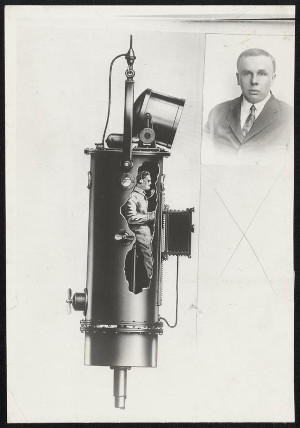
Some accounts then report Hartman descending successfully in his diving bell in the 1920s, even surpassing the depth reached by William Beebe and Otis Barton in the first bathysphere dives in 1930. But the veracity of those reports is questionable.
In August 1925, an article in Time magazine claimed "Dr Hartman descended 1000, 2000, 3000 ft in his diving bell".
But in reporting Beebe & Barton's bathysphere dives in 1930, Time stated "Seated in a steel sphere explorer Beebe and Otis Barton, inventor, dropped 1426 ft into the sea, 1076 ft deeper than the record".
A December 1929 article in Science and Invention had the headline "2,500 Feet Under The Sea: American Scientist Breaks All Depth Records and Discovers Sunken City in the Mediterranean", describing Hartman as "the only man who has ever descended to a depth of 2500 feet".
But a July 1930 article ("The Hunt for Lost Atlantis") in Popular Mechanics described the plans for Hartman's diving cylinder and its intended use on a forthcoming Mediterranean expedition, rather than any previous successful dive with Hartman aboard.
Whether Hartman descended in his diving cylinder, and if so to what depth, is not clear. Hartman's partner in the Mediterranean venture was Francis Victor Kuhn, self-styled "Count Byron Khun de Prorok", who was a very controversial figure in archaeological circles, accused of exaggeration in publicising his expeditions.
In 1931 Hartman filed a patent for "submarine television" to relay live pictures from the deep to viewers at the surface, without an operator needing to descend with the camera in a diving bell.
🔧 17 December 1917: The US Navy submarine USS F-1 collided with the USS F-3 during manoeuvres off San Diego and sank in ~400 metres of water, with the loss of 19 of her 22 crew.
In 2025 researchers from Woods Hole Oceanographic Institution located and surveyed the wreck.
🏛️ ⚓ 🦑 1918: Founding of the "Discovery Committee" to undertake scientific investigations for managing commercial whaling by Britain in the Antarctic.
Running until 1951, the "Discovery Investigations" involved the foundation of a marine biology laboratory at King Edward Point on South Georgia in 1925, and expeditions by the research ships RRS Discovery, RRS William Scoresby, and RRS Discovery II from 1924 to 1951.
The results of the investigations were published in 38 volumes of "Discovery Reports" from 1929 to 1980, covering aspects of marine biology in the Southern Ocean ranging from the anatomy and physiology of whales to the life cycles of Antarctic invertebrates.
👤 30 July 1920: Birth of Marie Tharp, who mapped the global mid-ocean ridge and revealed its central rift valley, providing crucial evidence for the process of plate tectonics; "You can't find anything bigger than that, at least on this planet", she commented in 1999.
On 8 March 2023 (International Women's Day), the US Navy announced that it was renaming a Pathfinder-class research ship after Tharp to commemorate her work.
🔧 1920: According to this newsreel, a diver in an Atmospheric Diving Suit (ADS) set a new depth record by reaching 110 metres deep in Boston Harbour. It may have been a prototype designed by Joseph Salim Peress, who later created the Tritonia ADS.
📣 25 April 1921: Prince Albert I of Monaco spoke to the National Academy of Sciences in Washington about threats to the ocean, mentioning the growth of industrial fishing and its impacts on continental shelf habitats.
Il y a un siècle, le 25 avril 1921, le Prince Albert Ier de Monaco (1848-1922) prononçait devant les membres de l’Académie nationale des Sciences à Washington le "Discours de l’Océan". Il y parle déjà des dangers qui touchent l’océan. #FocusPatrimoine #TousOceano pic.twitter.com/OOi34dqZr1
— MuséeOcéanographique (@OceanoMonaco) April 29, 2021
⚓ 🌎 1923: Dutch geophysicist Felix Vening Meinesz took part in a voyage by the Netherlands submarine K II from Holland to Java, making pendulum gravity observations at 26 locations while the submarine was submerged, enabling study of variation in ocean crust below. By making the measurements from a submerged submarine, Meinesz was able to reduce the effects of the sea's motion, which hampered attempts to use pendulums to measure gravity variations from surface ships.
Meinesz went on to refine the equipment and technique aboard the Netherlands submarine K XIII in 1926 and US Navy submarine S-21 in 1928 (publishing an account of the technique in 1933).
⚓ 🌎 16 April 1925: The German research ship Meteor began the Deutsche Atlantische Expedition from Wilhelmshaven, returning on 2 June 1927. The expedition criss-crossed the South Atlantic, primarily investigating ocean currents but also using an echosounder to make ~67,000 depth measurements, which revealed the full extent of the Mid-Atlantic Ridge.
To put the Meteor expedition's ~67,000 depth measurements into context: only five decades years earlier, the round-the-world voyage of HMS Challenger made 492 measurements of ocean depth, using sounding line, considered a feat for mapping the deep at that time.
🔧 📣 1926: Photographer Charles Martin and biologist William Longley took the first colour underwater photographs, using a magnesium flash to illuminate subjects including hogfish, corals, and anemones. National Geographic magazine published some their photos in its July 1927 issue.
🔧 🦑 6 June 1930: William Beebe and Otis Barton become the first "bathynauts" to venture into the deep ocean (defined as more than 200 metres deep), diving to 435 metres in the "bathysphere" off Bermuda's Nonsuch Island. Beebe was the first biologist to observe deep-sea animals alive in their natural habitat, from the portholes of the bathysphere.
👤 11 June 1930: Gloria Hollister set a record as the deepest diving woman, descending to 120 metres in the bathysphere on her 30th birthday (and Hollister would dive deeper in 1934).
🏛️ 1930: Founding of Woods Hole Oceanographic Institution in Massachusetts, already the location for the US National Marine Fisheries Service and Marine Biological Laboratory.
🔧 🦑 1931: Alister Hardy and Cyril Lucas began the Continuous Plankton Recorder (CPR) Survey, using a torpedo-shaped plankton sampling instrument that could be towed behind ships, devised by Hardy during the Discovery Investigations in the Antarctic in the 1920s.
The CPR Survey has since been run by the Marine Biological Association in Plymouth, and is now one of the longest-running monitoring programmes in marine biology. By 2020 the Continuous Plankton Recorder had been towed for more than 13 million km through the ocean - equivalent to 326 circumnavigations of the world - and its data are helping to show how ocean ecosystems have been changing.
Our @GuinnessMuseum certificate for our @CPRSurvey holding record for the greatest distance sampled by a marine survey. This will be proudly hung in our reception - what a way to hit their 90th anniversary! #CPR90 #OfficialyAmazing pic.twitter.com/lBneDSaNLq
— MBA - Marine Biological Association (@thembauk) July 21, 2021
⚓ 4 June 1931: A submarine expedition led by Hubert Wilkins left New York to attempt to reach the North Pole.
The submarine, christened Nautilus, suffered engine failure in the Atlantic and had to be towed to Ireland, and then repaired in England, before continuing to Bergen and eventually reaching the edge of the Arctic sea ice on 19 August.
But the sub was unable to dive beneath the ice pack, as it had lost its diving planes. After returning to Svalbard, and then being damaged by a storm, the Nautilus was scuttled in Byfjorden near Bergen on 20 November. In 2017, a remotely operated vehicle (ROV) from the research ship G. O. Sars found the wreck of the Nautilus at 340 metres deep.
Oceanographers Harald Sverdrup and Floyd Soule published scientific results from the expedition in 1933. Sverdrup went on to become Director of Scripps Institution of Oceanography in California, and the unit used to measure flows of currents in the ocean is named after him: 1 Sverdrup (Sv) equals 1 million cubic metres per second (and the peak flow of the Gulf Stream, south of Newfoundland, is ~150 Sv).
⚓ 🌎 5 February 1932: US Navy submarine S-48 began the "Navy-Princeton gravity expedition to the West Indies", with geologist Harry Hess and Felix Vening Meinesz aboard. Meinesz designed the gravity meter carried by the submarine, which they used to measure variation in the ocean crust in the Caribbean. Hess took part in the subsequent "Gravimetric Survey Expedition" aboard the submarine USS Barracuda in the Caribbean in 1936, in which Maurice Ewing also participated.
Hess and Meinesz noted negative gravity anomalies in ocean depths near island arcs, which they called "tectogenes" and concluded that they were caused by down-buckling of the crust. Their evidence - summarised in a 1938 paper by Hess - would contribute to understanding the process of subduction in plate tectonics three decades later.
🔧 📣 22 September 1932: Beebe and Barton dived to 671 metres in the bathysphere, and broadcast live from the deep ocean to radio listeners across America and Europe via NBC and the BBC, describing what they were seeing and experiencing.
⚓ 🦑 3 September 1933: The John Murray Expedition departed from Alexandria, aboard His Egyptian Majesty's Ship (HMES) Mabahiss. Over the next nine months, the voyage investigated the oceanography and marine biology of the Red Sea, Gulf of Aden, northwest Indian Ocean, and Gulf of Oman.
The expedition was funded by a bequest left by John Murray of the Challenger on his death in 1914; the Challenger expedition had only skirted the Indian Ocean on its route. The funds to support the expedition came from Murray's shares in the Christmas Island Phosphate Company.
🔧 📣 👤 15 August 1934: William Beebe and Otis Barton made their deepest dive in the bathysphere, reaching 923 metres - the "half mile down" that would be the title for Beebe's book about their diving achievements. And later on the same day Gloria Hollister set another record as the deepest diving woman, descending to 368 metres.
🔧 6 October 1935: Jim Jarrett dived to the wreck of the Lusitania at 91 metres deep in the Tritonia Atmospheric Diving Suit designed by Joseph Salim Peress. Jarrett had previously tested the Tritonia to 123 metres deep in Loch Ness in 1930. The JIM Atmospheric Diving Suits of the 1970s were named for Jarrett.

⚓ 👤 16 September 1936: The research ship Pourquoi Pas?, built for the second French Antarctic Expedition led by Jean-Baptiste Charcot in 1908-1910, was wrecked on a reef off the coast of Iceland during a storm. All but one of the crew were lost, including Charcot.
🔧 2 August 1939: US Navy divers breathing a mixture of helium and oxygen - "heliox" - enabled the recovery of sunken submarine USS Squalus from 73 metres deep.
📣 1939: A Pathe newsreel summarised the state-of-the-art in diving technology, ending with some early plans of Auguste Piccard for a new deep-diving craft.
🦑 1930s: Dumping of industrial and toxic waste in the deep sea of Catalina Basin off California began during this decade. By the time dumping ceased there in 1972, more than 25,000 barrels containing toxins such as DDT were left littering the seafloor.
👤 1940: Roger Arliner Young became the first African-American woman to receive a PhD in Zoology, having undertaken research at Woods Hole including investigating the effects of radiation on sea urchin eggs.
Roger Arliner Young published her 1st paper in 1924, 16 yrs before earning her PhD. #APeoplesJourney #WomenInScience pic.twitter.com/SPeTHzIvd7
— SmithsonianEnv (@SmithsonianEnv) September 19, 2016
As a student at Howard University, Young had been persuaded to switch her major to biology by Ernest Everett Just in 1923. After receiving her PhD, Dr Young taught at North Carolina College, Shaw University - becoming Biology Department Chair - and Southern University.
🔧 1940: Working at Woods Hole Oceanographic Institution, Maurice Ewing, Allyn Vine and J. Lamar Worzel built an underwater camera rig that could be lowered into the deep sea from a ship, and successfully photographed the ocean floor at ~4938 metres (2700 fathoms) down.
They went on to design and deploy other deep-sea camera systems for surveying the ocean floor, publishing an account of their work in 1946.
⚓ 🦑 📣 11 March 1940: Novelist John Steinbeck and marine biologist Ed Ricketts embarked on a six-week specimen-collecting expedition in the Gulf of California, chartering the sardine boat Western Flyer. They published their account of the voyage, initially as Sea of Cortez, and later as The Log from the Sea of Cortez in 1951 after Ricketts died in 1948.
The narrative includues their discussions of science and philosophy, as well as the practicalities of undertaking a marine biology expedition.
The true biologist deals with life, with teeming boisterous life, and learns something from it, learns that the first rule of life is living.
Since 1995, The Monterey Bay Aquarium Research Institute (MBARI) has operated a research vessel called Western Flyer, currently equipped with a 4000 metre-rated Remotely Operated Vehicle called the Doc Ricketts.
🔧 1943: Jacques Cousteau and Emile Gagnan adapt a pressure-reducing valve for underwater use, creating the "aqualung" diving equipment.
🌎 👤 1945: Using an echosounder, the USS Cape Johnson (commanded by geologist Harry Hess) measured a depth of 10,497 metres in the Philippine Trench, considered the deepest point on Earth at the time.
🦑 1946: First dumping of low-level radioactive waste at sea, at a site ~80 km off the coast of California.
⚖️ 🏛️ 2 December 1946: 15 nations signed the International Convention for the Regulation of Whaling, in Washington DC, to "provide for the proper conservation of whale stocks and thus make possible the orderly development of the whaling industry", and establishing the International Whaling Commission (IWC) for that purpose.
⚓ 🌎 🦑 4 July 1947: Sweden's Albatross expedition departed aboard a sailing/motor training ship (not to be confused with the 19th century US research ship Albatross) provided by the Broströmskoncernen shipping line. The expedition was led by Hans Pettersson, and you can read his account of it here.
The expedition, which sailed around the world and returned on 3 October 1948, trawled sea cucumbers, polychaete worms, and isopod crustaceans from 7625 to 7900 metres deep in the Puerto Rico Trench, confirming that life existed at more than 7 km depth. The expedition also used depth charges for "seismic reflection" measurements of the layers and thickness of seafloor sediments, showing that sediment cover gets thicker with distance away from mid-ocean ridges.
🔧 Novemeber 1948: First dives of Auguste Piccard's "bathyscaphe", which he named FNRS-2 after Belgium's Fonds National de la Researche Scientifique (FNRS), who paid for it. Unlike Beebe and Barton's bathysphere, which was suspended on a cable, the bathyscaphe was like an undersea airship, using a large tank of petrol for buoyancy.
The first dives took place off the west coast of Africa, with support from the French navy (including Jacques Cousteau, as described in the book The Silent World). Piccard and biologist Theodore Monod made a successful shallow test dive on 26 November. But FNRS-2 then ran into difficulties after an unoccupied test dive to 1400 metres deep, preventing a deep dive with people aboard during that year.
🔧 19 Aug 1949: Otis Barton set a new depth record for diving, descending to 1372 metres off California in his "benthoscope", which he designed as the successor to the bathysphere.
⚓ 🦑 🌎 1949: Start of the Soviet Vityaz expeditions, which explored ocean trenches around the world in two campaigns during 1949-1953 and 1954-1959, including sampling life from 10.7 km deep in the Mariana Trench during the second campaign.
The research ship Vityaz was originally built as the Mars for Germany's Neptun Line, then used by the Kreigsmarine during the Second World War, taken by the British afterwards, and transfered to the Soviet Union in 1946, eventually being fitted out for research and renamed in 1949. The ship completed her final voyage in 1979.
On 8 May 2020, a Russian Autonomous Underwater Vehicle (AUV) named Vityaz in honour of the ship became the first AUV to reach the Challenger Deep of the Mariana Trench.
🔧 ⚓ 1950: Robert Dietz and a team at the Navy Electronics Laboratory in San Diego designed and deployed a deep-sea camera system to photograph the seafloor at a depth of 1372 metres.
Dietz and the camera system took part in the US Navy-Scripps Mid-Pacific Expedition, which established that Pacific seamounts were geologically young rather than ancient features, suggesting a more geologically dynamic ocean floor that previously supposed.
📣 1951: Marine biologist and science writer Rachel Carson published The Sea Around Us, which featured on the best-seller list of the New York Times for 86 weeks and won prizes including a National Book Award for Non-fiction.
It is a curious situation that the sea, from which life first arose, should now be threatened by the activities of one form of that life. But the sea, though changed in a sinister way, will continue to exist; the threat is rather to life itself.
Since 2012, the Monterey Bay Aquarium Research Institute (MBARI) has operated the research vessel Rachel Carson, a converted oil field supply boat.
The book was adapted into a film directed by Irwin Allen (who later produced the 1960s ocean-sci-fi TV series Voyage To The Bottom Of The Sea), which won an Oscar in 1953 for Best Documentary. Carson disliked the cinematic interpretation of her work, however, as this article by Jeff Stafford explores.
Perhaps with an eye for disaster stories (Allen later produced The Poseidon Adventure), the film ends with a warning about Arctic climate change and sea-level rise:
⚓ 🦑 22 July 1951: The Danish Galathea expedition collected a sample of animals, including anemones, sea cucumbers, a polychaete worm and an amphipod crustacean, from the bottom of the Philippine Trench, at that time thought to be the deepest place in the ocean.
Using more than 12 km of wire aboard the ship, the expedition collected further trawl and grab samples from the trench, "proof that a variety of animals have been adapted to life under a pressure of more than 1,000 atmospheres" as expedition leader Anton Bruun reported in the scientific journal Nature.
The Galathea expedition (actually the second Danish expedition of that name) had left Copenhagen in October 1950 to explore deep-sea trenches around the world, and covered 118,000 km before returning in June 1952. The HDMS Galathea was originally HMS Leith, bought by the Royal Danish Navy and renamed in 1949.
🌎 1951: The hydrographic survey ship HMS Challenger II measured a depth of 10,863 metres at the Challenger Deep in the Mariana Trench. The ship first used a depth charge to record a maximum depth of 10,356 metres, beyond the range of her echosounder, and then lowered a weighted wire to measure a depth of 10,788 metres. After boosting the performance of her echosounder during a port call in New Zealand, the ship returned to record 10,863 metres there - surpassing the previous deepest ocean measurement in the Philippine Trench by the USS Cape Johnson in 1945.
🔧 Novemeber 1951: Marine geologist Kenneth "K. O." Emery and colleagues at the Allan Hancock Foundation built the "benthograph", a housing in which multiple instruments, including a multi-shot camera, could be lowered into the deep ocean. The benthograph successfully photographed the seabed and deep-sea life at depths down to 1780 metres off California, published in 1952.
⚓ 🌎 1952: The Capricorn Expedition, involving the RV Horizon operated by Scripps Institution of Oceanography, investigated seamounts and other seafloor features in the South Pacific, recording an uncorrected depth measurement of 5440 fathoms (9949 metres) in the Tonga Trench on 23 December - the deepest depth recorded in the Southern Hemisphere.
The location was later named Horizon Deep, and confirmed to have a depth of ~10,823 metres in 2019, making it the second-deepest point on the planet.
👤 1952: The Spanish Institute of Oceanography appointed María de los Ángeles Alvariño González as a marine biologist. In 1953 she received a British Council grant to study zooplankton at the Marine Biological Association in Plymouth, and became the first woman to work as a scientist at sea aboard a British research vessel. The Spanish research ship RV Ángeles Alvariño is named after her.
For Spanish-American marine biologist Dr. María de los Ángeles Alvariño González, born & raised on the coast, the ocean was more than just a reminder of home—it was the source of her life's work 🌊
Take a deep dive into her story with #GoogleDoodle → https://t.co/slVQozl3lN pic.twitter.com/KcjhZgWnqj
— Google Doodles (@GoogleDoodles) October 3, 2021
🌎 1952: Marie Tharp became convinced of the existence of a rift valley running along the crest of the mid-ocean ridge. Women were prohibited from working as scientists at sea aboard US research ships, and Tharp was working at Columbia University to piece together continuous echosounder traces from expeditions crossing the Atlantic. Her boss, Bruce Heezen, was initially skeptical of her discovery of the rift valley, because "continental drift" was considered scientific heresy at the time.
The best account of Tharp's work is in her own words, in this article from 1986.
🔧 30 September 1953: Auguste Piccard and his son Jacques set a new diving depth record of 3150 metres in their new bathyscaphe Trieste, which was privately built after the French navy took over further development of the FNRS-2. With this dive, former balloonist Auguste Piccard become the first explorer to set records for both altitude and depth.
📣 1953: Jacques Cousteau and Frederic Dumas published the book The Silent World, describing the development of the aqualung, and other underwater adventures including Auguste Piccard's attempted deep ocean dive with the bathyscaphe FNRS-2.
🔧 1953: Cousteau's "diving saucer" submersible became ready for operations down to a depth 275 metres (and later 400 metres), as described in a research paper in the new scientific journal Deep-Sea Research, which also began publication in this year.
📣 1953: John Wyndham published his novel The Kraken Wakes, which imagined a conflict between humanity and aliens that colonise in the deep ocean - and featured climate change and sea level rise.
📣 1954: Walt Disney directed a live-action movie of 20,000 Leagues Under The Sea, starring James Mason as Captain Nemo.
The movie's $9 million budget was one of the largest ever by that time, and filming included extensive underwater sequences with SCUBA divers in the Bahamas, shown by behind-the-scenes photos published in Life magazine.
🔧 15 February 1954: Georges Houot and Pierre Willm set a new diving depth record of 4050 metres in the bathyscaphe FNRS-3, about 130 nautical miles southwest of Dakar. FNRS-3 was originally designed by Auguste Piccard, but developed by the French navy.
Houot wrote a summary of some initial scientific observations from his dives, and the development of the bathyscaphe for further scientific use, which was published in the scientific journal Deep-Sea Research in 1955.
Houot and Willm went on to design the bathyscaphe Archimède, which in the 1960s became the first human-occupied vehicle to dive repeatedly to more than 9 km deep.
🦑 1955: The population of western South Atlantic humpback whales is estimated to be around 450 individuals at this time, having declined from around 27,000 individuals in 1830 before the start of widespread whaling.
⚖️ 1956: The United Nations held the first Conference on the Law of the Sea (UNCLOS I) in Geneva. The conference lasted until 1958, and resulted in new conventions on territorial seas, and fishing and conservation of living resources in the ocean beyond national jurisdictions.
🏛️ 29 February 1956: 103 scientists met in Washington DC to consider the potential of deep-diving human-occupied vehicles (HOVs) for ocean research. Jacques Piccard gave a presentation about the bathyscaphe Trieste, invited by geologist Robert Dietz, leading to the US Office of Naval Research chartering the vehicle for science dives in the Mediterranean in 1957.
Allyn Vine of Woods Hole Oceanographic Institution - a driving force in later development of the Alvin human-occupied vehicle - remarked at the meeting that:
I firmly believe that a good instrument can measure almost anything better than a person can, if you know what you want to measure... But people are so versatile; they can sense things to be done. I find it difficult to imagine what kind of instrument should have been put on the Beagle instead of Charles Darwin.
👤 16 July 1956: Marine biologist Roberta Eike stowed away aboard Woods Hole Oceanographic Institution's research vessel Caryn, to protest against the prohibition of women working as scientists at sea.
After revealing her presence aboard, and the ship returning to port, Eike was later stripped of her Fellowship with the Marine Biological Laboratory.
Her protest contributed to eventual revision of the "no women at sea" rule for US research ships - and the first expedition of a US research ship (from Woods Hole) led by a female Chief Scientist took place three years later.
But the termination of her Fellowship ended Eike's own career in marine science.
Surely, one couldn’t be an oceanographer without going to sea? But that wasn’t the case for women in the 1950s. Meet Roberta Eike, the WHOI stowaway who made waves for future women scientists. #WHOI #WHOIarchives #WomensHistoryMonth #1950shttps://t.co/5SA1KxSudQ pic.twitter.com/sfOUzRrlED
— WHOI (@WHOI) March 31, 2020
🔧 📣 25 September 1956: The first transatlantic seafloor telephone cable (TAT-1) came into operation, enabling live speech across the ocean rather than just telegraph messages. The TAT-1 cable was capable of carrying 35 phone calls and 22 telegraph messages at a time.
Here's a CBC programme from January 1957 demonstrating the potential of the cable for phone calls across the ocean, and getting weather bulletins via Telex:
📣 1956: Cousteau's film The Silent World became the first documentary to win the Palme d'Or at the Cannes Film Festival.
🌎 1957: Marie Tharp and Bruce Heezen published their first map of the northern Mid-Atlantic Ridge, with its central rift valley. Because detailed bathymetric charts of the ocean floor were classified by the US Navy, they produced a physiographic map, using shading to draw three-dimensional representations of features, instead of a contour map.
⚓ 1957: The US Office of Naval Research chartered the bathyscaphe Trieste for a series of science dives in the Mediterranean (Robert Dietz published a paper in Limnology and Oceanography about the dives) - and then bought it from the Piccards, on the condition that Jacques would continue to operate it.
🏛️ ⚓ 🌎 📣 1 July 1957: Start of the International Geophysical Year (IGY), which ran until 31 December 1958.
IGY stimulated several international collaborative efforts in the ocean, such as a British-American survey of the Atlantic.
⛏ 1957: John Mero publishes an analysis of the content of manganese nodules collected from the eastern Pacific during International Geophysical Year. Metals of interest in the nodules include manganese and cobalt, which are used in steel hardening, and for which the US at the time relies on sources in other countries.
🔧 📣 26 May 1957: African-American performer Paul Robeson took part in a concert at St Pancras Town Hall in London, via the TAT-1 seafloor telephone cable from the US.
Robeson's passport had been revoked by the US State Department because of his activism on behalf of black and poor communities, and he had been banned from performing anywhere. But the TAT-1 seafloor cable showed the liberating potential of our connected world.
More information, including a recording of Robeson's transatlantic call, in this Science Museum film:
⚓ 📣 20 June 1958: Bathyscaphe FNRS-3 dived to 3000 metres deep in the Japan Trench, as part of a joint French-Japanese series of dives.
The dives observed ocean currents in the trench, suggesting that ocean trenches might not be suitable places for dumping radioactive waste, the New York Times reported.
⚓ 1958: The nuclear-powered submarine USS Nautilus became the first vessel to travel submerged beneath North Pole.
👤 1959: Elizabeth "Betty" Bunce became the first female scientist to lead a major US oceanographic expedition, aboard the RV Bear of Woods Hole Oceanographic Institution.
Bunce served as Chief Scientist on several research expeditions in the 1960s, and in 1971 became the first US Chief Scientist on a drilling cruise aboard the Glomar Challenger.
Dr Bunce passed away on 13 December 2003, and an obituary published by WHOI provides an overview of her achievements. The undersea Bunce Fault, north of Puerto Rico - a strike-slip fault similar to the San Andreas fault - was named in her honour.
In the 1960s, she appeared on the CBS TV gameshow "To Tell The Truth", where a celebrity panel had to guess which of three contestants was the real oceanographer Betty Bunce:
🔧 📣 1959: The second transatlantic seafloor telephone cable (TAT-2) came into operation; here's an AT&T archive film about it:
⚓ 17 March 1959: USS Skate became the first submarine to surface at the North Pole. Skate had dived under the pole in 1958, just after USS Nautilus became the first sub to reach it, but could not surface that year because of thicker sea ice.
On surfacing, the crew of USS Skate scattered the ashes of polar explorer Hubert Wilkins there, commemorating his attempt to reach the pole by submarine in 1931.
🏛️ 🌎 31 August 1959: The First International Oceanographic Congress began in New York. On his way to the meeting, Jacques Cousteau lowered his Troika camera sled from the Calypso to the Mid-Atlantic Ridge, as he was skeptical about the existence of Tharp and Heezen's rift valley. The camera revealed rift valley as predicted by Tharp and Heezen's map, and Cousteau showed the film of it at the Congress - the first direct observation of the deeply submerged mid-ocean ridge.
⚓ 🌎 1 September 1959: Start of the International Indian Ocean Expedition, a coordinated series of voyages involving 45 research vessels from 14 countries that ran until the end of 1965. The programme was organised by SCOR (the Special Committee on Oceanic Research, later renamed the Scientific Committee on Oceanic Research), founded during the International Geophysical Year.
⚖️ November 1959: The International Atomic Energy Agency (IAEA) convened a conference in Monaco to discuss the dumping of radioactive waste in the ocean.
US scientists had been considering dumping sites for waste off the Atlantic coast - to public outcry when revealed - and further sites in the Pacific, and the UK had already started dumping barrels of low-level radioactive waste in the Hurd Deep near the Channel Islands, while France had an eye on dumping in the Mediterranean.
Rather than supporting government delegates in their plans for dumping, the conference raised awareness of issue of radioactive waste in the ocean, with oceanographers arguing that more research was needed for its impacts to be predicted. The Sunday Times newspaper summed up the outcome of the conference with the headline "All at Sea on Atomic Waste" (22 November 1959).
French plans to dump 6,500 drums of waste in the Mediterranean in 1960 were abandoned after public and media objection, with Jacques Cousteau a leading figure in the case against dumping, although ocean dumping of low-level radioactive waste continued and was eventually banned completely in 1994.
🔧 15 November 1959: Jacques Piccard and Andy Rechnitzer set a depth record of 5530 metres aboard the bathyscaphe Trieste as part of the US Navy's Project Nekton, which aimed to send people to the deepest point in the ocean, the Challenger Deep of the Mariana Trench. Trieste was refitted for Project Nekton with a larger buoyancy tank and a new personnel sphere.
⚖️ 1 December 1959: Stimulated by the International Geophysical Year, twelve countries signed the Antarctic Treaty in Washington DC, agreeing that Antarctica shall be used solely for peaceful purposes, and promoting international cooperation in scientific investigations in the Antarctic.
Although the Antarctic Treaty does not prejudice other international law for the "High Seas" around the Antarctic continent and its ice shelves, the Antarctic Treaty led to further Conventions and organisations governing marine life in the Southern Ocean, south of 60 degrees latitude.
🔧 8 January 1960: Jacques Piccard and Don Walsh set a new diving record by reaching 7025 metres deep in the Nero Deep of Mariana Trench, aboard the bathyscaphe Trieste, in preparation for their subsequent dive to the deepest point in the ocean fifteen days later.
🔧 23 January 1960: Jacques Piccard and Don Walsh became the first humans to reach the deepest part of the ocean, the Challenger Deep of the Mariana Trench, more than 10.9 km (nearly 7 miles) down.
Don Walsh gave a first-hand account of the preparations for the dive, and the dive itself, in this article in Scientific American in 2014.
⚓ 25 April 1960: USS Triton completed the first fully submerged circumnavigation of the globe, for the US Navy's Operation Sandblast. The nuclear-powered sub took 60 days and 21 hours to complete its journey of 49,491 km (30,752 miles) - an average speed of just over 18 knots.
⚖️ 1960: The United Nations held the second Conference on the Law of the Sea (UNCLOS II) in Geneva, which lasted six weeks, and concluded without new agreements.
🔧 1961:The US Navy's Pasadena Naval Ordnance Test Station took delivery of the XN-3 manoeuvrable underwater camera system developed by VARE Industries of New Jersey. The XN-3 was then developed further to become the CURV-I (Cable-controlled Undersea Recovery Vehicle), a pioneer Remotely Operated Vehicle equipped with a manipulator.
CURV-I was used to salvage Navy ordnance from its test range, and later used in the recovery of a lost hydrogen bomb in the Mediterranean in 1966. CURV-I was followed by the CURV-II and CURV-III series of ROVs through the 1970s, and CURV-21 is currently in service with the US Navy.
🔧 🌎 📣 1961: Project Mohole began its attempt to drill through the ocean crust to reach the Mohorovičić discontinuity (Moho), the boundary between the crust and the mantle. The project drilled five holes, with the deepest reaching 183 metres beneath the seafloor in water 3600 metres deep, using the drill ship CUSS I. Novelist John Steinbeck took part in the expedition, writing about it for Life magazine.
The project was eventually dropped in 1966, but experience and technology developed led to the Deep Sea Drilling Project (DSDP), as discussed in this article.
🔧 28 July 1961: Launch of the French bathyscaphe Archimède, designed by Georges Houot and Pierre Willm, building on their record-setting experience with the FNRS-3.
👤 🔧 1962: The Conshelf I undersea habitat, pioneered by Jacques Cousteau, was set up at 10 metres deep off Marseilles. Albert Falco and Claude Wesly lived aboard for a week in the steel chamber, which was 5 metres long and 2.5 metres in diameter.
🔧 22 June 1962: The FLoating Instrument Platform (FLIP) was launched - possibly one of the most unusual pieces of equipment for studying the ocean. FLIP is towed out into the ocean like a 108-metre-long barge and then, thanks to ballast tanks, "flips" so that most of its length hangs vertically below the waves, enabling instruments to make measurements from a stable platform. FLIP can carry 16 people for up to a month, in accommodation where walls can become ceilings and floors.
FLIP is owned by the US Office of Naval Research and operated by Scripps Institution of Oceanpgraphy in San Diego. The idea may have originated from Allyn Vine of Woods Hole, after he watched a mop floating in a stable upright position in choppy seas.
⚓ 👤 15 July 1962: Bathyscaphe Archimède dived to 9545 metres in the Kurile-Kamchatcha Trench, with Professor Tadayoshi Sasaki of Tokoyo University of Fisheries aboard - the second-deepest dive by a human-occupied vehicle until 2012.
Archimède also took people to 9300 metres deep in the Izu-Ogasawara Trench on 12 August 1962.
👤 🔧 6 September 1962: Aquanaut Robert Senuit spent 24 hours 15 minutes living and working in an undersea habitat at a depth of 61 metres for the Man-in-the-Sea experiment run by Edwin Link (later designer of the Johnson Sealink human-occupied vehicles).
👤 🔧 3 November 1962: Hugh "Dan" Wilson demonstrated the commercial potential of heliox diving by completing a dive to ~122 m (400 ft) deep in the Santa Barbara Channel using a helmet and on-demand breathing system of his own devising, much lighter than the heliox diving rig used by US Navy divers.
🌎 📣 November 1962: Harry Hess published "History of the Ocean Basins", with evidence including observations he had collected on submarine gravimetry expeditions, to propose what became known as "seafloor spreading" - the key process of plate tectonics.
👤 🔧 3 December 1962: Swiss mixed-gas diving pioneer Hannes Keller and Peter Small, a co-founder of the British Sub-Aqua Club, set a new depth record for open-sea ambient-pressure diving by reaching ~305 metres (1000 feet) off Catalina Island on the California coast. But the dive claimed the lives of Small and safety diver Chris Whittaker.
Keller and physician Dr Albert Bühlmann developed schedules for using different gas mixtures at different phases during dives to minimise the overall build-up of helium and nitrogen, potentially enabling much shorter decompression times for divers. Their approach also involved rapid compression (descent) during dives, though they were unaware of the separate problem of High Pressure Nervous Syndrome (HPNS), which may be exacerbated by rapid compression.
Keller tested their approach on a dive to ~122 metres (400 feet) in alpine lake in November 1959, with home-made equipment that included an upturned oil drum and a car tyre. Keller and Bühlmann's work caught the attention of the French Navy, and Keller subsequently demonstrated their approach in simulated dives to ~305 metres (1000 feet) in a pressure chamber facility in 1961.
Further pressure chamber dives with the US Navy and an open-water dive to ~213 metres (700 feet) led to the open-water record attempt to reach ~305 m (1000 feet). For that dive, Keller partnered with Small, who was a journalist as well as a diver.
The pair were lowered in a diving chamber called Atlantis from the support vessel Eureka, which was provided by Shell Oil. Atlantis was filled with normal air, pressurised during dives to match the pressure outside, while the occupants wore their diving rig inside to breathe the gas mixtures required for the dive. The Atlantis reached the target depth in 16 minutes, and Keller left the diving chamber briefly to place Swiss and US flags outside.
On re-entering the Atlantis, Keller found that the gas supply for the deep phase of the dive was almost empty, so he opened his faceplate to breathe the pressurised normal air of the chamber, immediately passing out as a result. The Eureka began hauling the chamber back to ~61 metres (200 feet) for planned decompression, by which time Small was also unconscious and it became apparent that the Atlantis was losing pressure.
Safety divers Dick Anderson and Chris Whittaker descended twice to the Atlantis at ~61 metres to see if they could rectify the problem. On the second descent, Anderson spotted Keller's swim fin preventing the hatch from closing properly and dealt with it, but Whittaker never returned from the second dive. When the Atlantis was opened after lifting to the surface and extended decompression, Small had also died.
This article by Christopher Swann gives a detailed account of Keller and Bühlmann's work, and the events of the Atlantis dive.
🌎 📣 1962: Marie Tharp and Bruce Heezen published a detailed physiographic map of the southern Mid-Atlantic Ridge.
👤 🔧 1963: The Conshelf II undersea habitat, pioneered by Jacques Cousteau, was set up at 10 metres deep in the Red Sea, including a garage for a "diving saucer" submersible (SP-350 Denise) and with a second station at 30 metres deep. A team of aquanauts occupied the main "Starfish" house for 30 days, setting a new record for occupying an undersea habitat, with some of them also spending a week at the deep station.
🔧 10 April 1963: The submarine USS Thresher was lost with 129 people aboard, 350 km offshore of Cape Cod in the Atlantic. The bathyscaphe Trieste found and photographed wreckage at ~2600 metres deep in 1964.
⛏ 29 April 1963: John Mero, who published an analysis of the content of metals in manganese nodules in 1957, files an application for a patent for components of a seafloor mining system for manganese nodules on the ocean floor.
🔧 1964: Bathyscaphe Trieste II entered service with the US Navy, initially using the original personnel sphere of the Trieste that had been replaced for the Challenger Deep dive of Project Nekton. The Trieste II was immediately used to recover wreckage from the USS Thresher.
Trieste II was refitted with a new personnel sphere for 1966 onwards, given an operational depth rating of 6100 metres (20,000 feet), and eventually designated "DSV-1" in the US Navy register.
As the refitted Trieste II became operational, the original bathyscaphe Trieste was retired in 1966.
🔧 📣 1964: The mesoscaphe Auguste Piccard, became the world's first tourist submarine, taking visitors to Expo64 into the depth of Lake Geneva. The sub was designed by Jacques Piccard and named for his father, who died in 1962.
🦑 22 May 1964: Bathyscaphe Archimède dived to 7300 metres deep in the Puerto Rico Trench of the Atlantic, observing snailfish, sea cucumbers, shrimp, and an isopod, resulting in the first research paper based on direct observations of life in an ocean trench.
The abundant snailfish reported during the dive, however, were most likely sea cucumbers (Peniagone), according to observations during a repeat of the dive by DSV Limiting Factor in 2019.
The 1964 dives were a joint project, called "Deepscan", involving the French Navy and US Navy. Allyn Vine of Woods Hole Oceanographic Institution, instigator of the Alvin HOV, dived in the trench aboard Archimède during the project.
🔧 5 June 1964: The Deep Submergence Vehicle (DSV) Alvin was commissioned into service at Woods Hole Oceanographic Institution. Alvin used a new material called syntactic foam for buoyancy, allowing them to do away with the cumbersome petrol tanks of the bathyscaphes and become much more nimble for operations at the seafloor.
DSV Alvin would become a workhorse for deep-sea science in subsequent decades (and after several refits and upgrades, is still going strong today) - National Geographic produced an online infographic of Alvin's upgrades over the years, to celebrate the submersible's 50th anniversary.
👤 🔧 June 1964: Aquanauts Robert Senuit and Jon Lindbergh spent 49 hours in a submerged inflatable dwelling at 126 metres deep for the Man-in-the-Sea II experiment.
👤 🔧 20 July 1964: The US Navy installed the SEALAB I undersea habitat at 59 metres deep off Bermuda. Aquanauts Robert Thompson, Lester Anderson, Robert Barth and Sanders Manning spent 11 days in the habitat, breathing heliox, to invesitage the potential of saturation diving.
🔧 🌎 24-28 August 1964: A conference with NASA at Woods Hole Oceanographic Institution considered the potential of using satellites to study the ocean, and produced a report titled Oceanography from Space.
🔧 2 September 1964: Launch of the Aluminaut Human-Occupied Vehicle. Owned by the Reynolds Metals company and built by the Electric Boat Company, Aluminaut had a submarine-like design with an aluminium hull, which meant it did not require the large petrol buoyancy tank of a bathyscaphe, or the new syntactic foam material used in DSV Alvin.
The sixteen-metre-long hull was rated to more than 4500 metres deep - 2.5 times the depth limit of DSV Alvin at the time - and could carry seven people, and the sub was equipped with two six-function manipulator arms - the most advanced at the time.
In addition to US Navy contract work, Louis Reynolds envisioned that Aluminaut could used for drilling and mining work on the ocean floor, mentioning managanese nodules in this New York Times interview about the sub's launch. Aluminaut was operated by Reynolds Submarine Services until 1970.
📣 14 September 1964: ABC television began broadcasting Voyage to the Bottom of the Sea; its 110 episodes made it the longest-running sci-fi series of the 1960s with continuing characters. The series was a spin-off from a 1961 movie of the same name, also produced by Irwin Allen.
🌎 1964: Marie Tharp and Bruce Heezen published a detailed physiographic map of the Indian Ocean, showing its mid-ocean ridge system.
👤 1965: Marie Tharp finally went to sea as a scientist, after the ending of the restriction on women working aboard US research ships.
👤 1965: Betty Bunce (previously the first female Chief Scientist to lead a US oceanographic expedition in 1959) became the first woman to dive in DSV Alvin.
📣 🌎 1965: John Mero published The Mineral Resources of the Sea, which included an assessment that managense nodule deposits on the ocean floor in particular could be a vast source of wealth.
Mero established his own company with a view to ocean mining, and devised a harvesting system for manganese nodules involving bucket-scoops towed on a line between two ships.
🔧 1965: 19-year-old Colin Iwin, a member of Bournemouth & Poole Sub-Aqua Club in the UK, designed and built an undersea habitat in which he and John Heath lived for a week at 11 metres deep near Plymouth.
The experiment, known as Project Glaucus, was Britain's amateur and budget entry into undersea living (alongside the US Navy's Sealab and Cousteau's Conshelf experiments).
👤 🔧 1965: The Conshelf III undersea habitat, pioneered by Jacques Cousteau, was set up at 102 metres deep in the Mediterranean near Cap Ferrat lighthouse, and occupied for three weeks, with divers demonstrating industrial tasks on a mock oil well head on the seafloor.
👤 🔧 28 August 1965: The US Navy installed the SEALAB II undersea habitat - twice the size of SEALAB I - at 62 metres deep off the coast of California near Scripps Institution of Oceanography.
Three teams spent 15 days living in the habitat, and Mercury Seven astronaut Scott Carpenter spent 30 days aboard, setting a record for undersea habitat occupation.
A trained bottlenose dolphin called Tuffy worked with the divers, for example bringing supplies to the habitat from the surface.

🔧 🌎 1966: Start of the Deep Sea Drilling Project (DSDP), using the ship Glomar Challenger to collect seafloor sediment cores and drill into the ocean crust to understand its geology. DSDP ran until 1983, with expeditions in the Atlantic, Pacific, and Indian Oceans, as well as the Mediterranean and Red Sea, advancing technology for deep-ocean drilling over its decades.
🔧 17 January 1966: A mid-air refuelling accident killed seven airmen and resulted in the crash of a B-52G bomber over Palomares on the coast of Spain, and one of the plane's four Hydrogen bombs splashed down in the Mediterranean. DSV Alvin and Aluminaut were deployed for the search and recovery effort.
Alvin found the bomb on the seabed, but the first attempt to recover the weapon failed, returning it to the deep. Two weeks later, Alvin found the bomb again, and it was eventually brought to the surface by an early Remotely Operated Vehicle (ROV), the CURV-I, which became entangled in the bomb's parachute but enabled it to be hauled to the surface.
In total, Alvin made 34 dives over two months during the operation, working down to 975 metres deep and spending more than 222 hours underwater, with the piloting team of William O'Rainnie, Marvin McCamis, and Valentine Wilson.
Of the other H-bombs carried by the B-52G, one was recovered intact on land, but the other two were broken up by their high explosive charges, scattering plutonium across the area, with long-lasting environmental and health impacts.
🦑 17 February 1966: A camera lowered to the seafloor photographed a surprising abundance of anemones, stalked barnacles, and crabs 2.4 km deep on the East Scotia Ridge at 60 degrees S in the Southern Ocean.
Although no-one realised it at the time, the animals were thriving around a hydrothermal vent - and abundant animal life at hydrothermal vents was not discovered until a decade later in the eastern Pacific. The actual hydrothermal vents in the Southern Ocean, just out of view from where the pictures were taken in 1966, were not seen until 2009.


Animals near a Southern Ocean hydrothermal vent, from 1966 (top) & 2010 (bottom)
📣 15 Septempber 1966: ABC television broadcast the first episode of The Undersea World of Jacques Cousteau (which was also broadcast by the BBC in the UK). In total there were 35 episodes, running until 1975.
🦑 24 September 1966: During a survey of the Hawaiian Islands National Wildlife Refuge, Karl Kenyon and Eugene Kridler of the US Bureau of Sport Fisheries and Wildlife collected the the remains of 100 young Laysan Albatrosses that had died during the June-July 1966 fledging period.
Analysing those remains, they found plastic items in the guts of 91 out of the 100 birds, publishing the results in The Auk in 1969. The plastic items that had been swallowed by the birds included container caps and fragments of toys, and one plastic bag.
🔧 4 June 1967: Launch of Deep Quest, a Human-Occupied Vehicle built by Lockheed that could reach more than 2500 metres deep, carrying four people in its two-pressure-sphere design. Deep Quest's operations included salvage from sunken aircraft, and the submersible remained in service until 1980.
👤 ⚖️ ⛏ 1 November 1967: Ambassador Arvid Pardo of Malta addressed the General Assembly of the United Nations, setting out a vision of ocean resources as the "common heritage of mankind". Pardo was in part inspired by John Mero's 1965 assessment of vast mineral wealth on the ocean floor, which Pardo proposed could help to lift those in poverty to a better future and create a more equitable global society of nations.
The dark oceans were the womb of life: from the protecting oceans life emerged. We still bear in our bodies - in our blood, in the salty bitterness of our tears - the marks of this remote past. Retracing the past, Man, the present dominator of the emerged Earth, is now returning to the ocean depths. His penetration of the deep could mark the beginning of the end for Man, and indeed for all life as we know it on this Earth: it could also be a unique opportunity to lay solid foundations for a peaceful and increasingly prosperous future for all peoples.
Both subs were later upgraded to greater depth capability, with DSV Sea Cliff becoming the deepest-rated US Navy asset in 1985.
When the packed lunches inside Alvin - baloney sandwiches on pre-sliced white bread - were examined after more than ten months at the bottom of the ocean, they showed little signs of bacterial decay, leading microbiologists to suggest that rates of microbial activity might be very slow in the cold and high-pressure conditions of the deep (though it turns out that deep-sea microbes are difficult to culture on Petri dishes, let alone on sandwiches containing preservatives).
Alina Szmant talked about the mission in this BBC short film produced in 2020:
Cyana carried three people, and was equipped with two manipulator arms. At the time of Cyana's construction, for comparison DSV Alvin had a depth rating of 1829 metres (upgraded to 3658 metres in 1973) and a single manipulator (a second one was added in 1978).
Cyana explored the Mid-Atlantic Ridge during "Project FAMOUS" in 1974, and was eventually retired in 2000.
Carpenter & Smith published their findings on plastic pollution in the ocean in a paper in Science on 17 March 1972, and the New York Times highlighted their findings in a newspaper article on 19 March 1972.
Here's a 2023 BBC video interview with Carpenter about being one of the first people to raise the issue of plastic in the ocean.
The operation was compromised when NSA analyst Ronald Pelton became a Soviet agent in 1980.
Subsequent expeditions surveyed the Pacific in 1973-1974 and Indian Ocean in 1977-1978, using a standardised approach to produce a comprehensive data set for the chemistry of the oceans.
A film about the project, called "Rivers of the Sea", was produced during the Pacific expedition, and you can watch it here.
The London Convention prohibited the dumping of any high-level radioactive waste in the ocean, and required special permitting for the dumping of low-level radioactive waste.
In 21 of the 37 net tows during the voyage, the expedition found small (less than 0.5 cm diameter) plastic particles, averaging 0.3 mg of plastic per square metre of the surface ocean but with a higher concentration nearer the US mainland coast.
The whole film is available to watch online from the Cousteau Society here.
A grappling line from the surface eventually pulled the Johnson Sealink back to the surface after 31 hours on the seabed, but Albert Stover and Clayton Link - the son of the sub's designer - had died from "respiratory acidosis due to carbon dioxide poisoning" in the metal-hulled rear chamber, where lower temperatures had prevented the carbon dioxide scrubber system from working effectively.
The investigation of the Johnson Sealink accident recommended that Human-Occupied Vehicles thereafter should be equipped with life-support system that remains effective for at least 72 hours in case occupants need to be rescued from the deep. The sub returned to service, eventually being modified to reach 1000 metres deep.
Archimède completed seven dives to the Mid-Atlantic Ridge in August 1973 - the first time that scientists were able to see and sample a "seafloor spreading centre" close-up to understand its role in plate tectonics. The Archimède dives were part of Project FAMOUS, which stood for French-American Mid-Ocean Undersea Study and also involved DSV Alvin and the Cyana submersible in 1974.
Rescue efforts, involving Pisces II & V HOVs and a CURV-III remotely operated vehicle (ROV) eventually brought the sub back to the surface after 76 hours, and Mallison and Chapman emerged with only minutes of air supply remaining.
Chapman wrote a book about the incident - No Time On Our Side - and went on to develop the LR-5 DSRV (Deep Submergence Rescue Vehicle), designed to rescue trapped crews from sunken submarines.
David Shukman, Science Editor of BBC News, gives an account of this early story of deep-sea mining here.
The research project involves the NOAA Pacific Marine Environmental Laboratory (PMEL) and scientists at US universities and institutes. Phase I of DOMES surveys oceanography, biology, geochemistry and geology in three 200 x 200 km areas of the Clarion-Clipperton Zone (CCZ) in the eastern Pacific, chosen to represent areas of likely interest for future deep-sea miners.
Phase II of the DOMES project monitors the impacts of test mining of manganese nodules carried out by consortia in 1978.
Encountering the surprising abundance of life at that depth around the vents, Corliss called up to the RV Lulu:
Reporter David Perlman of the San Francisco Chronicle was aboard the RV Knorr for the expedition, and he published an exclusive about the discoveries on 9 March, correctly predicting that "When these findings are all analyzed in detail they are bound to 'revolutionize' many theories about the deep ocean floor".
Mk 1 was developed in the late 1960s by the UK's National Institute of Oceanography, but was cumbersome for launch and recovery. Mk 2 had its own gantry that could be fitted to different ships, and was used to study seafloor features such as mid-ocean ridges and submarine canyons for two decades. In the 1980s, a further modified version was also used by the US Geological Survey to map the Exclusive Economic Zone seafloor of the United States.
Seasat was unfortunately only operational for 99 days before a catastrophic failure, but together, the three satellites demonstrated the potential for studying the oceans from space: using satellite altimetry for inferring large-scale ocean currents and measuring the "marine geoid" (from which large-scale features of the ocean floor can be estimated); using microwave radiometers to map sea surface temperature; and using optical sensors to measure ocean colour, from which oceanographers could estimate chlorophyll concentrations of surface waters.
Alvin pilot Dudley Foster talks about the "black smoker" vent discovery in a video interview here.
Trying to measure the temperature of the black smoker on that first dive burned the PVC rod carrying the probe. The next day, Bob Ballard, Jean Francheteau, and Ralph Hollis dived with a high-temperature probe and measured 350 degrees C in the venting fluid.
The production cost ~$40 million, and the movie received $7 million in box office returns; producer Lew Grade later commented "it would have been cheaper to lower the Atlantic".
The experiment began on 23 January 1981, and after reaching 686 m conditions on 5 Feb, the test divers eventually emerged from the chamber on 6 March - after 43 days inside.
The animals living around vents in this region were generally similar types - such as tubeworms and clams - to those discovered previously on the Galapagos Rift and East Pacific Rise, but different local species.
The stated goals of UNCLOS include to "promote the peaceful uses of the seas and oceans, the equitable and efficient utilization of their resources, the conservation of their living resources, and the study, protection and preservation of the marine environment". The treaty also made provision for the creation of the UN International Seabed Authority, which came into operation in 1994 to regulate deep-sea mining beyond the boundaries of national jurisdictions.
Hawkes went on to design the two-person Deep Rover 2, which was later used in James Cameron's 2005 documentary Aliens Of The Deep and BBC's Blue Planet II in 2017.
The first scientific trials of TOBI ended abruptly, however, when the glass buoyancy spheres on the towed platform imploded at 4 km depth, destroying it. A new version was built with syntactic foam instead of glass spheres for buoyancy, and entered service in 1986. Roger Searle's history of TOBI gives the full story.
The marine life found at Mid-Atlantic hydrothermal vents differed from that in the eastern Pacific: there were no red-plumed tubeworms, and one of the most abundant animals was a new species of shrimp (Rimicaris exoculata); closed-related species of shrimp were later found in abundance at hydrothermal vents in the Indian Ocean (2000) and the Cayman Trough of the Caribbean (2010).
In addition to science dives, the Mir HOVs have been used to monitor the wrecks of the nuclear submarines Komsomolets, which sank to 1700 metres deep in the Norwegian Sea in 1989, and Kursk, which sank at 108 metres deep in 2000.
The subs also featured in the 1997 movie Titanic directed by James Cameron, took part in filming for the 2001 BBC Blue Planet series, and have been used for deep-sea tourism expeditions.
Head of Operations and chief pilot Anatoly Sagalevitch published a history of the Mir development and deployments for their 25th anniversary in 2012, available here.
JGOFS established long-term ocean monitoring sites near Hawai'i ("HOT" - the Hawai'i Ocean Time-series) and Bermuda ("BATS" - the Bermuda Atlantic Time-series Study) in 1988, which still continue today. The JGOFS programme ran until 2003.
Their dives were part of the COMEX Hydra 8 experiment, testing a breathing mix of hydreliox (49% hydrogen, 50% helium, 1% oxygen) for very deep diving. The dive team spent 8 days compressing in a chamber before being lowered in a pressurised diving bell to work in the ocean, and decompression lasted 18 days afterwards.
On 3 March 1991, Dr Van Dover led a further depth record for an all-female submersible dive, piloting Alvin to 2585 metres deep with Dr Karen Von Damm and Dr Rachel Haymon aboard to explore hydrothermal vents on the East Pacific Rise.
For a thorough personal account of the instigation of WOCE, by leading figure Carl Wunsch, see here.
The organisation has also created bursaries for early career researchers to participate in expeditions and work with colleagues from other nations, and instigated a code of conduct for responsible biological sampling at hydrothermal vents.
In addition to InterRidge, during the 1990s and early 2000s several countries had national programmes of research focused on mid-ocean ridges, such as Ridge & Ridge2000 (US), BRIDGE (UK), Dorsales (France), and DeRidge (Germany).
Jason-1 continued TOPEX/Poseidon's mission of mapping the undulations of the ocean surface after 2005 and was followed by Jason-2 from 2008 and then Jason-3 from 2016.
This "telepresence" capability for deep-sea dives was developed further by Ballard's Ocean Exploration Trust and NOAA's Office of Ocean Exploration and Research (OER), to widen participation of scientists in expeditions and enable public outreach.
BRAVEX/94 was the first joint British-Russian deep-sea expedition, and part of the UK's BRIDGE research programme investigating mid-ocean ridges.
Kaiko completed 19 dives in the trench by 1998, which was the record for the most times that a vehicle dived there repeatedly until the 2020s. As well as filming the seafloor, Kaiko collected samples from Challenger Deep including sediments, microbes, and a 4.5 centimetre-long amphipod crustacean (Hirondella gigas).
ABE demonstrated the utility of AUVs for seabed survey, and became the first of several AUVs developed and operated by Woods Hole.
#Canada cool submarine drone (AUV) called Theseus that most navy enthusiasts are not aware of. If you like IVY BELLS and SOSUS, this is your type of thing. https://t.co/RuW287eK7R Whalers operating around the island of South Georgia caught 179,616 whales during the 20th century including 42,698 blue whales. For perspective, in 1997 there were only 2280 blue whales remaining alive from this population. pic.twitter.com/5qRI7omqVz— Trevor is staying at home (@TrevorABranch) May 16, 2020 The Autosub Science Missions programme included observing the diving depths of gannets using its upward-looking sonar, and surveying Antarctic krill beneath sea ice.
The floats measured their one-millionth profile of ocean conditions in November 2007. The network was later expanded to provide coverage of more coastal and polar regions, and new floats designed to increase the depth range of measurements.
Life at hydrothermal vents on the Central Indian Ridge showed similarities to life at vents in the Pacific, but also the Atlantic, for example with a species of shrimp (Rimicaris kairei) closely related to the Atlantic vent shrimp (Rimicaris exoculata). The Indian Ocean vents were also inhabited by a new species of snail with iron-sulfide plates covering its fleshy foot, nicknamed the "scaly-foot snail".
The tallest of the intstrument moorings stretches 5150 metres high from the seabed to near the surface - more than eleven times the height of the Empire State Building. Further moorings were installed later between Canada, Greenland and Scotland (the OSNAP array), and in the South Atlantic.
The UK Autosub Under Ice programme estimated the risk of losing the AUV on the first missions beneath an ice shelf to be 50 percent, and Autosub-2 was lost on its second mission as predicted - but given the 50 percent risk, the programme had already begun construction of a replacement Autosub-3 in anticipation of that outcome.
Autosub-3 completed six successful missions beneath the ice shelf of Pine Island Glacier in western Antarctica in January 2009, reaching 60 km into the ice shelf cavity.
ABISMO, which stands for "Automatic Bottom Inspection and Sampling Mobile", is operated by the Japan Agency for Marine-Earth Science & Technology and was built as a replacement for the Kaiko ROV that was lost in 2003, to provide a vehicle for science capable of working at full ocean depth.
The strain of Archaea that the team cultivated - Methanopyrus kandleri strain 116 - came from the Kairei hydrothermal vent field at a depth of 2.4 km in the Indian Ocean.
The animals thriving around the vents include "Hoff crabs" and stalked barnacles - actually previously photographed in 1966, but no-one realised there was a hydrothermal vent nearby at that time.
A summary of how the vehicle works, and its Mariana Trench dives,is available here.
By applying state-of-the-art techniques in molecular biology and bioinformatics, the expedition revealed a far greater diversity of microbial life in the ocean than previously realised - with initial results published as five research papers in an issue of the journal Science in 2015.
At the time, it was the largest contiguous marine protected area declared in the world. However, sovereignty of the Chagos Islands (which include a military base on Diego Garcia, leased by the UK to the US) is claimed by Mauritius.
The Chagos Islands were separated from Mauritius in 1965 prior to Mauritian independence from the UK, contrary to UN resolutions banning the break-up of colonial territories before their independence. The Chagossians were then expelled from their homes by the UK for the establishment of the military base on Diego Garcia.
In 2019, the International Court of Justice (ICJ) delivered an advisory ruling that the UK should relinquish the Chagos Islands. On 28 January 2021, the UN International Tribunal for the Law of the Sea (ITLOS) confirmed the ICJ ruling that the UK has no sovereignty over the Chagos Islands.
A previous expedition led by US scientists had detected signs of hydrothermal vents in the area, and the British-led expedition was able to find the vents on the seafloor.
Animals living around the vents include Rimicaris hybisae, a new species of shrimp related to those found at vents on the Mid-Atlantic Ridge and in the Indian Ocean.
The impact from the largest spill in the history of the petroleum industry affected species across the ecosystem, from deep-sea corals to plankton, tuna, and dolphins - and resulted in the largest corporate settlement in US history, with more than $20 billion in fines and penalties for the operators involved.
The Census created individual programmes to target specific ocean habitats such as seamounts, chemosynthetic environments, and abyssal plains. Researchers delved into archives and museum collections, as well as collecting specimens during expeditions, finding more than 6000 potentially new species and completing the formal descriptions of more than 1200 of them. The Census also amassed biodiversity records into open-access global databases, and explored the genetic relationships of different groups of marine species.
The Longqi Vent Field visited by the ROV dives was first seen during an Autonomous Underwater Vehicle survey in 2008, and lies within an area already licensed by the UN International Seabed Authority to the China Ocean Minerals Research and Development Association (COMRA) for mineral exploration for possible future deep-sea mining.
The voyage investigated hydrothermal vents, ocean trenches, and discovered the deepest known natural whalefall on 24 April 2013 at 4024 metres in the Brazil Basin. The voyage also included a live internet broadcast from the sub at the world's deepest known hydrothermal vents on 22 June 2013.
The new licences included two for "cobalt-rich ferrmanganese crusts" that form on seamounts, to the Japan Oil, Gas and Metals National Corporation (JOGMEC) and the China Mineral Resources Research and Development Association (COMRA), for seamounts in the western Pacific - the third type of mineral deposit now licensed for exploration by the ISA, in addition to manganese nodules (12 licences) and "polymetallic sulfides" (4 licences) that form at hydrothermal vents.
The prospect of mining the Solawa-1 deep-sea hydrothermal vents had been in development for several years prior to the official start of the Joint Venture, and a contract to process Solwara-1's copper ore in China had been signed with the
Tongling Nonferrous Metals Co Ltd in 2012.
Also in 2015, the China Railway Rolling Stock Corporation bought SMD Machines, the UK-based company that had built the seafloor mining machines designed for Nautilus Minerals to use at the Solawa-1 hydrothermal vents.
The effects of the heat absorbed by the ocean include changes in ocean circulation, the oxygenation of seawater, and thermal expansion contributing to sea level rise, some of which are examined in this New York Times article.
In addition to the Marine Protected Area declared in 2010 around the Chagos Islands in the Indian Ocean, the "Blue Belt" includes MPAs around Ascension, St Helena, Tristan da Cunha, South Georgia and the South Sandwich Islands in the Atlantic, and the Pitcairn Islands in the Pacific.
(Another snailfish was filmed even deeper, at 8336 metres in the Izu-Ogasawara Trench, in 2023).
The weakening has been around 15 percent since the mid-20th century, which is equivalent to three times the entire flow of all the world's rivers combined, as explained in this article by one of the researchers. Another researcher discusses the background and implications in this article.
- marine capture fisheries produced 84.4 million tonnes of fish in 2018, little changed from the average since the late 1980s:
- the total global fleet of fishing vessels of all sizes was 4.56 million, of which 2.86 million were motorised vessels, and 82 percent of those were less than 12 metres in length
- the proportion of stocks fished within sustainable levels was 65.8 percent in 2017, down from 90 percent in 1974:
The subsequent response of the UK government stated that any application by a UK company to mine active hydrothermal vents would "be subject to rigorous environmental assessment", and that the UK was "committed to ensuring that the highest environmental standards are adopted for this new industry... while allowing UK businesses to realise the commercial opportunities".
Countries involved in ISA exploration licences include Russia, Korea, China, France, Japan, Germany, UK, India, Poland, Singapore, Tonga, Nauru, and the Cook Islands.
The sub also made the first dive to the Horizon Deep of the Tonga Trench - the second deepest point in the ocean (~10.8 km depth) - on 5 June 2019.
On 24 August 2019, DSV Limiting Factor became the first sub to reach to deepest part of each ocean, during the Five Deeps Expedition funded and led by billionaire Victor Vescovo.
Also during the Five Deeps expedition, lander experiments in the Java Trench of the Indian Ocean filmed a dumbo octopus at 6957 metres deep - the deepest direct observation of a cephalopod, confirming suspicions from earlier trawls in trenches that some cephalopod species range to such depths. And the expedition retraced the 1964 dive of bathyscaphe Archimède to 7300 metres deep in the Puerto Rico Trench, revising the observations of abundant snailfish there.
Using an ROV, the Petrel team found the wreck of the destroyer USS Johnston, sunk on 25 October 1944 during the Battle off Samar.
On 1 April 2021, the DSV Limiting Factor piloted by Victor Vescovo dived on the main wreckage of the USS Johnston at a depth of 6456 metres.
The ship originally built for the vent mining project was sold to an oil/gas company in December 2018. Deep Sea Mining Finance Limited, a private venture involving the two largest former investors in Nautilus Minerals, acquired the rights to the Solwara-1 vent mining prospect as the company went into liquidation.
Congratulations to Nicole Yamase, the first citizen of the Federated States of Micronesia (FSM) to dive to the bottom of Challenger Deep. The Deep is actually in the FSM's territory, so we were happy to welcome not only a local citizen but the first marine botanist on a descent. pic.twitter.com/dlscxL9WY7 Yesterday at #ChallengerDeep had TWO FIRSTS: 1st successful sidescan sonar mapping operation at full-ocean-depth + 1st person of African-descent (any gender) to dive to world's deepest point. I dedicated the dive to these 7 (see thread below ...) https://t.co/nr2CK4jVk7 A FILIPINO HAS REACHED THE EMDEN DEEP, THE THIRD DEEPEST POINT IN THE WORLD. 🇵🇭 Just completed the first human dive to the bottom of the Kermadec Trench, the 4th-deepest trench in the world, northeast of New Zealand. The preliminary maximum depth reached, according to submersible instruments, was 10,012 meters. Rather chaotic geology and marine life. pic.twitter.com/wMlqCPev4O As well as Human-Occupied Vehicles and Remotely Operated Vehicles, our capability to explore the ocean now includes networks of satellites, mooring instruments, and robotic drifters, whose continual measurements are used in international research programmes to understand ocean circulation, geochemistry, and the role of the ocean in the climate system. We are continuing to find new species of marine life in the ocean depths, and have an ever-expanding array of tools to investigate their ecology, while there is also a programme underway to complete the mapping of the ocean floor at higher resolution.
There is plenty yet to be explored, and there are doubtless further surprises for us to discover out there, but we have come a long way in opening up the "sealed volume" of the ocean's interior described by Matthew Fontaine Maury in The Physical Geography of the Sea in 1855. If we were to represent 40,000 years of our ocean-faring history as a 24-hour clock with midnight as the present day, then all the progress from the mid-1800s onwards has taken place since 11:52 pm - in less than 8 minutes of those 24 hours.
Even more recently, we have become aware of the scale of impacts that we are having on the ocean, such as the effects of climate change on ocean temperatures, oxygenation, and circulation; and the ubiquitous reach of our pollution and litter, even in the deepest parts of the ocean. We have seen the near-extinction of several species that we have hunted on an industrial scale in the ocean, brought back from the brink by international agreements. And there has been a growth of law to govern our use of the ocean and its resources, particularly beyond boundaries of national jurisdictions, and the start of a network of Marine Protected Areas around the world.
Today anyone with an internet connection can watch live video from Remotely Operated Vehicles exploring the ocean floor (e.g. EV Nautilus; NOAA Okeanos Explorer; Schmidt Ocean Institute; Ocean Networks Canada) and regular broadcasts from seafloor cameras monitoring hydrothermal vents, browse the data updates from nearly 4000 Argo floats monitoring the health of the ocean, and listen to live feeds from underwater microphones, for example where humpback whales sing to each other in Monterey Bay. A decade ago, those resources would only have been available to specialist researchers, but now anyone with a smartphone can share them - a portal to the heart of the ocean, in your pocket.
How we now use all this capability is the choice the defines the future of the ocean and ourselves. Among the different themes that this timeline highlights, there is one that is perhaps persistent: the capability to explore the ocean has been an expression of the society that wields it, from colonial empire-building to modern-day hegemony. To explore the ocean to benefit all of us, we also have to build a more inclusive society - in science, our communities, and beyond.
🔧 1968: Launch of two further Alvin-class Human-Occupied Vehicles, which subsequently entered service with the US Navy: DSV Turtle and
🔧 🦑 16 Oct 1968: DSV Alvin was swamped when cables broke hauling the sub out of the ocean. The crew scrambed out safely, but Alvin sank to the seafloor 1540 metres below. Almost a year later, in September 1969, Aluminaut attached lines that pulled the water-filled submersible back to the surface.
👤 🔧 15 February 1969: The US Navy installed the SEALAB III undersea habitat at 190 metres deep off San Clemente Island on the California coast. The plan was for five teams each to spend 12 days in the habitat, but the experiment was halted after aquanaut Berry Cannon - a veteran of SEALAB II - died during an attempt to repair a leaking seal on 17 February.
👤 🔧 15 February 1969: Four scientists (Ed Clifton, Conrad Mahnken, Richard Waller, and John VanDerwalker) began the Tektite I experiment, occupying an undersea habitat at 15 metres deep in the US Virgin Islands. They returned to the surface on 15 April, setting a new record for undersea habitat occupation.
🔧 ⚓ 14 July 1969: The "mesoscaphe" Ben Franklin, designed by Jacques Piccard, set out on a 30-day mission with Piccard and five other bathynauts aboard, drifting along in the depths of the Gulf Stream. The sub travelled at an average depth of 200 metres, occasionally diving down as far as 550 metres, for more than 2600 km - at the same time that the Apollo 11 astronauts made their voyage to land on the Moon.
The daily log of Don Kazimir, captain and pilot of the mesoscaphe Ben Franklin, is available online here thanks to Gene Carl Feldman, who maintains a fascinating online archive about the Gulf Stream Drift Mission.
👤 1970: Sylvia Earle, Alina Szmant, Renate True, Ann Hartline and Peggy Ann Lucas spent 14 days underwater as "aquanauts", living in the Tektite II underwater habitat and working on its surrounding coral reef. The project was NASA's first all-female mission, designed to help prepare for prolonged astronaut missions.
⛏ 1970: Deep Sea Ventures - a consortium including US Steel and Belgian steel company Union Miniere - test a manganese nodule mining system on Blake Plateau off Florida, collecting nodules from 742 metres deep using an airlift system and the ship Deep Sea Miner.
🔧 1970: First sea tests of France's Human-Occupied Vehicle Cyana, built by Cousteau's team and capable of diving to more than 3000 metres deep.
⚖️ ⛏ 17 December 1970: The 25th Session of the General Assembly of the United Nations passed a Resolution (number 2749/XXV) embodying the principle proposed by Arvid Pardo in 1967 that the ocean floor and its resources, beyond boundaries of national jurisdiction, should be the "common heritage of mankind":
The area of the seabed and ocean floor and the subsoil thereof, beyond the limits of national jurisdiction (hereafter referred to as the area), as well as the resources of the area, are the common heritage of mankind...
The exploration of the area and the exploitation of its resources shall be carried out for the benefit of mankind as a whole, irrespective of the geographical location of States, whether land-locked or coastal, and taking into particular consideration the interests and needs of the developing countries.
🦑 📣 1971: Edward Carpenter and Ken Smith Jr. found that floating plastic particles are widespread in the Sargasso Sea of the Atlantic, with many present as pellets 0.25 to 0.5 cm in diameter and averaging 3500 pieces and 0.29 kg per square kilometre.
👤 13 August 1971: Dr Ruth Turner became the first female scientist to lead a dive in DSV Alvin (after Betty Bunce dived as a "passenger" in 1965) - and set a new record for the deepest diving woman, at 1810 metres deep - during dive number 345 (the first of 47 dives by Turner in Alvin over the next 19 years).
🏛️ October 1971: Founding of the Japan Marine Science and Technology Center, which later became the Japan Agency for Marine-Earth Science and Technology (JAMSTEC).
🔧 📣 October 1971: The submarine USS Halibut used divers operating from lock-out chambers to attach recording devices to a Soviet seafloor communication cable at 120 metres deep in the Sea of Okhotsk. Divers recovered and replaced recording tapes each month, and the US successfully placed further taps on Soviet seafloor communication cables in other locations, in the joint Navy-CIA Operation Ivy Bells.
⚖️ 🦑 11 February 1972 The Convention for the Conservation of Antarctic Seals was signed in London, as part of the Antarctic Treaty System, seeking to protect seal populations south of 60 degrees latitude. It was ratified by 17 nations and entered into force on 11 March 1978
⚓ 26 April 1972: The bathyscaphe Trieste II recovered a US spy satellite film capsule from 5 km deep in the Pacific, following months of preparation and previous attempts. The CIA declassified details of the operation in 2011, which are available in this summary: "An Underwater Ice Station Zebra".
⚖️ 18 May 1972: The Seabed Arms Control Treaty came into force, prohibiting the emplacement of nuclear weapons (or other weapons of mass destruction) on the seafloor beyond the 12 nautical mile coastal zone of a country. Twenty-two nations had ratified the treaty since it opened for signatures in Moscow on 11 February 1971, and 94 countries ratified the treaty by 2018.
⚓ 🌎 18 July 1972: The RV Knorr left Woods Hole to being the first expedition of the GEOSECS (Geochemical Ocean Sections Study) research programme, a survey of seawater geochemistry across three oceans. The first expedition lasted nine months, collecting and analysing water samples from the ocean surface to the seafloor along a track in the Atlantic from Iceland to Chile.
⚖️ 1972: An intergovernmental conference held in London led to the Convention on the Prevention of Marine Pollution by Dumping of Wastes and Other Matter, generally known as "the London Convention". The agreement, which came into force in 1975 and was subsequently signed by 89 countries, restricts dumping of materials that may be hazardous to ocean or human health.
⚓ 🦑 10 October 1972: Canadian research ship CSS Parizeau left Tokyo to survey the surface waters of the Pacific with a towed net, crossing to California and then travelling along the coast to reach British Columbia on 2 November.
⛏ 1972: The CLB ("Continuous Bucket Line") Consortium uses the former whaling ship Akurei Maru to harvest manganese nodules from ~5000 metres deep in the Pacific, scooping them up into buckets on a continuous line deployed from the ship.
⚓ 📣 December 1972 - March 1973: Jacques Cousteau led an expedition with the Calypso to the Antarctic, resulting in the film Voyage to the Edge of the World released in 1976. Cousteau's "diving saucer" became the first human-occupied vehicle to dive into the deep ocean in the Antarctic.
⚖️ ⛏ 1973: The United Nations began the third Conference on the Law of the Sea (UNCLOS III) in New York, which lasted until 1982.
🔧 17 June 1973: The Johnson Sealink submersible became entangled in debris at a depth of 110 metres while collecting a fish trap from a shipwreck. The Johnson Sealink carried four people aboard, two in an acrylic-sphere front chamber and two in a separate metal-hulled rear chamber.
⚓ 🌎 1 August 1973: Bathyscaphe Archimède took people to the deeply submerged mid-ocean ridge for the first time (geologist Xavier Le Pichon, pilot Gerard de Froberville, and co-pilot Jean-Louis Michel), diving ~2700 metres deep to the Mid-Atlantic Ridge ~322 km southwest of the Azores.
🔧 29 August 1973: A Pisces III Human-Occupied Vehicle, with Roger Mallinson and Roger Chapman aboard, sank to ~500 metres deep during operations laying a trans-Atlantic telephone cable off the coast of Ireland.
The incident was discussed in a House of Commons Select Committee inquiry into subsea engineering in January 1974, at which Kenneth Haigh - British aquanaut aboard the Ben Franklin mesoscaphe mission of 1969, while on secondment from the Royal Navy - suggested that the lack of an emergency "sphere release" system made the Pisces III unsafe.
🔧 20 June 1974: The Hughes Glomar Explorer ship left Long Beach, California, ostensibly to conduct experimental mining of manganese nodules from the ocean floor of the eastern Pacific, in a project fronted by billionaire Howard Hughes.
But the deep-sea mining was actually a cover for "Project AZORIAN" of the CIA, which undertook salvage from the K-129, a Soviet submarine lost in 1968, at 4900 metres deep.
⛏ 1974: US mining company Kennecott convenes a deep-sea mining consortium with partners including Mitsubishi, Rio Tinto Zinc, and eventually British Petroleum. The Kennecott Consortium builds a one-fifth size nodule collecting machine and dredges 197 tonnes of nodules from the ocean floor to evaluate lifting and processing systems.
🌎 📣 1975: Marie Tharp and Bruce Heezen published their detailed physiographic map of the floor of the Southern Ocean in National Geographic.
🔧 1975: The bathyscaphe Archimède was retired from active service in the French navy (and evenutally fully decommissioned in 1978), having completed 226 dives since 1961.
⛏ 1975: With the growing interest in manganese nodule mining, the US commissions the Deep Ocean Mining Environmental Study (DOMES), to help ensure that any future mining involving US companies complies with national legislation for environmental protection.
🦑 1976: A deep-tow camera system took pictures of lots of large white clam shells on the dark lava seafloor of the Galapagos Rift in the eastern Pacific, at a depth of around 2.5 km. A temperature sensor also recorded slightly warmer water above the seafloor there - and the site would be investigated by DSV Alvin the following year.
🦑 17 February 1977: Dive 713 of Alvin, with Jack Donnelly, Jack Corliss and Tjeerd van Andel aboard, visited deep-sea hydrothermal vents for the first time, at 2.5 km deep on the Galapagos Rift.
"Isn't the deep ocean supposed to be like a desert?"
"Well, there's all these animals down here..."
The geoscience-focused expedition did not have any biologists in its team, so the scientists at sea preserved specimens of the animals in vodka for colleagues to examine ashore - which eventually showed that the abundant animal life was supported by chemosynthesis, where microbes use chemical energy from the vents to thrive, in turn providing food for other organisms.
🦑 19 February 1977: The US Navy bathyscaphe Trieste II came across the skeleton of a gray whale on the seafloor at ~1200 metres deep near Santa Catalina off the coast of California. It was the first training dive for Tom Vetter as a DSV pilot, and he describes the discovery in his book 30,000 Leagues Undersea: True Tales of a Submariner and Deep Submergence Pilot. It would be a decade later that DSV Alvin investigated a "whalefall" for science in the same area.
📣 4 March 1977: NBC TV broadcasts the pilot movie of The Man From Atlantis, starring Patrick Duffy as an amnesiac Atlantean who helps out with ocean research. A single-season series followed, which became the first American TV series to be broadcast in the People's Republic of China. The Executive Producer was Herbert Solow, previously Executive in Charge of Production for TV's Star Trek.
🌎 📣 👤 1977: Marie Tharp and Bruce Heezen, working with artist Henrich Berann, published the Floor of Ocean world map in National Geographic - the culmination of their years of producing detailed physiographic maps of the ocean floor of different regions. While the magazine was finalising the publication, Heezen embarked on an expedition aboard the US Navy submarine NR-1 to investigate the Reykjanes Ridge south of Iceland, and he died of a heart attack at sea on 21 June.
🔧 🌎 1977: Launch of Mk 2 of GLORIA (Geological LOng-Range Inclided Asdic), a towed sonar system that could map a 20-25 km strip of seafloor in detail while a research ship steamed ahead at 10 knots.
Roger Searle's history of GLORIA gives the full story.
📣 ⛏ 17 July 1977: During the debate at the third UN Conference on the Law of the Sea, the New York Times published an article examining the pros and cons of deep-sea mining.
The animals in the path of the dredge will probably be killed, others may be suffocated by stirred‐up sediment. Scientists say that although the effects of the sea floor on the rest of the world are unknown, it is unreasonable to expect half of the world not to have a significant effect on the other half, whether or not we are clever enough to see it.
🏛️ 🦑 1977: First regular international Deep-Sea Biology Symposium (although there were some earlier scientific conferences focused on deep-sea biology), held in Sweden. Symposia were intially held every four years from 1977 to 1981, and have taken place every three years since then.
🔧 📣 1978: By now there were 7 transatlantic seafloor telephone cables, with three terminating in the UK. But the periodic-orbiting Telstar (1962) and geosychronous Early Bird (1965) led to satellites taking over from seafloor cables for phone calls across the ocean - but only for a while, until the bandwidth-demands of the internet age...
🔧 🌎 26 June 1978: Launch of Seasat, the first dedicated satellite for oceanography, by NASA. Nimbus-7 and TIROS-N were also launched into orbit in October 1978, also carrying sensors for studying the ocean.
⛏ 1978: OMI (Ocean Management Incorporated - a consortium involving partners from Germany, Japan, and the US) test a manganese nodule mining system using the ship SEDCO 445. Their mining test collects a total of 800 tonnes of nodules from 5250 metres deep.
⛏ 1978: OMA (Ocean Mining Associates - formerly Deep Sea Ventures, who testing nodule mining equipment in 1970) use their ship Deep Sea Miner II to collect 550 tonnes of manganese nodules in 18 hours using a suction dredge and airlift system.
⛏ 1979: OMCO (Ocean Minerals Company, whose main backers include US defence giant Lockheed) rent the ship Glomar Explorer from the US Navy for a successful test of a manganese nodule mining machine in the eastern Pacific. Their seafloor collector using two Archimedes screws as runners to move across the soft sediment of the ocean floor while collecting the nodules from the surface of the mud.
🦑 21 April 1979: Dudley Foster, Bill Normark, and Thierry Juteau became the first people to encounter a "black smoker" high-temperature hydrothermal vent on the ocean floor, during Alvin dive 914 to 2.6 km deep at 21 degrees N on the East Pacific Rise.
(A "black smoker" high-temperature hydrothermal vent - this one discovered in 2009 at depth 2.6 km in the Southern Ocean)
👤 1979: Dr Sylvia Earle dived in a JIM atmospheric diving suit (ADS) to 381 metres deep off the coast of Hawai'i.
👤 1979: Evan B. Forde became the first African-American scientist to dive in a deep-sea submersible, conducting research with the Nekton Gamma.
Forde subsequently investigated submarine canyons off the New Jersey aboard DSV Alvin in 1980, discovering evidence of underwater landslides that led to cessation of oil and gas drilling in the area, and he dived in the Johnson Sealink submersible in 1981.
🔧 1980: The US Navy retired the bathyscaphe Trieste II from active service. As France's bathyscaphe Archimède also retired in the 1970s, this represented the end of the era of bathyscaphes as Human-Occupied Vehicles.
📣 1 August 1980: The movie Raise The Titanic was released. An adaptation of a Cold War thriller novel by Clive Cussler, the plot involved the search for the wreck (not actually discovered until 1985), and an operation to raise it after a Human-Occupied Vehicle becomes trapped on it. DSV Turtle, DSV Sea Cliff, and Deep Quest featured as HOVs in the movie.
📣 12 November 1980: 37 years before the broadcast of Blue Planet II, DSV Alvin dive 1071 filmed in the deep sea for a BBC TV programme, diving to 725 m deep in the Tongue Of The Ocean in the Bahamas.
🔧 5 February 1981: Three divers reached a simulated depth of 686 metres in a pressure chamber at Duke University, during an experiment run by Dr Peter Bennett. The experiment, called Atlantis III, was testing "trimix" as a breathing gas to tackle the problems of High-Pressure Nervous Syndrome in very deep dives.
📣 1981: James Bond film For Your Eyes Only included a sequence with two Human-Occupied Vehicles battling underwater; one of them - the Mantis sub - was designed, and piloted on-screen in the film, by Graham Hawkes, who also designed the Deep Rover and Deep Flight series of HOVs and the WASP Atmospheric Diving Suit.
🦑 1981: Discovery of the first hydrothermal vents on the Juan de Fuca Ridge in the NE Pacific.
🔧 1981: Construction of the Shinkai 2000 Human-Occupied Vehicle for the Japan Agency for Marine-Earth Science and Technology. Shinkai 2000 was capable of carrying three people to 2000 metres deep, and completed 1,411 dives before retiring in 2004.
⛏ 📣 2 August 1981: The Washington Post publishes an article about the development and future direction of deep-sea mining, as parties meet in Geneva to try to conclude the negotiations of the third UN Conference on the Law of the Sea.
Deepsea Ventures, for one, says it may mine the ocean floor even without a treaty. "We would hope the United States would protect us," says Jeffrey Amsbaugh, president of Deepsea, "just as if we were fishing out there."
...
"Except for the Law of the Sea I think we would have been mining the nodules a long time ago," [John] Mero says
...
Arvid Pardo of Malta, whose eloquence first swept the United Nations into declaring the nodules to be "the common heritage of mankind," now dismisses the compromise public mining company as "stupid" and admits that his dream has been tarnished by the lengthy negotiations."
⚖️ ⛏ 1982: The third United Nations Conference on the Law of the Sea concluded, ending negotiations that began in 1973 for a new treaty to define the limits of national jurisdictions in the ocean and govern activities in the area beyond those limits. The resulting treaty, known as United Nations Convention on the Law of the Sea (UNCLOS), was then ratified by most of the world's nations and eventually entered into force in 1994.
⚖️ 🦑 🏛️ 1982: The Convention on the Conservation of Antarctic Marine Living Resources came into force as a part of the Antarctic Treaty System, following concern about the possible impacts of increased krill fishing on other marine life around Antarctica. The Convention created a Commission and a Scientific Committee to manage fisheries in the Southern Ocean.
📣 17 April 1982: Dive 1211 of DSV Alvin took broadcaster Walter Cronkite to 2615 metres deep on the East Pacific Rise, to film at hydrothermal vents for Walter Cronkite's Universe on CBS TV.
⚖️ 🦑 23 July 1982: The International Whaling Commission (IWC) voted, by 25 votes to 7 with 5 abstentions, to pause commercial whaling from 1986 onwards. Whaling for scientific research and aboriginal subsistence would still be permitted.
🌎 📣 1982: GEBCO published its Fifth Edition of the General Bathymetric Chart of the Oceans.
⚖️ 1983: A moratorium began on the dumping of low-level radioactive waste in the ocean, pending further research into its risks and impacts. By this point, 50 dump sites had been used around the world.
🔧 🌎 1983: The Ocean Drilling Program (ODP) continued the work begun by the Deep Sea Drilling Project (DSDP) in 1966, using the drilling ship JOIDES Resolution in place of the Glomar Challenger from 1985 onwards.
🔧 1984: The Institut Français de Recherche pour l'exploitation de la Mer (Ifremer) began operating the Nautile Human-Occupied Vehicle, capable of diving to 6 km deep with a crew of three.
🦑 7 March 1984: DSV Alvin dive 1342, with Charles Paull, Conrad Neumann, and Don Collasius aboard, encountered a colony of mussels, tubeworms and other animals thriving at the base of the Florida Escarpment, at ~3260 metres deep - the first cold seep community seen on the seafloor.
👤 🦑 1984: Dr Edith Widder made a solo dive in an the WASP atmospheric diving system (ADS) to study the bioluminescence of animals at more than 260 metres deep.
👤 🔧 📣 1985: Graham Hawkes became the first person to make a solo dive in a Human-Occupied Vehicle dive to 1 km depth, off the coast of California aboard the Deep Rover sub that he designed. Dr Sylvia Earle subsequently became the first female submersible pilot to make a solo dive to 1 km deep, also in the Deep Rover.
🔧 10 March 1985: The US Navy's DSV Sea Cliff completed a dive to 6100 metres (20,000 feet), demonstrating its new depth capability after a refit that included a titanium personnel sphere. Its 6100 metre capability made it the deepest-diving HOV in service at the time.

🔧 🌎 August 1985: First scientific trials of TOBI (TOwed Bottom Instrument), developed by the UK's Institute of Oceanographic Sciences. TOBI combined instruments including a side-scan sonar system, magnetometer, and sub-bottom profiler on a platform that could be towed behind a research ship, lowered carefully until it is "flying" a few hundred metres above the seafloor while the ship steams ahead. Bringing the instruments closer to the seabed greatly increases the detail with which they can map seafloor features.
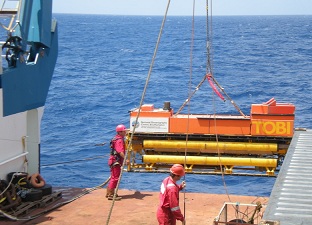
TOBI continued in service, with some updates, until 2013; you can read about its use during a 2010 expedition here.
⚓ 1 September 1985: First pictures of seafloor wreckage from RMS Titanic, found by the Argo camera sled at ~3800 metres deep, ~600 km off the coast of Newfoundland. Expedition leader Bob Ballard describes the discovery in this talk:
🦑 July 1985: Discovery of the first "black smoker" hydrothermal vents on the Mid-Atlantic Ridge: the "TAG" hydrothermal mound at 26 degrees North and ~3.6 km depth.
🔧 1987: Construction of the Mir Human-Occupied Vehicles in Finland for the Soviet Union, capable of reaching 6000 metres deep with a crew of three people. Two Mir submersibles entered service with the PP Shirshov Institute of Oceanology, Russian Academy of Sciences, operating from the RV Akademik Mstislav Keldysh.
🌎 1987: Start of the international JGOFS (Joint Global Ocean Flux Study) research programme, involving scientists from 20 nations to investigate the flow of carbon between the atmosphere, surface ocean, and deep sea.
🦑 10 November 1987: Alvin dive 1949, with Rob Wheatcroft, RH Pope, and pilot Paul Tibbetts, encountered a whale-fall and its associated deep-sea life at ~1240 m deep Santa Catalina basin - the first deep-sea whale-fall community studied in situ.
🔧 2 March 1988: Six divers - Serge Icart, Jean-Guy Marcel-Auda, Thierry Arnold, Regis Peilho, Patrick Raude, Louis Schneider - began working in the Mediterranean at 520 to 534 metres deep - the deepest humans have ever dived with unprotected bodies in the ocean.
🔧 1988: First launch of the Jason Remotely Operated Vehicle, built by Woods Hole Oceanographic Institution as an ROV for science. Although scientists were initially wary of using the new technology for hard-won research grants, the ROV gradually gained converts with its capability to provide more "bottom time" than a Human-Occupied Vehicle during an expedition, flexibility in its scientific payload, and ability to involve more scientists in dive operations from its shipboard control centre.
📣 9 August 1989: The movie The Abyss, directed by James Cameron, was released. The plot featured a non-terrestrial intelligence in the deep ocean, and the film was nominated for four Oscars in 1990, winning one for best visual effects.
⛏ 1989: The DISCOL (DISturbance and reCOLonisation) experiment simulates impacts of manganese nodule mining on the ocean floor, by towing a "plough-harrow" apparatus along 78 tracks at ~4100 metres deep in the Peru Basin. To evaluate how long the seafloor takes to recover, the experimentally disturbed site is revisited after six months, 3 years, 7 years, and 26 years.
👤 1990: Dr Cindy Lee Van Dover qualified as the first female pilot of DSV Alvin, and then completed 48 dives as pilot-in-command (in addition to many more dives aboard Alvin and other submersibles as a scientist).
On 6 December 1990, Dr Van Dover piloted the first all-female deep-sea submersible dive, with scientists Dr Cynthia Huggett and Dr Elana Leithold aboard, to 640 metres deep at the Fieberling Guyot.
🔧 1990: Japan's Shinkai 6500 Human-Occupied Vehicle entered service, capable of working down to 6500 metres deep with a crew of three people. The sub's capability therefore surpassed the 6000 metre ratings of the US Navy's DSV Sea Cliff, French Nautile, and Soviet Mirs, making it the deepest-diving HOV in service.
🌎 1990: Start of the field programme for WOCE (the World Ocean Circulation Experiment), a coordinated effort of "thousands of people in dozens of countries" to understand the role of the ocean in the climate system. WOCE involved expeditions by research ships, data from satellites, drifting buoys and floats, and moored instruments, in a field programme that ran until 1998 and a modelling phase that continued until 2002.
WOCE was a watershed in the history of oceanography, and it is difficult to envision any similar progam being carried out ever again: with WOCE, the era of pure exploration of the fluid ocean largely ended... We are now in an era where spatial scales ranging from millimeters to 10,000 km, and global-scale temporal variations of days to decades, have been measured. Not all such scales have been measured in all geographical regions, but there is no longer a "mare incognita" of the same extent.
👤 21 April 1991: Dr Dawn Wright became the first African-American woman to dive in DSV Alvin, exploring the East Pacific Rise at ~2500 metres deep during Alvin dive #2370.

In July 2022, Dr Wright became the first person of African-descent to dive to Challenger Deep, the deepest point in the ocean, aboard the DSV Limiting Factor.
🏛️ 1992: Formal initiation of InterRidge, the international organisation promoting cooperation in research at mid-ocean ridges. InterRidge provides a forum for scientists from different nations to develop plans for research programmes, covering all fields from geology to biology and engineering, and coordinate assets such as ships and submersibles for work at mid-ocean ridges.
🔧 🌎 10 August 1992: Launch of the TOPEX/Poseidon satellite, equipped with a radar altimeter and other instruments that provided the first continuous global coverage of the surface features of the oceans, enabling oceanographers to map global tides, monitor sea level, study seasonal changes in currents, measure heat stored in the upper ocean, and deduce large-scale feature of the ocean floor from variations in the "marine geoid".
TOPEX/Poseidon was a joint satellite mission between NASA and France's CNES space agency, launched by an Ariane-4 rocket. The satellite transmitted data from more than 62,000 orbits of the Earth until 2005, and was eventually switched off in 2008. From 2001 onwards, however, it operated in tandem with the Jason-1 satellite launched in that year, increasing coverage and resolution of ocean features from space.
🔧 24 November 1992: Theo Mavrostomos reached simulated depth of 701 metres in a pressure chamber for the COMEX Hydra 10 experiment, breathing hydroheliox - the greatest depth endured by an unprotected human body.
📣 12 September 1993: NBC television broadcast the first episode of the sci-fi series SeaQuest DSV, which ran for three seasons. The series was initially set in the year 2018, and the first season featured a short sequence at the end of each episode from ocean explorer Dr Bob Ballard - veteran of Project FAMOUS, the 1977 discovery of hydrothermal vents, and discovery of the Titanic - sharing some of the science behind the show.
🔧 1993: An expedition led by Bob Ballard to hydrothermal vents in the Guaymas Basin live-streamed video from the Jason ROV to scientists ashore via satellite, enabling them to be involved in dives.
⛏ 1993: The DOMES impact experiment simulates the impacts of manganese nodule mining by dragging a "benthic disturber" apparatus, designed to mimic seafloor-crawling mining machines, along 49 tows in the in the Clarion-Clipperton Zone of the eastern Pacific.
⚖️ 🏛️ ⛏ 1994: The United Nations Convention on the Law of the Sea (UNCLOS) came into force, and through it the creation of the International Seabed Authority as the organisation to administer future deep-sea mining in areas beyond national jurisdictions, and ensure that benefits from those ocean resources are shared as "the common heritage of mankind" specified in UNCLOS.
⚖️ 20 February 1994: Total prohibition of ocean dumping of radioactive waste, including low-level, came into force.
⚓ 26 August 1994: The RV Akademik Mstislav Keldysh set out from Southampton, UK, to start the British-Russian Atlantic Vents Expedition 1994 (BRAVEX/94), investigating hydrothermal vents on the Mid-Atlantic Ridge with the Mir human-occupied vehicles.
🔧 🦑 24 March 1995: Japan's remotely operated vehicle (ROV) Kaiko became the second vehicle to reach the ocean's deepest point, the Challenger Deep of the Mariana Trench, and set a record for the deepest dive by an uncrewed underwater vehicle.
🔧 🌎 1995: Woods Hole Oceanographic Institution launched ABE (Autonomous Benthic Explorer), an Autonomous Underwater Vehicle (AUV) capable of mapping the ocean floor in detail, surveying for hydrothermal vents, and photographing the seabed.
ABE completed 221 missions, including finding new hydrothermal vent fields in the South Atlantic and Southwest Indian Ocean, but was lost on 5 March 2010 while surveying the mid-ocean ridge at the Chile Triple Junction.
🔧 1996: The world's then-largest Autonomous Underwater Vehicle (built by Canadian engineers and almost 12 metres long) successfully laid a fibre-optic cable beneath areas of permanent ice cover in the Arctic Ocean. The Theseus AUV was designed to lay the connection to to an underwater sonar array, codenamed Spinnaker, that could listen out for Russian submarines in the Arctic.
To enable completion of the connection, an acoustic homing system guided Theseus to thread the cable through a "saddle" just 200 metres wide, after an autonomous underwater journey of 180 kilometres. Bruce Butler, who was one of the team involved, talked to the Underwater Technology Podcast about the project in 2020 (and has published a book about it: Into The Labyrinth).
🔧 📣 1996: Submersible designer Graham Hawkes trialed his Deep Flight 1 Human-Occupied Vehicle in Monterey Bay. Unlike conventional HOVs, the Deep Flight series "fly" underwater. Footage of Deep Flight 1 featured in the title sequence of the TV series Star Trek: Enterprise.
⚓ 28 November 1996: UK survey and salvage company Blue Water Recoveries Ltd discovered the wreck of the SS Rio Grande, a World War II blockade runner, at a depth of 5762 metres in the south Atlantic. The discovery of the wreck, using sidescan sonar, set a record for the deepest known shipwreck (until the discovery of the wreck of the USS Johnston in 2019).
🏛️ 🦑 1997: First international Symposium on Hydrothermal Vent Biology held in Madiera. This became a regular series of conferences, held every four years, expanding to become the International Symposium on Chemosynthesis-Based Ecosystems.
🌎 1997: Walter Smith and David Sandwell of Scripps Oceanographic Institution published a "gravity-derived" map of the entire ocean floor created from TOPEX/Poseidon satellite data, which showed seafloor features as small as 20 km across.
🦑 1997: An estimated 2280 blue whales remained in the population around South Georgia, after more than 42,000 had been killed there by whalers during the 20th century.
🔧 🌎 1 August 1997 Launch of SeaWIFS (Sea-Viewing WIde Field-of-view Sensor) aboard the SeaStar satellite. SeaWIFS mapped chlorophyll concentrations of the ocean surface at 4 km resolution during its mission that lasted until December 2010.
🔧 1997: The UK began its Autosub Science Missions programme, using the Autosub Autonomous Underwater Vehicle (AUV); Autosub-2 was powered by 5500 alkaline D-cell batteries, providing a range of ~1000 km or 8 days endurance to study ocean features such as temperature, salinity, currents, and seafloor and sea ice topography.
🔧 1998: The US Navy retired DSV Sea Cliff and DSV Turtle from active service. Sea Cliff was eventually transferred to Woods Hole Oceanographic Institution for possible use in further development of sister sub DSV Alvin.
🦑 20 May 1998: ROV Kaiko filmed plastic rubbish at 10,898 metres deep in the Mariana Trench; video of the rubbish on the seafloor is available here in the JAMSTEC E-library of Deep-Sea Images.
🔧 1999: The Victor 6000 Remotely Operated Vehicle entered service with L'Institut Français de Recherche pour l'Exploitation de la Mer (Ifermer).
🌎 🔧 2000: Scientists deployed the first Argo floats to the monitor the ocean. The battery-powered floats sink into the ocean and drift in its currents, rising to the surface every 10 days or so to measure ocean conditions such as temperature and salinity at different depths. The floats transmit their data to shore via satellite when they surface, before sinking back down to continue drifting at depth. Each float can typically last for 4 to 5 years before it needs to be recovered and replaced.
The goal of the Argo project was to deploy and maintain a network of ~3,200 Argo floats around the world's ocean, to provide near real-time measurements of ocean circulation and conditions in the upper 2000 metres of the ocean, in far greater detail than occasional surveys by ships can achieve.
🦑 August 2000: Discovery of the first hydrothermal vents in the Indian Ocean. The Kairei vent field was discovered on the Central Indian Ridge at ~2.4 km deep by Japanese expeditions, followed by the nearby Edmond vent field at 3.2 km deep, which was explored by a US expedition.
⚖️ ⛏ 2001: The UN International Seabed Authority approved the first licences for deep-sea mineral exploration on the ocean floor beyond national jurisdiction, awarding six 15-year contracts to explore manganese nodules in the eastern Pacific, to contractors representing countries including Russia, Korea, China, France and Japan.
📣 12 September 2001: Broadcast of the first episode of the Blue Planet documentary series, produced over four years by the BBC Natural History Unit. The first episode was watched by 12 million viewers in the UK, and the series was subsequently broadcast in 50 countries.
🔧 2002: The Jason Remotely Operated Vehicle for science was replaced by Jason 2, also built by Woods Hole Oceanographic Institution, capable of working down to 6500 metres deep.
Woods Hole also built a second vehicle of the same design for the UK, which became the Isis ROV - the UK's first deep-diving science vehicle, delivered in 2003.
🔧 🌎 2003: The Ocean Drilling Program (ODP) expanded to become the Integrated Ocean Drilling Program (IODP), involving 26 countries to investigate the structure of the seafloor using the new Japanese deep-sea drilling ship Chikyu in addition to the JOIDES Resolution.
IODP completed 54 expeditions by 2013, when the program then became the "International Ocean Discovery Program: Exploring the Earth Under the Sea".
👤 13 March 2003: Dive 733 of the Shinkai6500 Human-Occupied Vehicle took Dr Mamoru Mohri to 6450 metres deep in the Ryukyu Trench; Dr Mohri had previously flown aboard the Space Shuttle Endeavour in 1992 and 2000, and may therefore be the first confirmed "bathy-astronaut" - a person who has been into space and the deep ocean.
🔧 29 May 2003: Remotely Operated Vehicle (ROV) Kaiko, which had previously dived to Challenger Deep in the Mariana Trench, was lost on its 296th dive as Typhoon Chan-Hom closed in towards the research ship RV Kairei.
⚓ 🦑 May 2004: The yacht Sorceror II, owned by scientist J. Craig Venter who previously led the first draft sequence of the human genome, departed from Halifax in Canada to begin the Global Ocean Sampling Expedition. The expedition sequenced the DNA of ocean microbes around the world, completing its journey in January 2006.
🌎 🔧 2004: Scientists installed a series of moorings, carrying monitoring instruments and known as the RAPID array, between Florida and Morocco. The instrument moorings measure ocean currents, including the Gulf Stream, that form the circulation of the North Atlantic.
The moorings have remained active since their installation to measure changes in circulation over time, and data from them are available here.
📣 2004: Frank Schätzing published his novel Der Schwarm (The Swarm), about an undersea intelligence attacking humanity to prevent further damage to the ocean.
🦑 30 September 2004: First photographs of a live giant squid (Architeuthis dux) in the deep sea were snapped by a baited camera system at 900 m deep near the Ogasawara Islands in the North Pacific
🔧 🌎 13 February 2005: The UK's Autosub-2 Autonomous Underwater Vehicle completed the first successful AUV mission beneath a polar ice shelf, at the Fimbul Ice Shelf in the Antarctic.
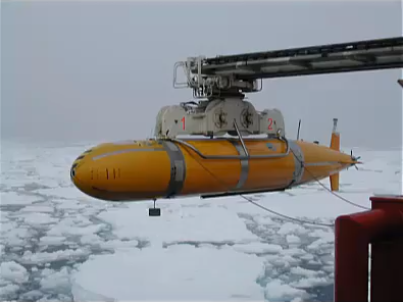
Unlike sea ice, which is frozen seawater only a few metres thick, ice shelves are the floating extensions of glaciers, several hundred metres thick and covering cavities of ocean several hundred metres deep and extending several hundred kilometres from open ocean, making their interior inaccessible to Remotely Operated Vehicles (ROVs) or Human-Occupied Vehicles (HOVs) from research ships.
📣 2005: 3D IMAX documentary film Aliens Of The Deep, directed by James Cameron and Steven Quayle, featured footage from dives to hydrothermal vents with the Deep Rover 2 and Mir Human-Occupied Vehicles, speculating about hydrothermal origins of life and possible analogues on Jupiter's moon Europa.
⚓ ⚖️ 2 August 2007: Russia's two Mir Human-Occupied Vehicles dived to the ocean floor at 4261 metres deep beneath the North Pole, carrying a Russian flag there.
Although the flag-planting was not intended as a territorial claim (similar to a climber carrying their country's flag to celebrate the first ascent of a peak), the dives took place during an expedition that also collected geological evidence for the case required by the United Nations to extend Russia's rights to seafloor resources in the Arctic.
🔧 3 June 2008: Japan's ABISMO Remotely Operated Vehicle (ROV) system completed a successful test dive to 10,258 metres deep in the Mariana Trench.
🦑 July 2008: Discovery of "black smoker" hydrothermal vents on the Arctic Mid-Ocean Ridge, at 79 degrees North. Life at these vents differs to that found at vents on the Mid-Atlantic Ridge south of Iceland, with a species of tubeworm previously found at cold seeps, and large amphipod crustaceans, but no vent shrimp.
🦑 📣 5 August 2008: Prof Ken Takai of the Japan Agency for Marine-Earth Science and Technology (JAMSTEC) and colleagues published a paper showing that microbes from deep-sea hydrothermal vents can survive and reproduce at a temperature of 122 degrees C - setting a new record for observed thermotolerance of an organism (and that record still stands at the time of writing this).
⚖️ 6 January 2009: The US, under President George W. Bush, established several Marine Protected Areas around US island territories in the Pacific:
- the Pacific Remote Islands Marine National Monument
- the Marianas Trench Marine National Monument
- the Rose Atoll Marine National Monument
...having previously also established the Papahānaumokuākea Marine National Monument around Hawai'i in 2006.
🦑 9 February 2009: Using a towed camera system, Voyage 224 of the RRS James Clark Ross obtained the first pictures of the southernmost known "black smoker" hydrothermal vents, at ~60 degrees South and a depth of 2.4 km near the South Sandwich Islands.
🔧 30 May 2009: Hybrid remotely operated vehicle / autonomous underwater vehicle (HROV) Nereus became the third vehicle to dive to the Challenger Deep of the Mariana Trench.
🌎 1 June 2009: Air France flight AF447 crashed into the Atlantic ocean, above the flanks of the Mid-Atlantic Ridge, during a flight from Rio de Janiero to Paris. The search for the sunken wreckage of the aircraft involved several deep-diving Autonomous Underwater Vehicles (AUVs), which used sonar to map more than 6300 square km of ocean floor at high resolution. The debris field from the aircraft was found in April 2011, at a depth of 3980 metres, enabling a Remotely Operated Vehcile (ROV) to recover the flight recorder for investigation.
⚓ 🦑 September 2009: The schooner Tara, owned by fashion house CEO Étienne Bourgois, departed from Lorient in France at the start of a round-the-world scientific expedition that would last until 2013.
Led by Eric Karsenti, the Tara Oceans Expedition analysed DNA from planktonic lifeforms ranging in size from viruses to fish larvae, at 210 locations around the world, collecting samples from the surface down to 1000 metres deep.
⚖️ 🦑 2009: Agreement of the world's first "High Seas" (beyond boundaries of national jurisdiction) Marine Protected Area (MPA), around the South Orkney Islands near Antactica, following a UK proposal to the Commission for the Conservation of Antarctic Living Marine Resources (CCAMLR). The South Orkney MPA covers 94,000 square kilometres and came into operation in May 2010, as the first in a network of Marine Protected Areas around Antarctica gradually introduced by CCAMLR.
⚓ 🌎 9 January 2010 End of the first expedition for GEOTRACES, an international research project investigating the role of trace metals in the biogeochemical cycles of the ocean. GEOTRACES involves scientists in more than 30 countries, with a decade-long field programme of expeditions through different oceans.
⚖️ 1 April 2010: The UK established the Chagos Marine Protected Area, covering 640,000 square kilometres - the area of the Exclusive Economic Zone - around the Chagos Islands in the Indian Ocean.
🦑 6 April 2010: Voyage 44 of the RRS James Cook revealed the world's deepest known hydrothermal vents, ~5 km (3.1 miles) down in the Cayman Trough of the Caribbean.
⚖️ 20 April 2010: The Deepwater Horizon semi-submersible drilling platform suffered a blow-out while drilling a new well for oil and gas in the Gulf of Mexico, resulting an an explosion that killed 11 people and sank the platform. An estimated 780 million litres of oil spilled from the well-head at a depth of 1.5 km on the seafloor, until it was capped 86 days later.
📣 August 2010: BBC One broadcast the drama mini-series The Deep, with a plot that featured hydrothermal vents and a geopolitical scramble for deep-ocean resources in the Arctic.
🦑 🌎 September 2010: Publication of the report of the international Census of Marine Life, the culmination of a ten-year project investigating the biodiversity of the ocean and involving ~2700 scientists from 80 countries.
🌎 🦑 2010: More than 200 hydrothermal vent fields have now been seen on the ocean floor around the world, and more than 400 new species of animals have been described from deep-sea hydrothermal vents, since the discovery of vent communities in 1977.
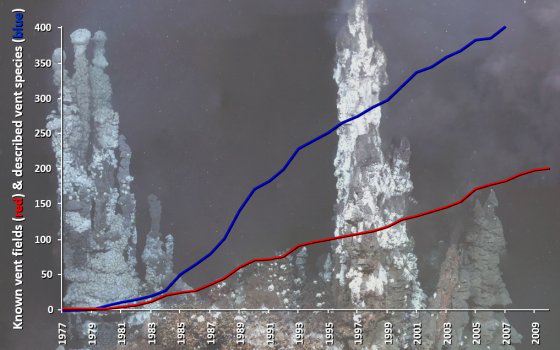
🦑 6 January 2011: Biologists attached a tag to a Cuvier’s beaked whale (Ziphius cavirostris) off the coast of southern California to record details of its dives over the next three months, and found that it made one dive to 2992 metres deep - the deepest recorded dive by a breath-holding animal.
⚖️ ⛏ 2011: The UN International Seabed Authority issued its first mineral exploration licence for "polymetallic sulfides" - the deposits that form at hydrothemrmal vents - to the China Ocean Minerals Research and Development Association (COMRA), covering ~1000 km of the mid-ocean ridge in the SW Indian Ocean. This was the first exploration licence for this type of mineral deposit, in addition to the 9 awarded by the ISA at this point for manganese nodules.
🦑 November 2011: The first Remotely Operated Vehicle (ROV) dives to hydrothermal vents 2.8 km deep on the Southwest Indian Ridge revealed marine life including six previously undescribed species of animals not yet known from any other locations in the ocean.
The ROV dives also found a population of "scaly-foot snails" at Longqi, previously known from hydrothermal vents on the Central Indian Ridge but not yet formally described as a new species. The description of the species - Chrysomallon squamiferum - was subsequently published based on specimens from the Longqi vents.
🔧 🦑 26 March 2012: James Cameron became the third person to reach the ocean's deepest point, the Challenger Deep of the Mariana Trench - and the first person to dive there alone - in his DeepSea Challenger submersible. In preparation for the Challenger Deep dive, Cameron also dived to 8228 metres deep in the New Britain Trench on 7 March 2012.
As well as making observations from the submersible, the DeepSea Challenge expedition also deployed landers in the trench, collecting seawater microbes, scavengers such as amphipod crustaceans, and indications of chemosynthetic microbial mats at >10.7 km depth.
👤 6 June 2012: Herbert Nitsch set a new record for breath-hold diving, in the "no limit" category, reaching 253 metres deep.
🔧 19 June 2012: China's Jiaolong Human-Occupied Vehicle completed a dive to 6965 metres, demonstrating its 7 km depth capability to surpass Japan's Shinkai 6500 as the deepest-diving HOV in operation at the time. Test dives of the Jiaolong, which carries a crew of three, began in 2010.
⚓ 🦑 📣 5 January 2013: The Shinkai6500 Human-Occupied Vehicle departed from Japan aboard its mothership RV Yokosuka on a round-the-world voyage called QUELLE 2013 ("Quest for the Limit of Life"), undertaking dives in the Indian Ocean, Atlantic, Caribbean, and Pacific.
🔧 📣 March 2013: Egyptian authorities arrest three divers attempting to cut a seafloor fibre-optic communication cable.
🌎 8 March 2014: Malaysia Airlines flight MH370 from Kuala Lumpur to Beijing deviated from its scheduled flightpath and disappeared, and the subsequent search focused on the southern Indian Ocean. Ships used multibeam bathymetry sonar to map areas of seafloor where only low-resolution satellite-derived maps were previously available, then enabling towed sonars and Autonomous Underwater Vehicles (AUVs) to survey areas of the seabed in much greater detail. Search operations were suspended in 2018, and the mapping data were donated to the international Seabed 2030 project.
🔧 10 May 2014: Hybrid remotely operated vehicle / autonomous underwater vehicle (HROV) Nereus, which had previously dived to the Challenger Deep of the Mariana Trench, was lost while exploring 10 km deep in the Kermadec Trench near New Zealand.
⚖️ 17 June 2014: The US, under President Barack Obama, expanded the Pacific Remote Islands Marine National Monument to cover 1.2 million square kilometres - the largest Marine Protected Area in the world.
⚖️ ⛏ July 2014: The UN International Seabed Authority approved seven further contracts to explore for deep-sea mineral resources, taking the total number of 15-year exploration licences to 18.
👤 19 September 2014: Ahmed Gabr set a new record for the deepest SCUBA dive, reaching 332 metres deep. Descent took around 15 minutes, and ascent lasted more than 13 hours, for decompression.
🌎 2014: Walter Smith and colleagues published an updated "gravity derived" map of the entire ocean floor, now showing seafloor features as small as 5 km across.
⚖️ ⛏ 2014: The UK Parliament passed the Deep Sea Mining Act 2014 - "An Act to make provision about deep sea mining" - enabling UK-registered companies and organisations to apply in future for UN International Seabed Authority exploration licences for polymetallic sulfides that form at hydrothermal vents, and cobalt-rich ferromanganese crusts on seamounts, in addition to licences for manganese nodules already covered by previous UK legislation.
⛏ December 2014: Formal creation of a Joint Venture between mining company Nautilus Minerals and a company representing the government of Papua New Guinea, to develop mining at the Solwara-1 hydrothermal vents ~1.4 km deep in the Exclusive Economic Zone of Papua New Guinea.
🔧& ⛏ 2015: Fujian Mawai Shipbuilding Ltd in China began construction of the deep-sea mining vessel designed for use by Nautilus Minerals at the Solwara-1 hydrothermal vents in the Exclusive Economic Zone of Papua New Guinea.
🌎 16 February 2016: Scientists published measurements showing that the oxygen content of the ocean has declined by more than two percent since 1960, as a result of warming waters and changes in ocean circulation to the deep.
🔧 March 2016: Drillship Maersk Venturer set a new depth record for drilling an oil well-head on the seafloor, at 3.4 km deep off the coast of Uragauy.
👤 21 July 2016: New Zealand athlete William Trubridge set a new record for breath-hold diving, in the constant weight without fins category, at 102 metres deep.
🔧 August 2016: China's Hybrid Remotely Operated Vehicle (HROV) Haidou-1 completed a dive to 10,797 metres deep in the Mariana Trench.
📣 5 September 2016: A review by scientists for the International Union for Conservation of Nature (IUCN) highlighted that 93 percent of the excess heat trapped in the atmosphere by additional greenhouse gases from industrial activity has been transferred to the ocean.
⚖️ 2016: The European Union banned bottom trawling below 800 metres deep in the Exclusive Economic Zones of its member states in the NE Atlantic, with additional protection for vulnerable marine ecosystems such as deep-sea coral reefs and sponge gardens below 400 metres deep.
🏛️ 🦑 2017: Official founding of the international Deep-Sea Biology Society.
⚖️ 2017:The UK launched its "Blue Belt" programme to create a network of Marine Protected Areas (MPAs) around several of its Overseas Territories, to help meet a UN goal of protecting 30 percent of the ocean by 2030.
🦑 May 2017: The deepest ever fish was filmed by a baited lander at 8178 metres deep in the Mariana Trench, during an expedition by the Japanese research ship Kairei. The species had yet to be formally described, and was known as the "ethereal snailfish" from previous observations at slightly shallower depths.
📣 ⚓ October-December 2017: The BBC's Blue Planet II series became the most-watched TV show of the year in the UK, with episodes reaching 14 million viewers. When broadcast in other countries, the series reached at least 200 million people worldwide, with 80 million viewers streaming the series in China. Filming for the series took four years and involved expeditions with submersibles, including the first dives to 1000 metres deep by human-occupied vehicles in the Antarctic.
⚖️ ⛏ 16 January 2018: The European Parliament passed a non-binding resolution on deep-sea mining that "calls on the Commission to encourage Member States to cease subsidising licences for mining prospecting and extraction in areas beyond national jurisdiction and issuing permits for mining of their continental shelves."
🌎 🔧 February 2018: The Argo float project had deployed 3881 operational floats around the world, monitoring currents and ocean conditions in the upper 2000 metres of the ocean.
This paper published in 2020 gives a thorough history of the development of the Argo project from 1999 to 2019.
🌎 21 February 2018: The Nippon Foundation and GEBCO (The General Bathymetry Chart of the Oceans) announced the launch of the Seabed 2030 Project, aiming to map 100 percent of the ocean floor using shipboard multibeam bathymetry systems by 2030. Compared with satellite-derived maps of the ocean floor, which provide a horizontal resolution of ~5 km, shipboard multibeam bathymetry provides a resolution ranging between 100 to 800 metres, depending on water depth.
🌎 11 April 2018: Studies of data from ocean-monitoring instrument arrays, historical oceanographic measurements, and cores of seafloor sediments, have indicated that the "Atlantic Meridional Overturning Circulation" - the main ocean circulation of the North Atlantic, of which the Gulf Stream is a part - has been getting weaker.
🔧 ⚓ 10 November 2018: China's Human-Occupied Vehicle Shenhai Longshi ("deep-sea warrior") embarked on a 121-day expedition with the research ship Tansuo-1. The expedition for the Chinese Academy of Sciences conducted 62 dives and visited 5 hydrothermal vent fields.
🌎 13 November 2018: Scientists published analysis showing that the "calcite compensation depth" - the depth beyond which calcium carbonate is not preserved in the ocean - has become ~300 metres shallower in the NE Atlantic since pre-industrial times, as a result of changes to the chemistry of the ocean from increased carbon dioxide in the atmosphere. Consequently, calcite sediments have started to dissolve in some areas where they settled previously, altering the distribution of sediment types in the deep ocean.
🔧 25 November 2018: DSV Alvin completed its 5,000-th dive, visting hydrothermal vents at ~2 km deep in the Guaymas Basin.
🦑 2018: The biennial State of World Fisheries and Aquaculture (SOFIA) report of the United Nations Food and Agriculture Organization (FAO) showed that:
- Anchoveta (Engraulis ringens) was the most fished single species in 2018, with more than 7 million tonnes landed
(the SOFIA report covering fisheries in 2018 was released in 2020, after the data for 2017/18 were collected and compiled)
⚖️ ⛏ 8 January 2019: The Environmental Audit Committee of the UK's House of Commons published the report of its inquiry into "Sustainable Seas", recommending that the UK government should do more to prevent plastic and other waste entering the ocean, revise its approach to establishing marine protected areas, and rule out future mining of active hydrothermal vents.
🔧 🌎 2019: Deep-sea drilling ship Chikyu drilled just over 3250 metres beneath the seafloor, setting a new record for the deepest hole drilled into the Earth's crust. The goal was to reach an earthquake-generating zone 5200 metres down in the crust, when the drill hole collapsed - but the new record is a long way from the 186 metre drilling record set during Project Mohole in the early 1960s.
🦑 2019: The population of western South Atlantic humpback whales is estimated to be 24,500 individuals - a recovery from an estimated 450 individuals in the mid-1950s, and around 93 percent of the estimated population in the early 1800s before widespread whaling.
🦑 2019: Researchers publish evidence that animals at the bottom of deep ocean trenches - including the amphipod crustacean Hirondella gigas from the Challenger Deep of the Mariana Trench - have microplastics in their digestive systems.
⚖️ ⛏ 2019: The UN International Seabed Authority approved further contracts for the exploration of mineral deposits on the ocean floor beyond national jurisdictions, taking the total number of contracts awarded to 30:
- 18 for manganese nodules
- 7 for polymetallic sulfides formed at hydrothermal vents
- 5 for cobalt-rich ferromanganese crusts on seamounts
🦑 ⛏ 2019: The "scaly-foot snail" Chrysomallon squamiferum became the first species from deep-sea hydrothermal vents to be listed as "Endangered" in the "Red List" of the International Union for Conservation of Nature (IUCN), because of the threat to its limited known populations from possible future deep-sea mining.
Other species of snails, and one mussel species, from hydrothermal vents in the Indian Ocean and Western Pacific were subsequently added to the IUCN "Red List" in 2019, as follows:
- "Endangered": Alviniconcha adamantis, Alviniconcha boucheti, Alviniconcha kojimi, Alviniconcha marisindica, Desbruyeresia marisindica, Ifremeria nautilei
- "Critically Endangered": Bruciella wareni, Dracogyra subfuscus, Gigantopelta aegis, Iphinopsis boucheti, Lirapex politus
- "Vulnerable": Alviniconcha hessleri, Alviniconcha strummeri, Bathymodiolus marisindicus
🔧 🦑 2019: Researchers from Woods Hole Oceanographic Institution and Monterey Bay Aquarium Research Institute successfully tested Mesobot, an Autonomous Underwater Vehicle (AUV) designed to follow mid-water animals without any direct human control (unlike a Remotely Operated Vehicle), and study them with minimal disturbance to their natural behaviour.
⚓ 🔧 🦑 28 April 2019: DSV Limiting Factor, designed by Triton submarines, became the third Human-Occupied Vehicle to visit Challenger Deep, the deepest part of the ocean at >10.9 km deep in the Mariana Trench.
DSV Limiting Factor became the first human-occupied vehicle to complete multiple dives at Challenger Deep, making four dives there, and one at the trench's Sirena Deep, also >10.7 km deep.
⚓ October 2019: The RV Petrel, operated by the philanthrophic company established by Microsoft co-founder Paul Allen, located the deepest known shipwreck at depth of ~6220 metres in the Philippine Trench.
⛏ November 2019: Mining company Nautilus Minerals, which had been preparing to mine deep-sea hydrothermal vents in the Exclusive Economic Zone of Papua New Guinea, went into bankruptcy. The company had been de-listed from the Toronto Stock Exchange in April 2019, when its CEO and four of its five directors also resigned.
As of 23 June 2020, the following people, nationalities, and Human-Occupied Vehicles have now dived more than 10 km deep in the Mariana Trench:
- Jacques Piccard [Switzerland] 1960 (bathyscaphe Trieste)
- Don Walsh [US] 1960 (bathyscaphe Trieste)
- James Cameron [Canada] 2012 (DeepSea Challenger HOV)
- Victor Vescovo [US] 2019 (DSV Limiting Factor)
- Patrick Lahey [Canada] 2019 (DSV Limiting Factor)
- Jonathan Struwe [Germany] 2019 (DSV Limiting Factor)
- John Ramsay [UK] 2019 (DSV Limiting Factor)
- Dr Alan Jamieson [Scotland] 2019 (Sirena Deep, 10.7 km depth; DSV Limiting Factor)
- Dr Kathryn Sullivan [US] 7 June 2020 (DSV Limiting Factor)
- Vanessa O'Brien [US / UK] 11 June 2020 (DSV Limiting Factor)
- John Rost [US] 14 June 2020 (DSV Limiting Factor)
- Kelly Walsh [US] 20 June 2020 (DSV Limiting Factor)
- Dr Ying-Tsong Lin [Taiwan / US] 23 June 2020 (DSV Limiting Factor)
UPDATE November 2020: China's three-person HOV Fengdouzhe ["Striver"] reached 10909 m deep at Challenger Deep on 10 November 2020, and then completed a total of 8 dives to >10 km deep in the trench from mothership Tan Suo Er Hao ["Tansuo-2"].
UPDATE March-April 2021: During a further expedition with DSV Limiting Factor, on 14 March 2021 Nicole Yamase became the first citizen of the Federated States of Micronesia to dive to Challenger Deep.
On 8 April 2021, Tim Macdonald [Australia] and Rob McCallum [New Zealand] became the first people of their respective countries to dive to Challenger Deep. Later in April, Hector Salvador [Spain] also became the deepest-diving Spanish person, diving to 10.7 km in the Sirena Deep of the Mariana Trench aboard the DSV Limiting Factor. In July 2022, Dr Dawn Wright became the first person of African-descent to dive to Challenger Deep.
The following uncrewed vehicles have now also dived to more than 10 km deep in the Mariana Trench:
- ROV Kaiko [Japan] 1995-1998
- ROV ABISMO [Japan] 2008
- HROV Nereus [US] 2009
- HROV Haidou-1 [China] 2016-2020
- AUV Vityaz-D [Russia] 8 May 2020
Beyond the Mariana Trench, the following Human-Occupied Vehicles (HOVs) and Remotely Operated Vehicles (ROVs) have dived to the bottom of other ocean trenches:
- Kurile-Kamchatka Trench: bathyscaphe Archimède, 1962 (>9.5 km depth)
- Izu-Ogasawara Trench: bathyscaphe Archimède, 1962 (9.3 km depth)
- Puerto Rico Trench: bathyscaphe Archimède, 1964 (7.3 km depth)
- Izu-Ogasawara Trench: ROV ABISMO, 2007 (>9.5 km depth)
- New Britain Trench: HOV DeepSea Challenger, 2012 (>8.2 km depth)
- Kermadec Trench: HROV Nereus, 2014 (10 km depth)
- Puerto Rico Trench: DSV Limiting Factor, December 2018 (>8.3 km depth)
- South Sandwich Trench: DSV Limiting Factor, 4 February 2019 (>7.4 km depth)
- Java Trench: DSV Limiting Factor, 5 April 2019 (>7.1 km depth)
- Tonga Trench: DSV Limiting Factor, 5 June 2019 (>10.8 km depth)
- Philippine Trench: DSV Limiting Factor, 23 March 2021 (>10 km depth)
Dr. Deo Florence Onda, along with Victor Vescovo, returns to the surface after a successful 10,045-meter deep dive in the Emden Deep in the Philippine Trench on Tuesday. (📸: DSSV Pressure Drop) pic.twitter.com/VfhoYtlSIU
- San Cristobal Trench: DSV Limiting Factor, November 2021 (>8.4 km depth)
- Santa Cruz Trench: DSV Limiting Factor, December 2021 (>9.1 km depth)
- New Hebrides Trench: DSV Limiting Factor, December 2021 (>7.7 km depth)
- Kermadec Trench: DSV Limiting Factor,December 2021 (>10 km depth)
This seems a fitting point to leave our more-than-40,000-year journey into the deep: with a well-established capability to reach the deepest parts of our planet's ocean. On 23 June 2020, the number of people who have dived more than 10 km deep in the ocean - to the bottom of the deepest trenches - overtook the number of people who have walked on the Moon.
Jon Copley, June 2020
Previous Index Next






